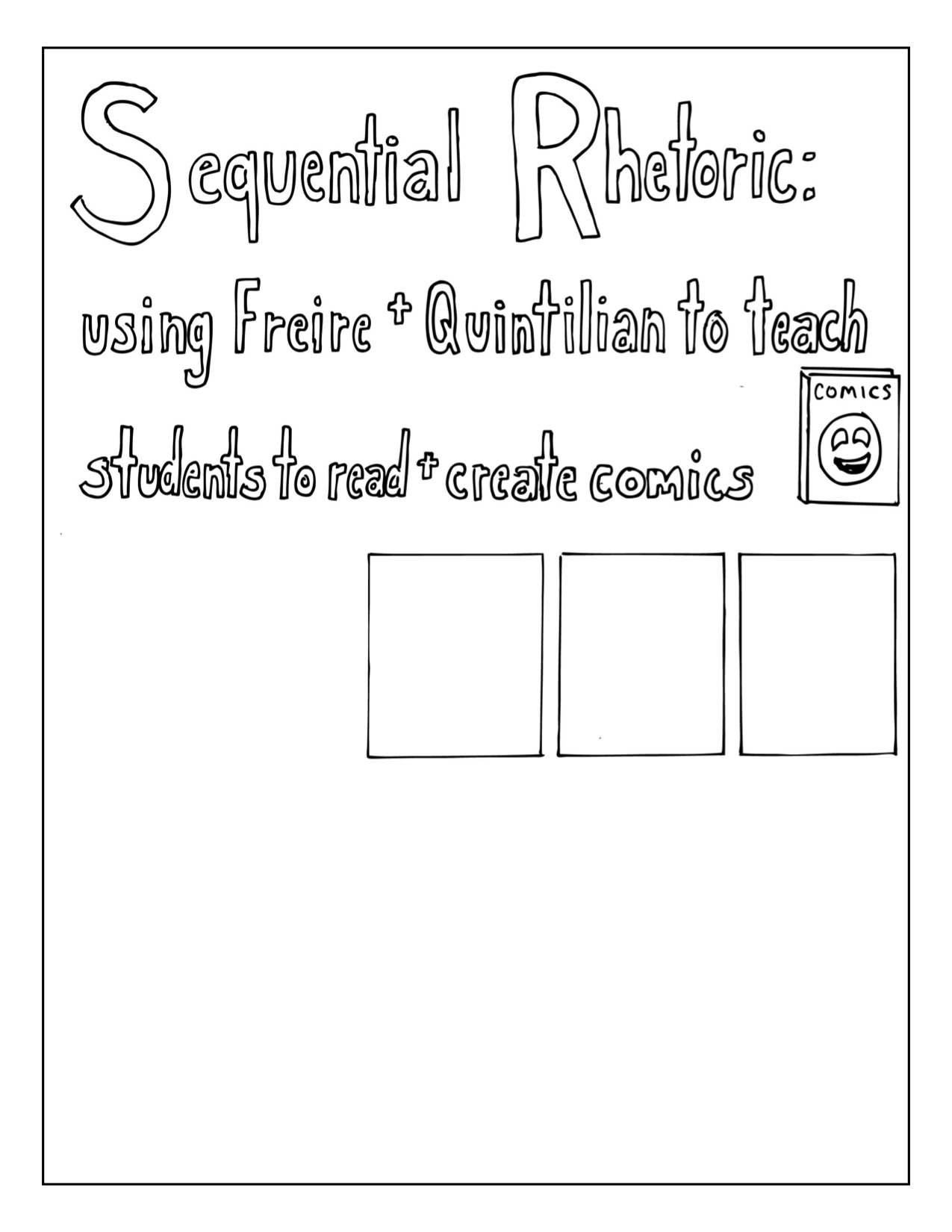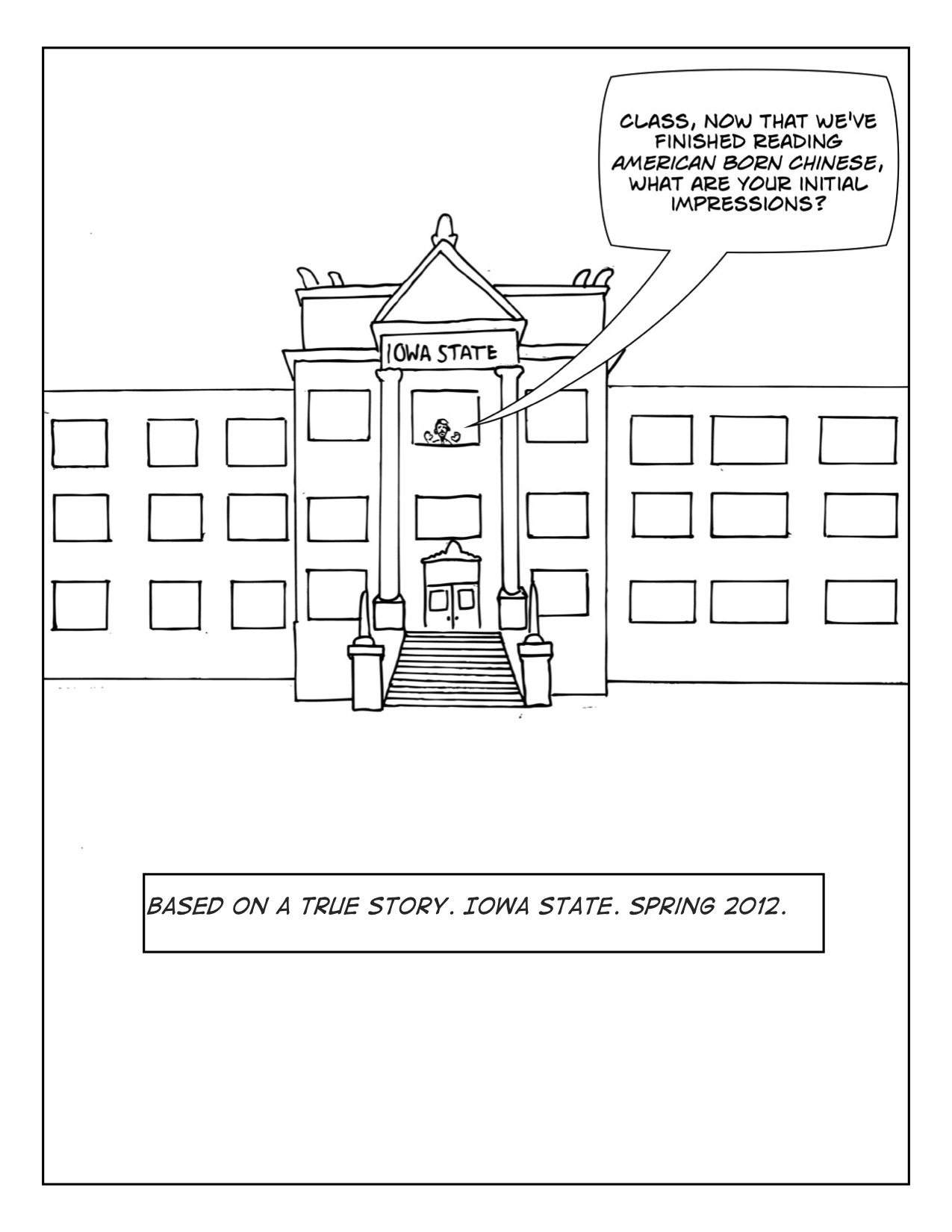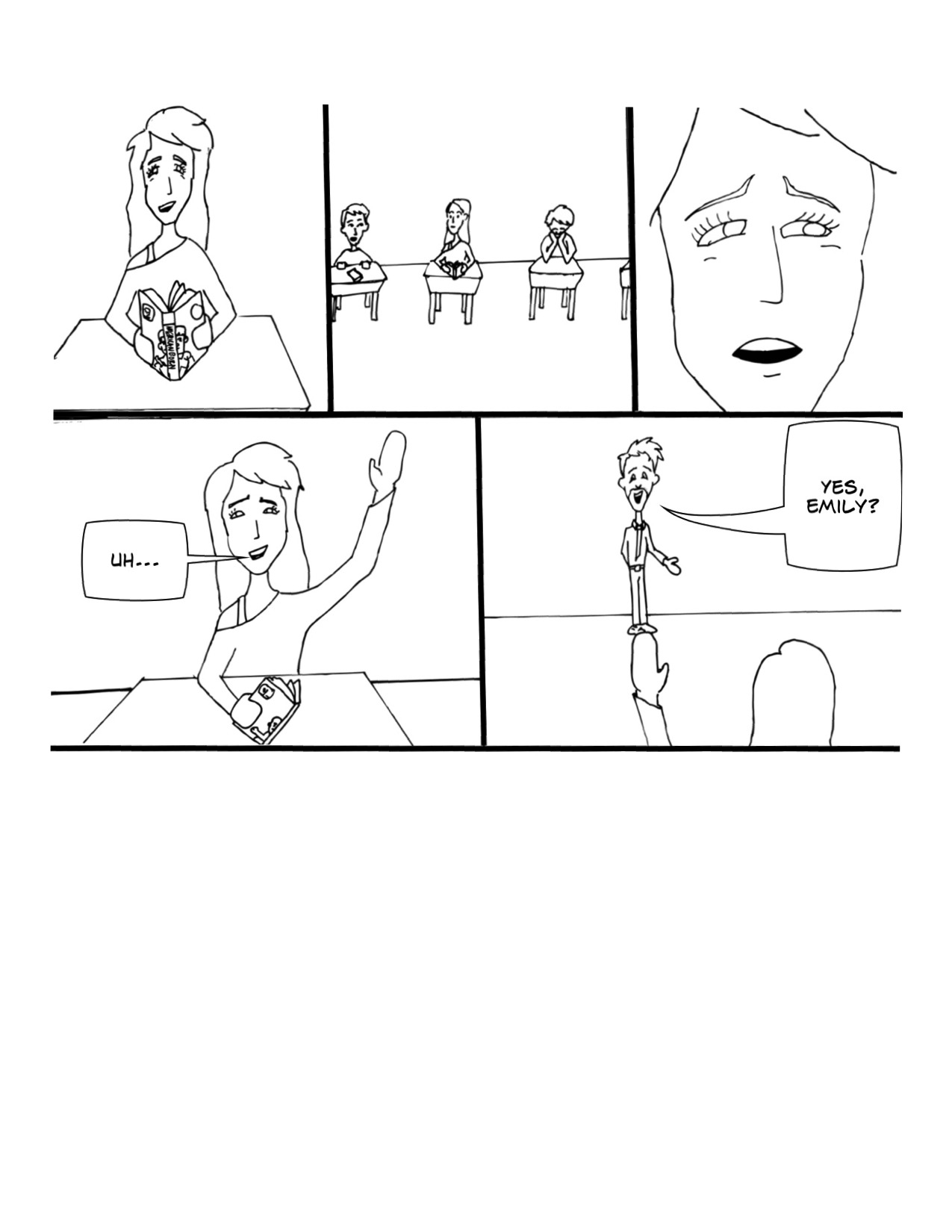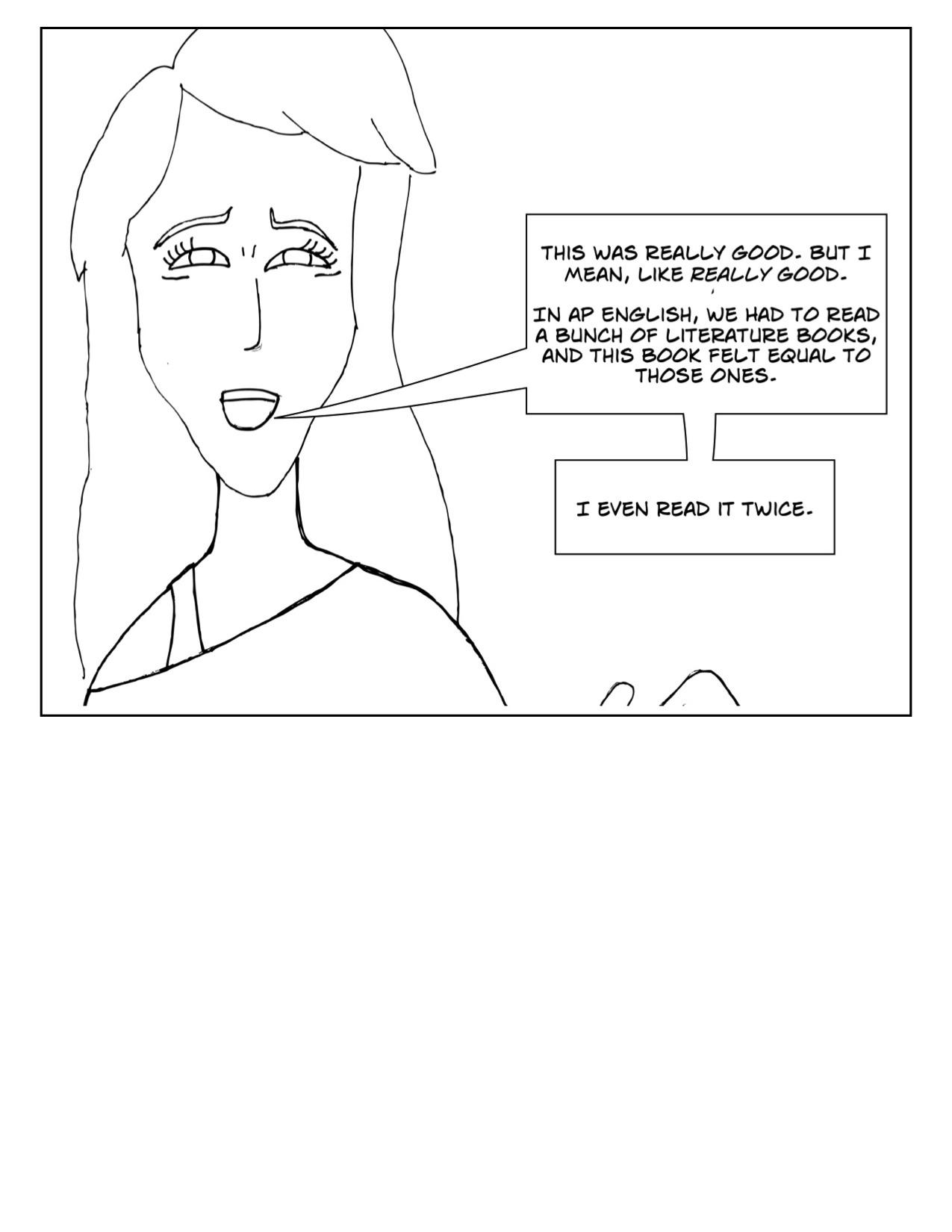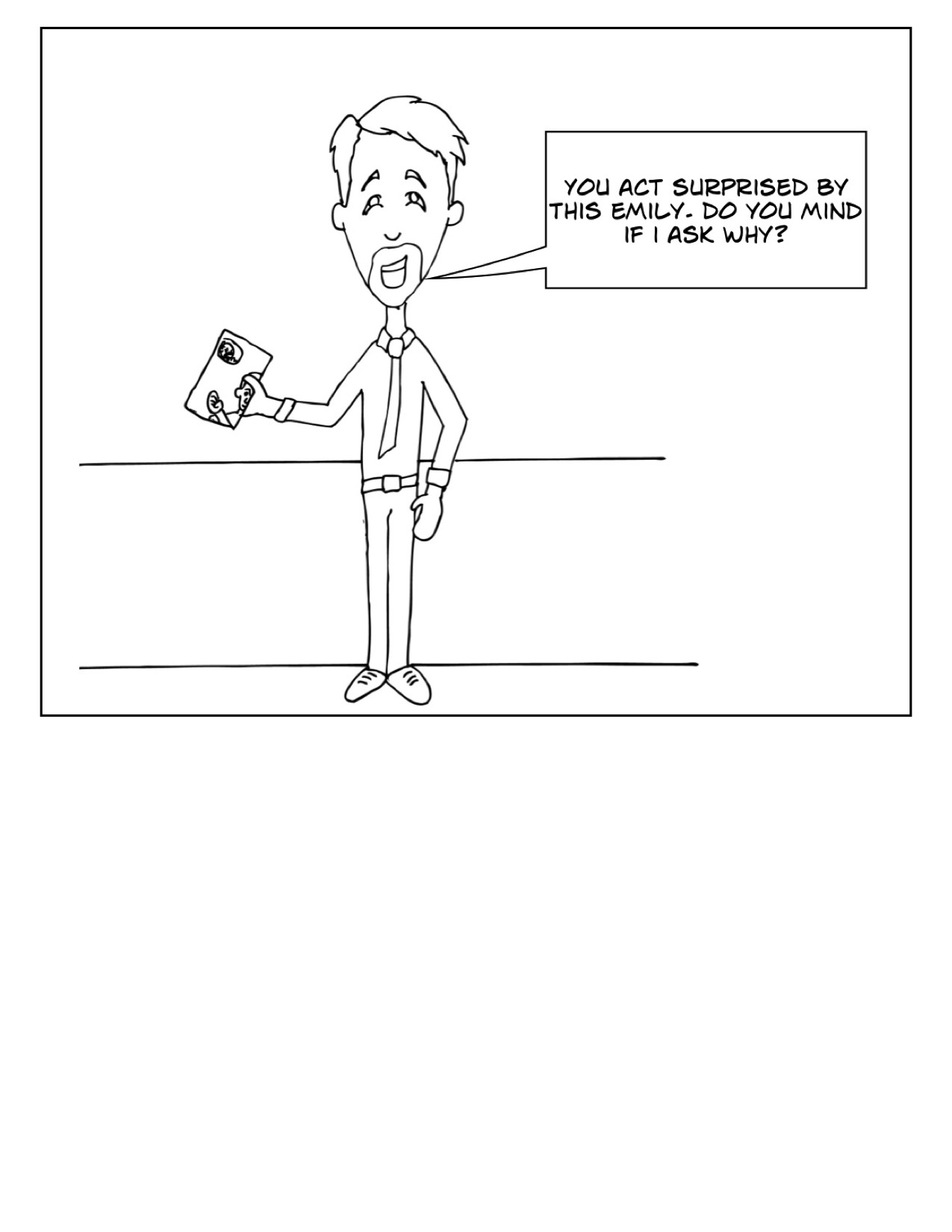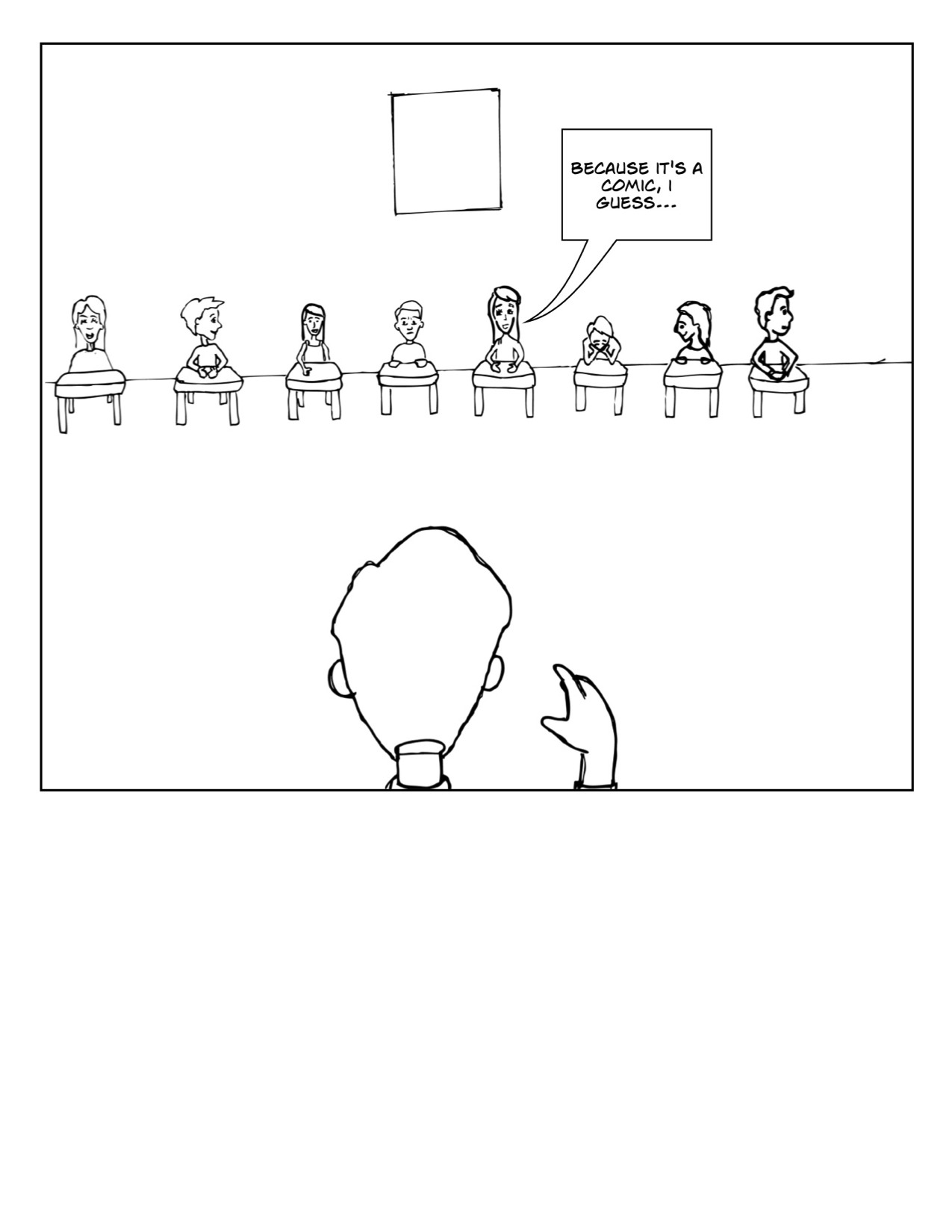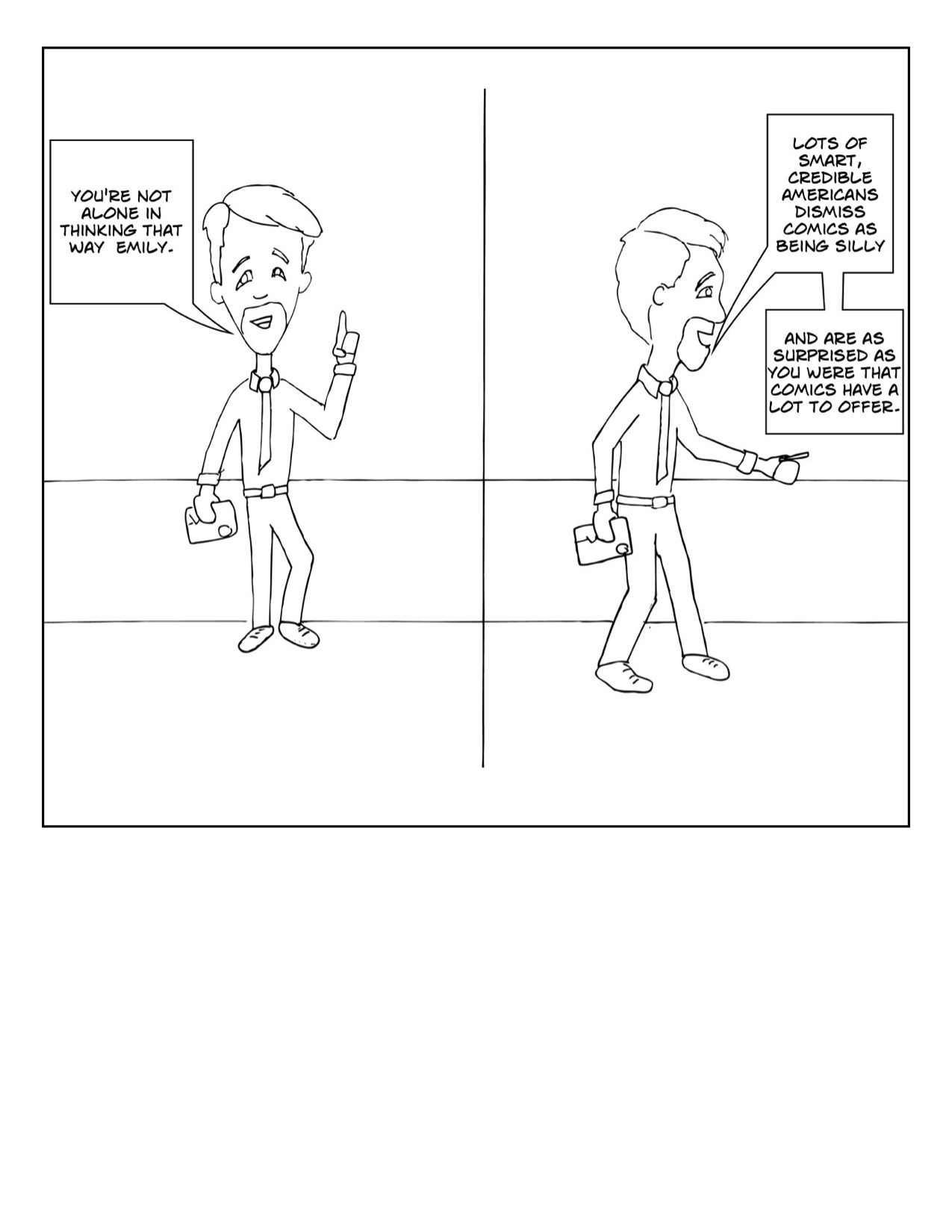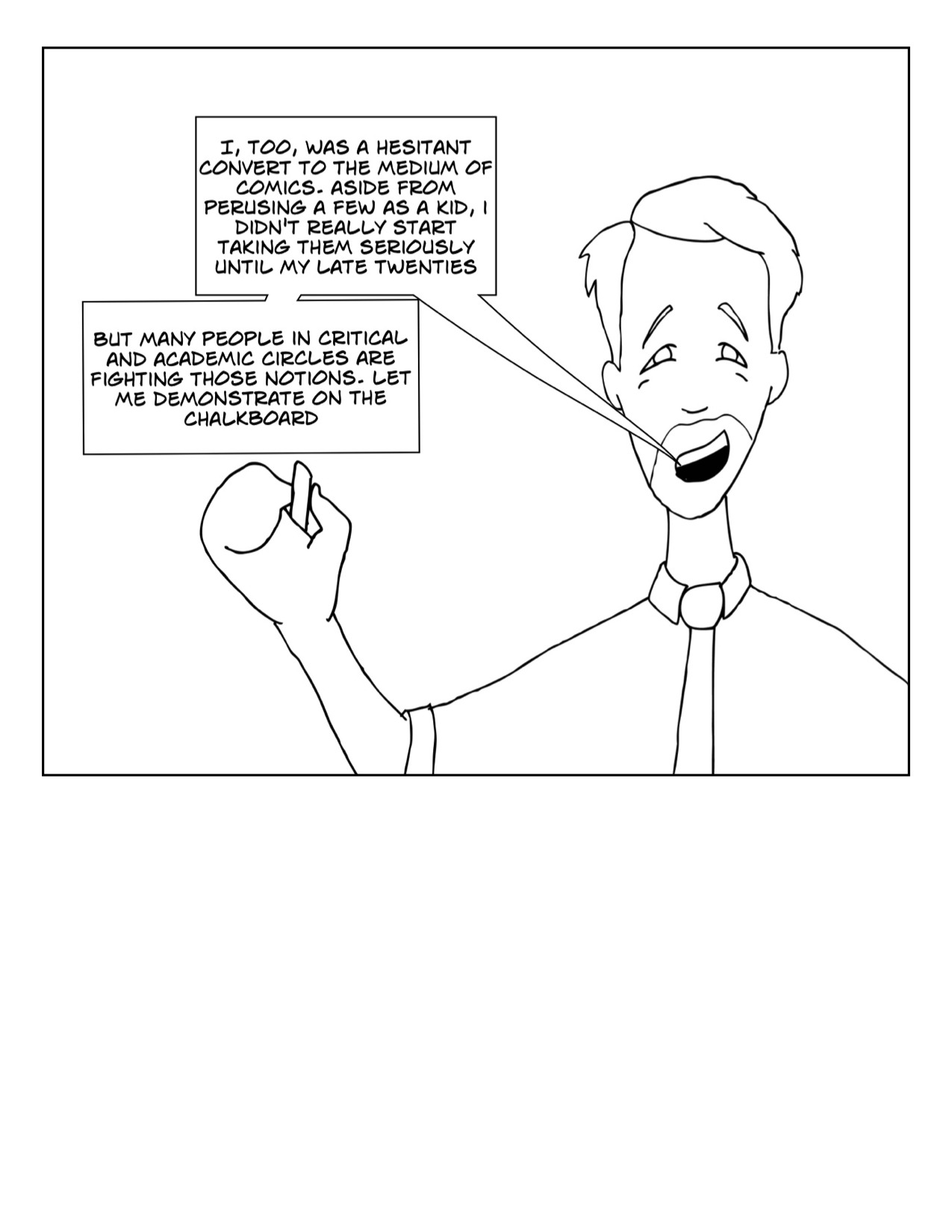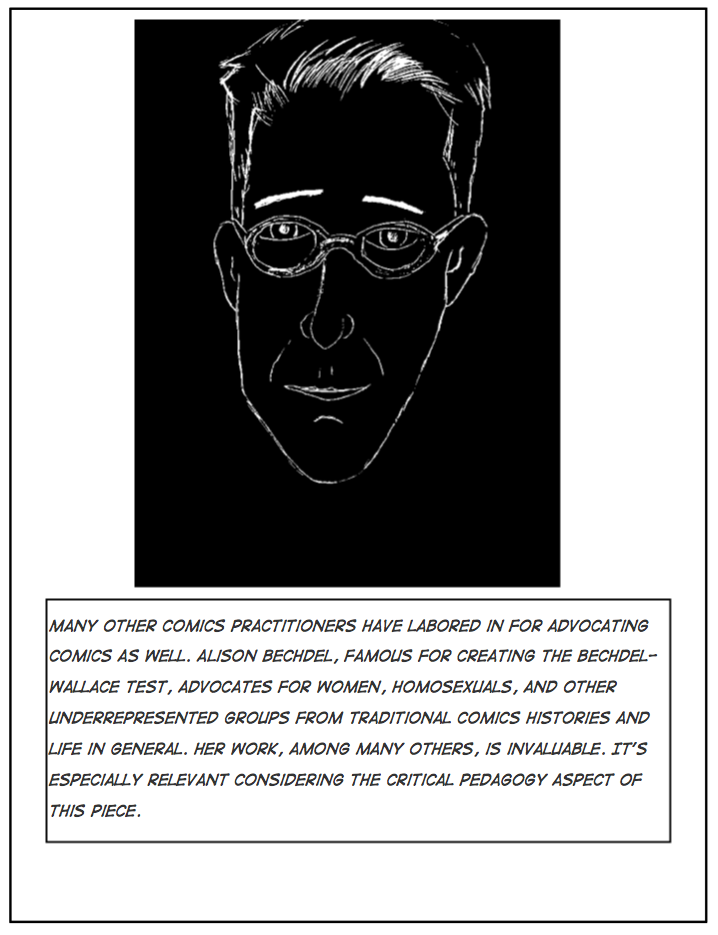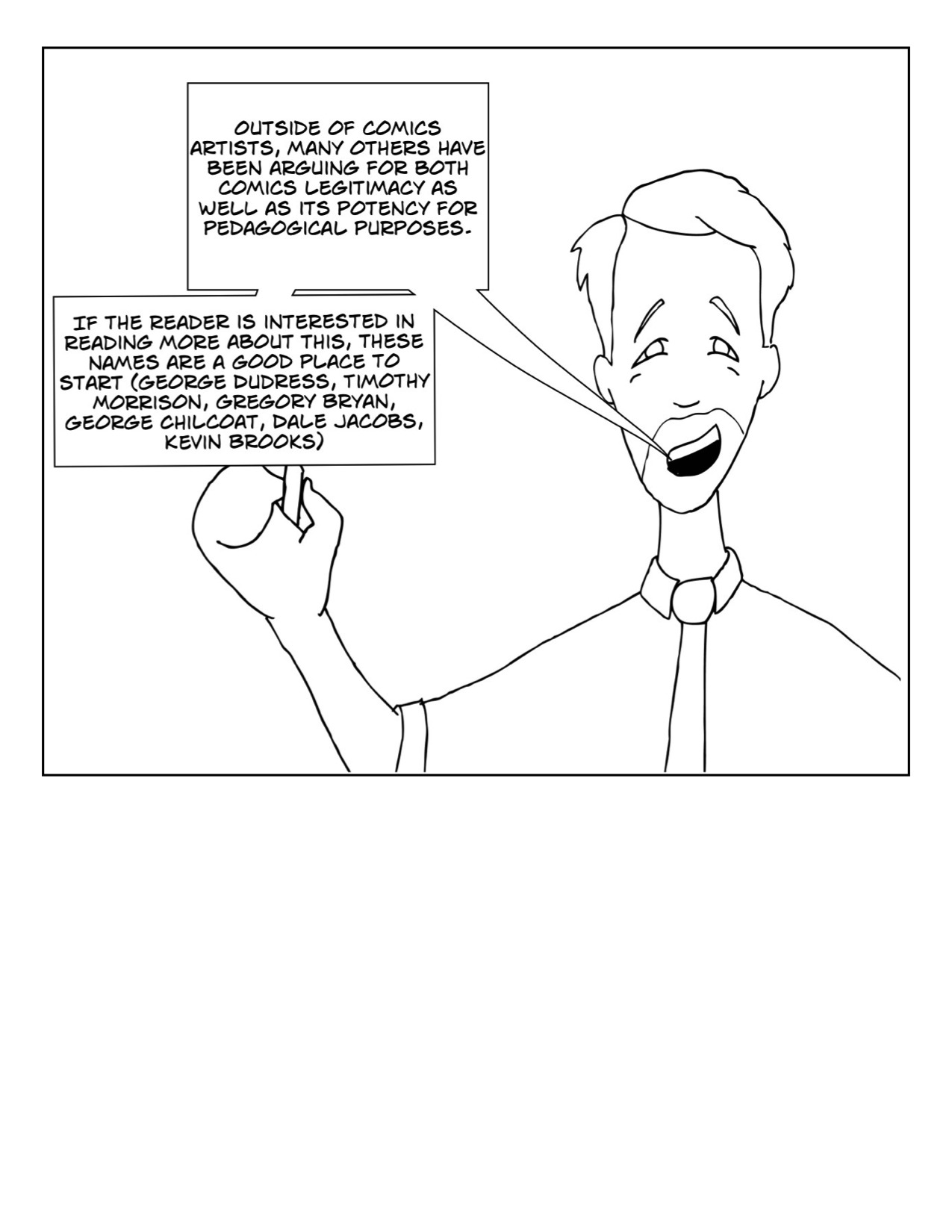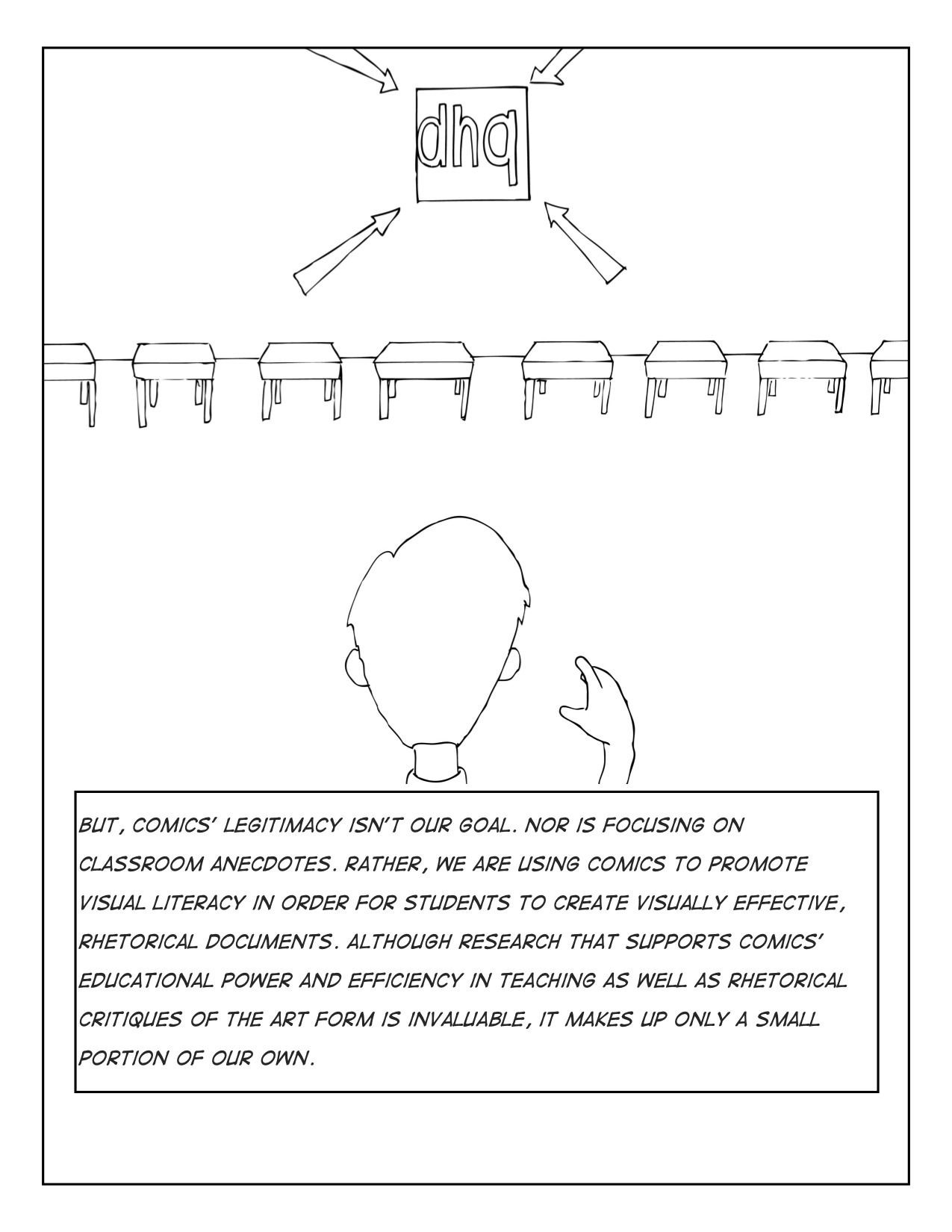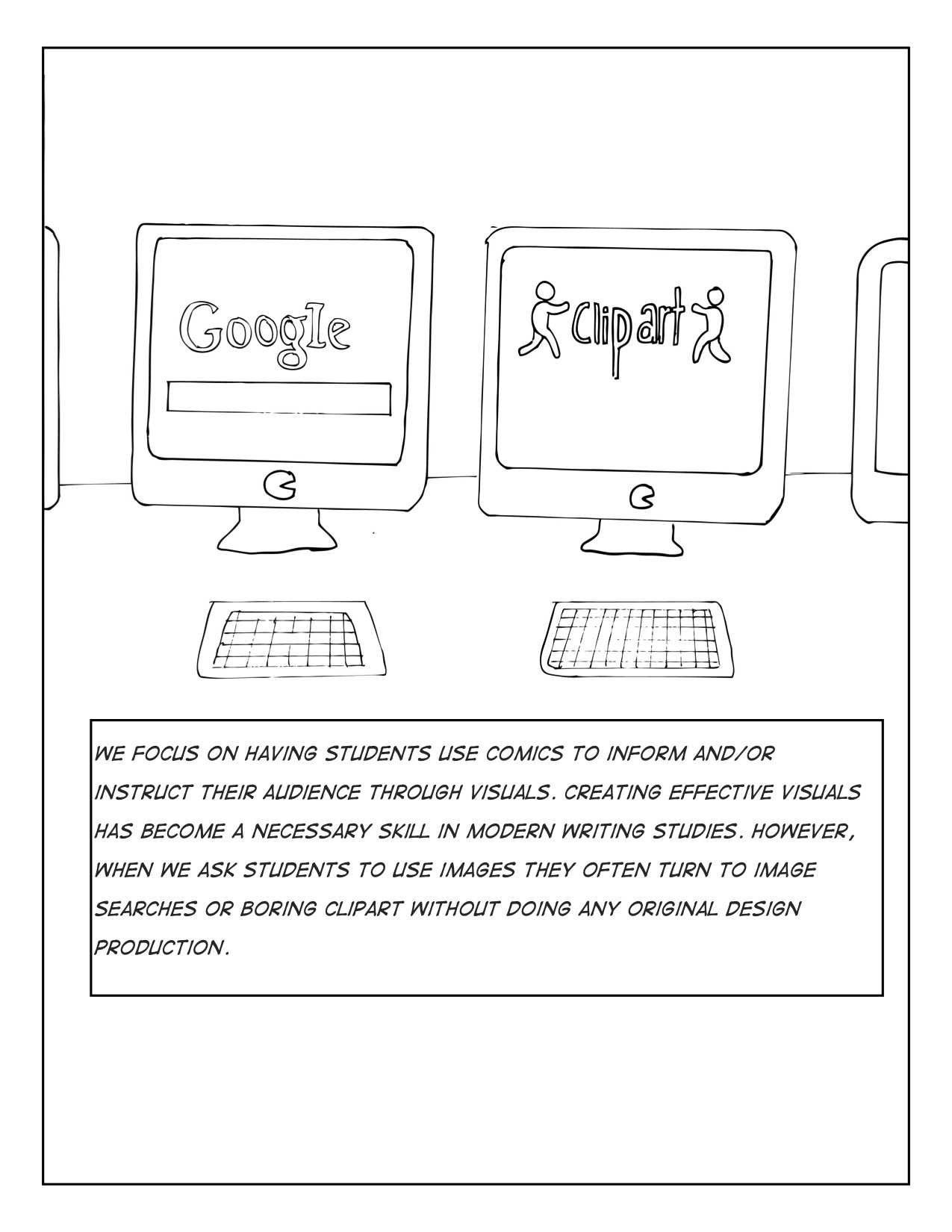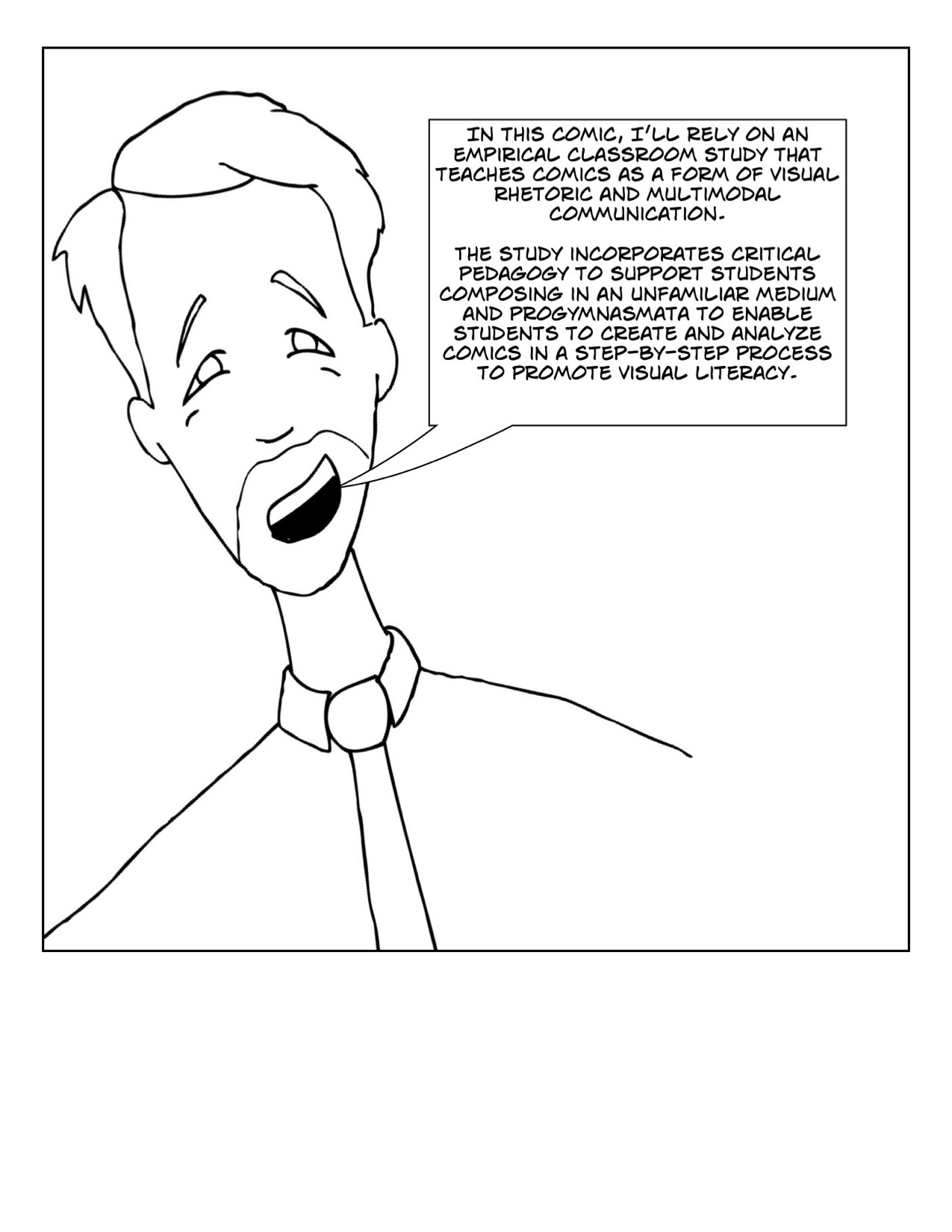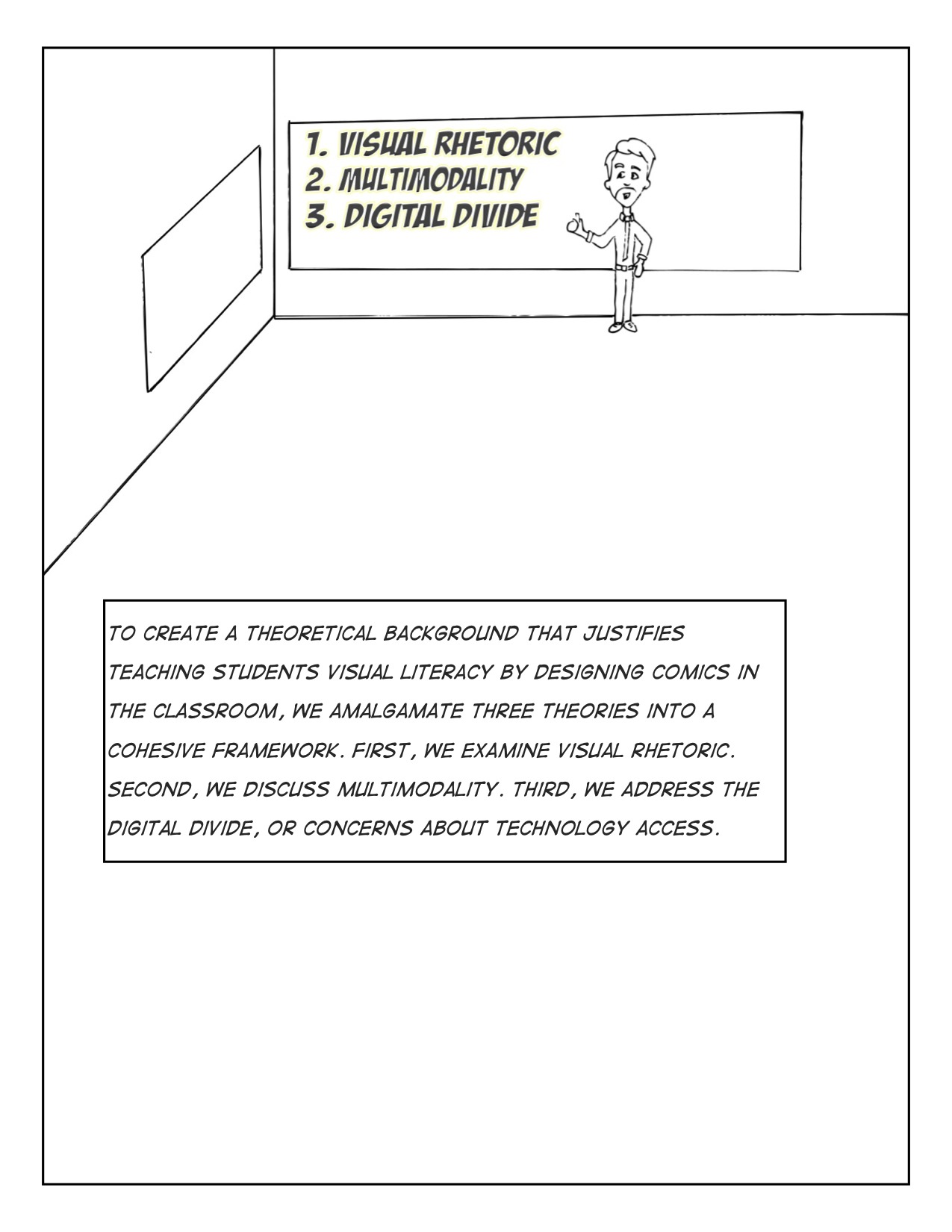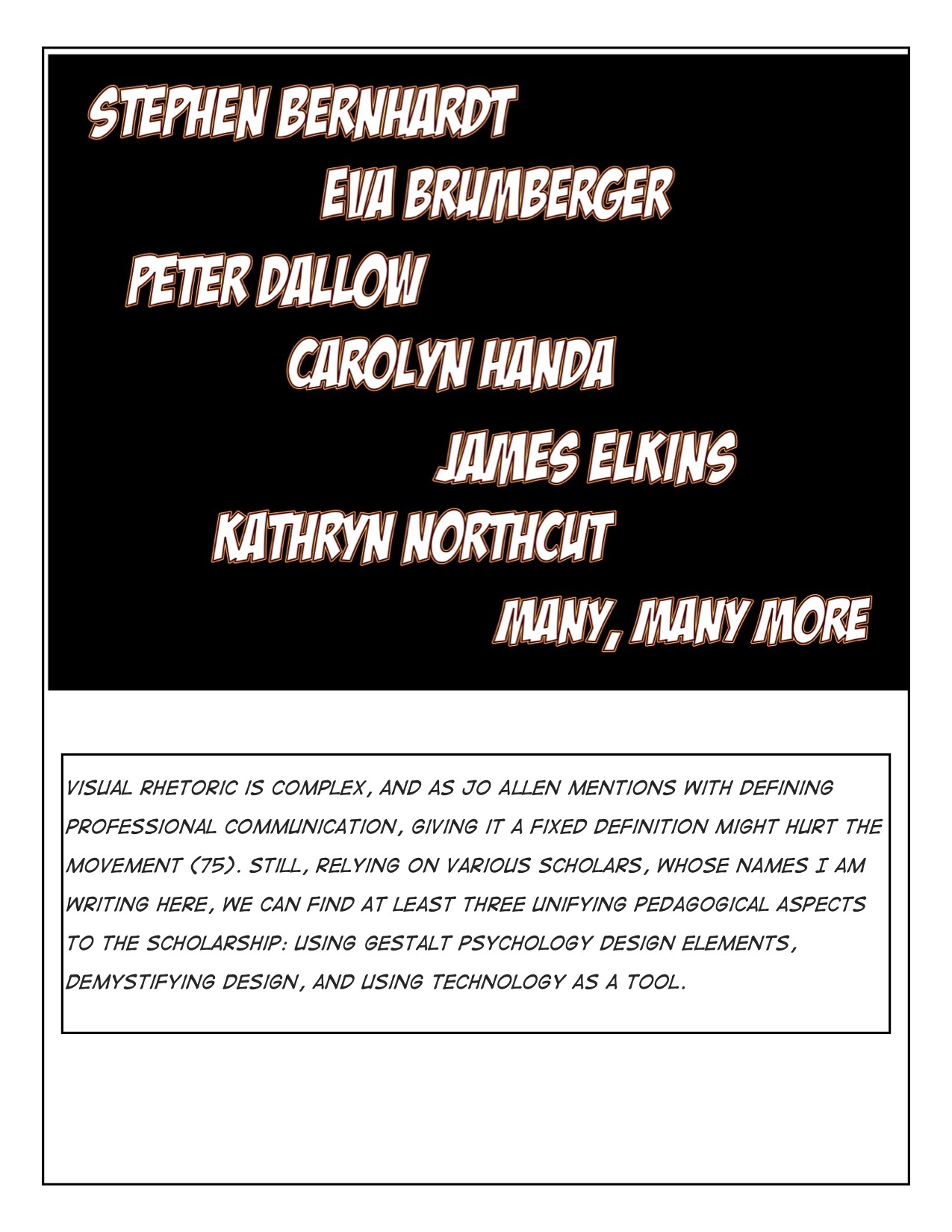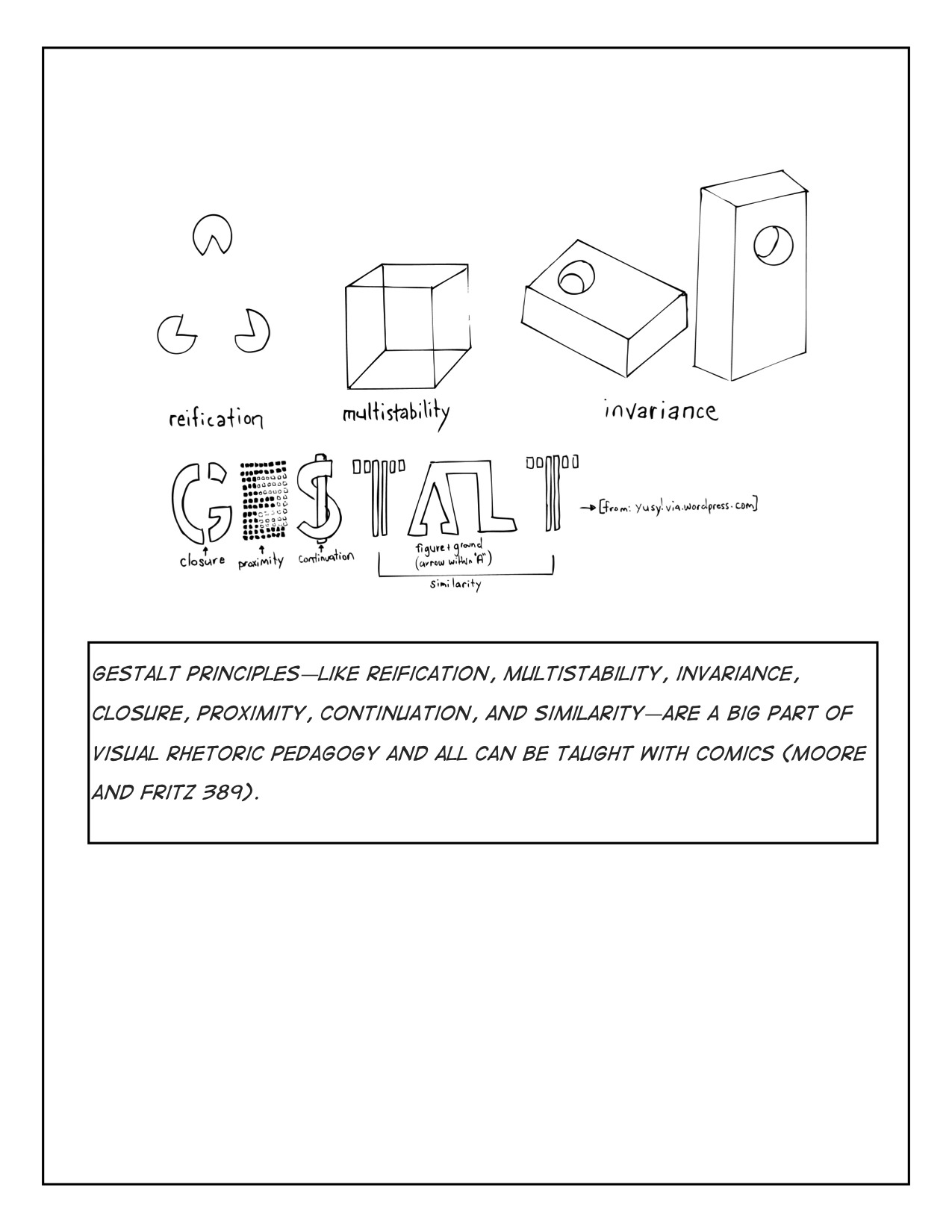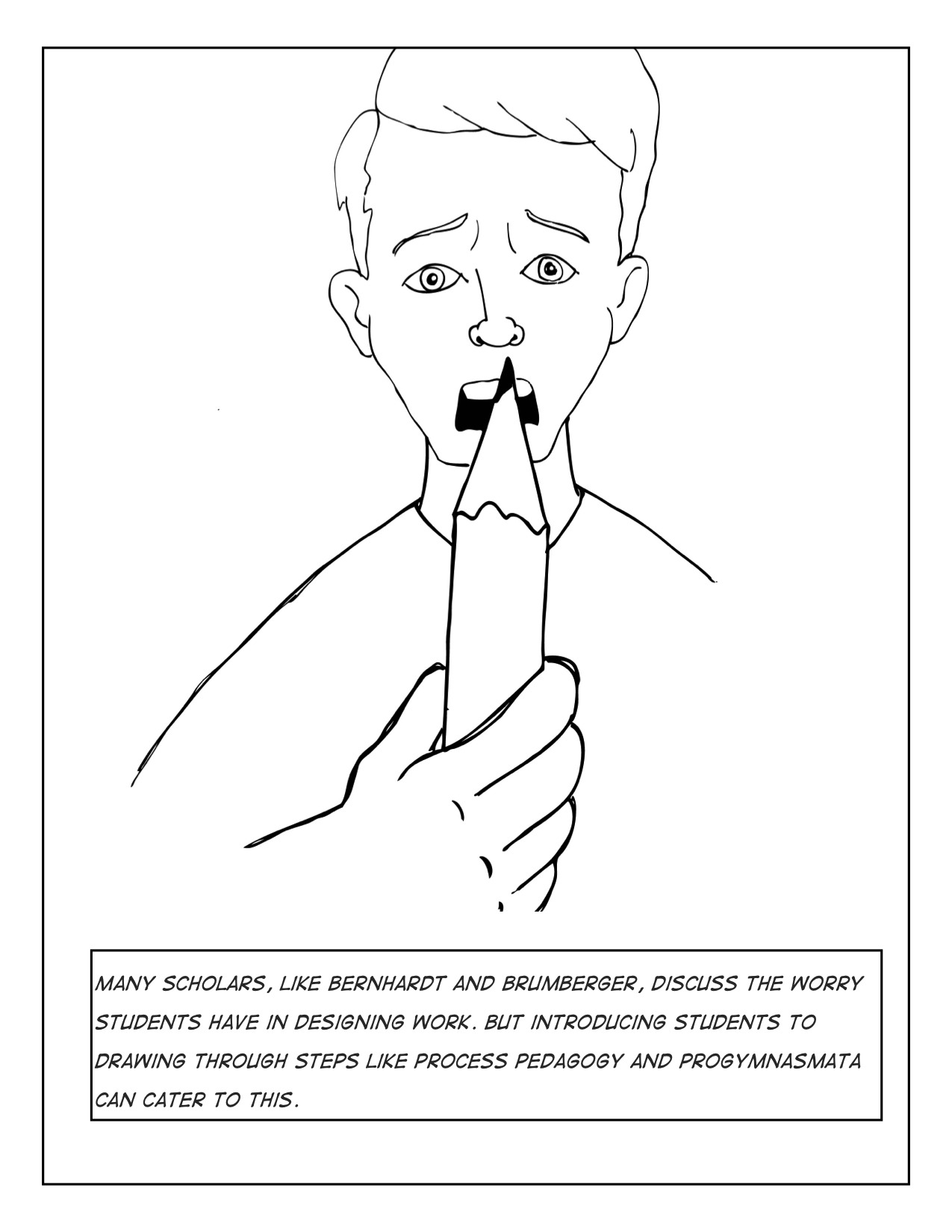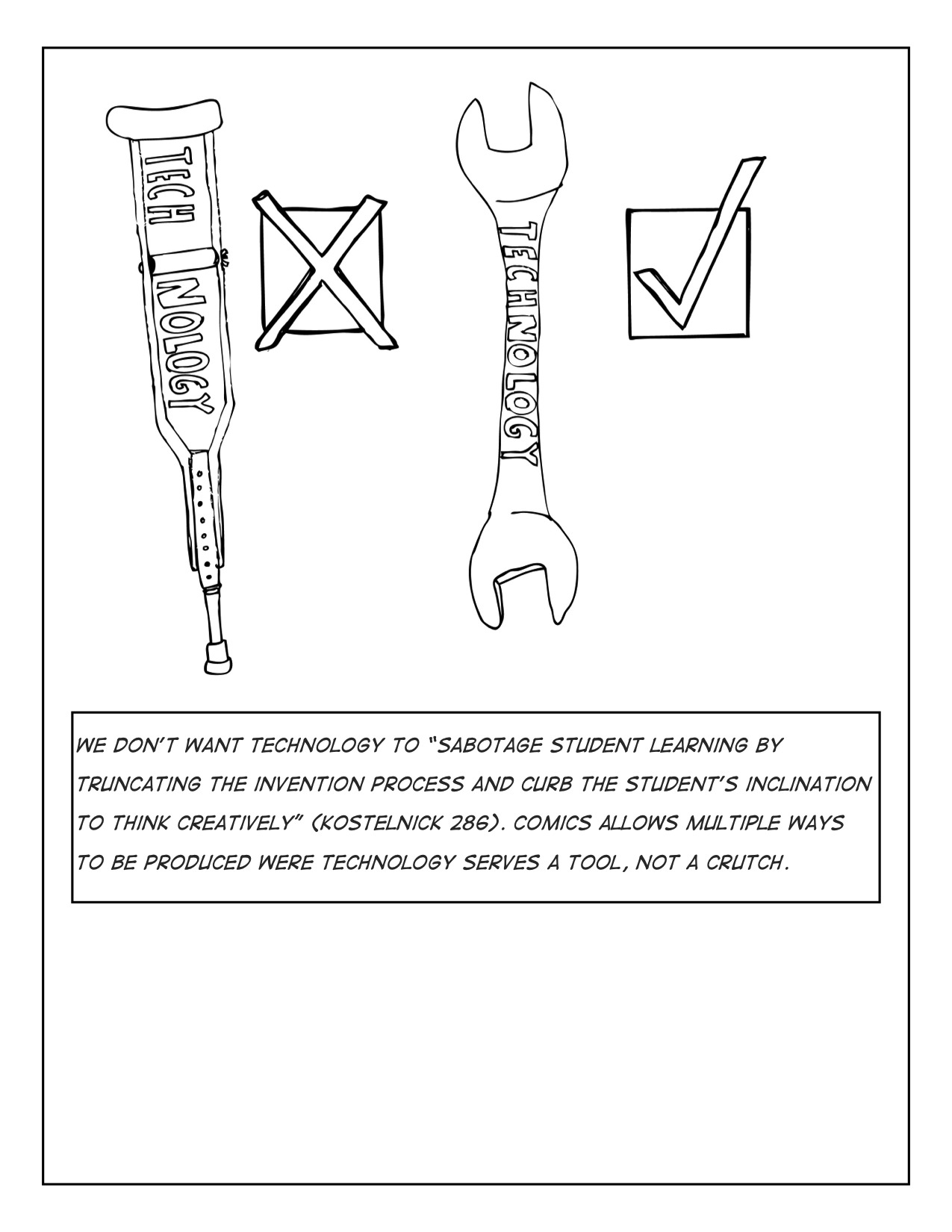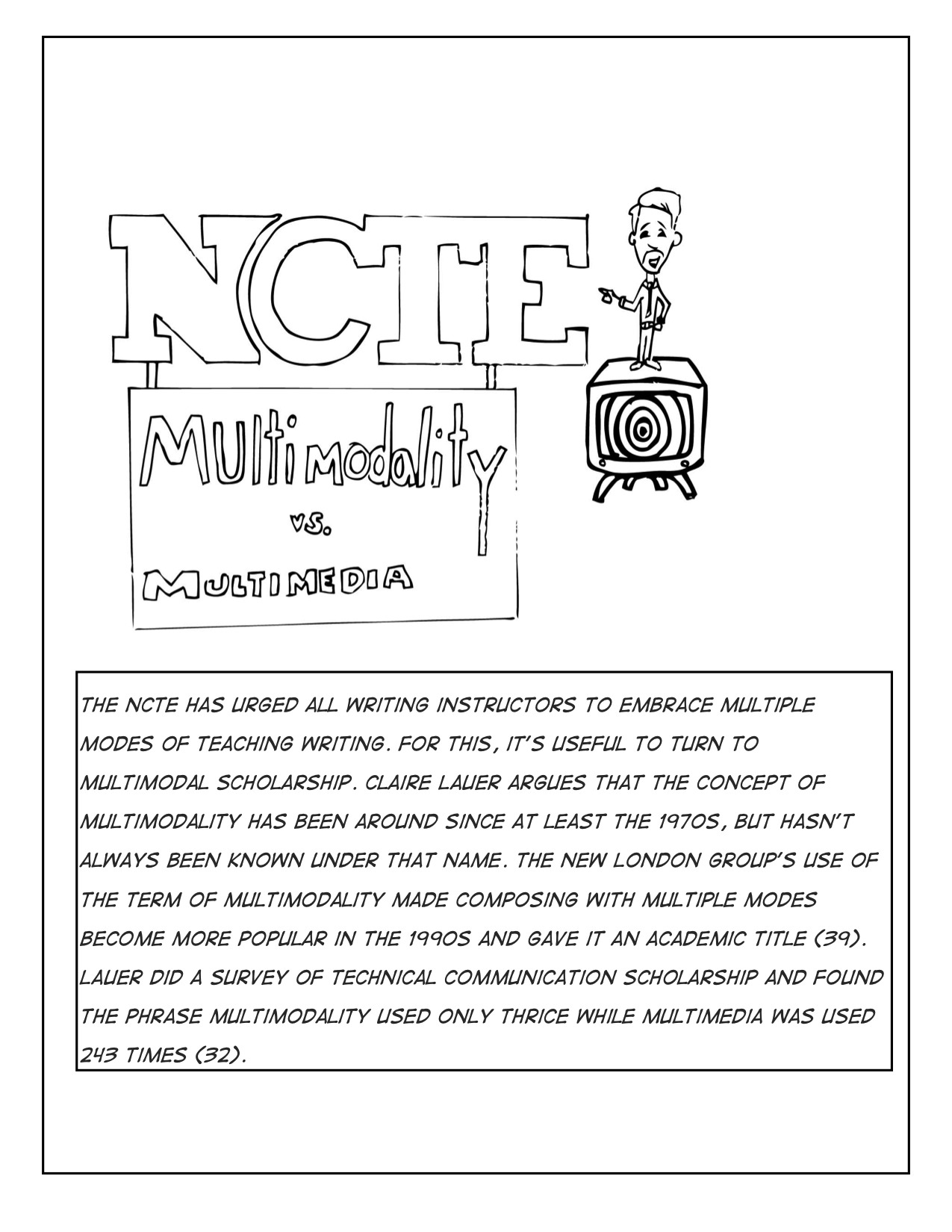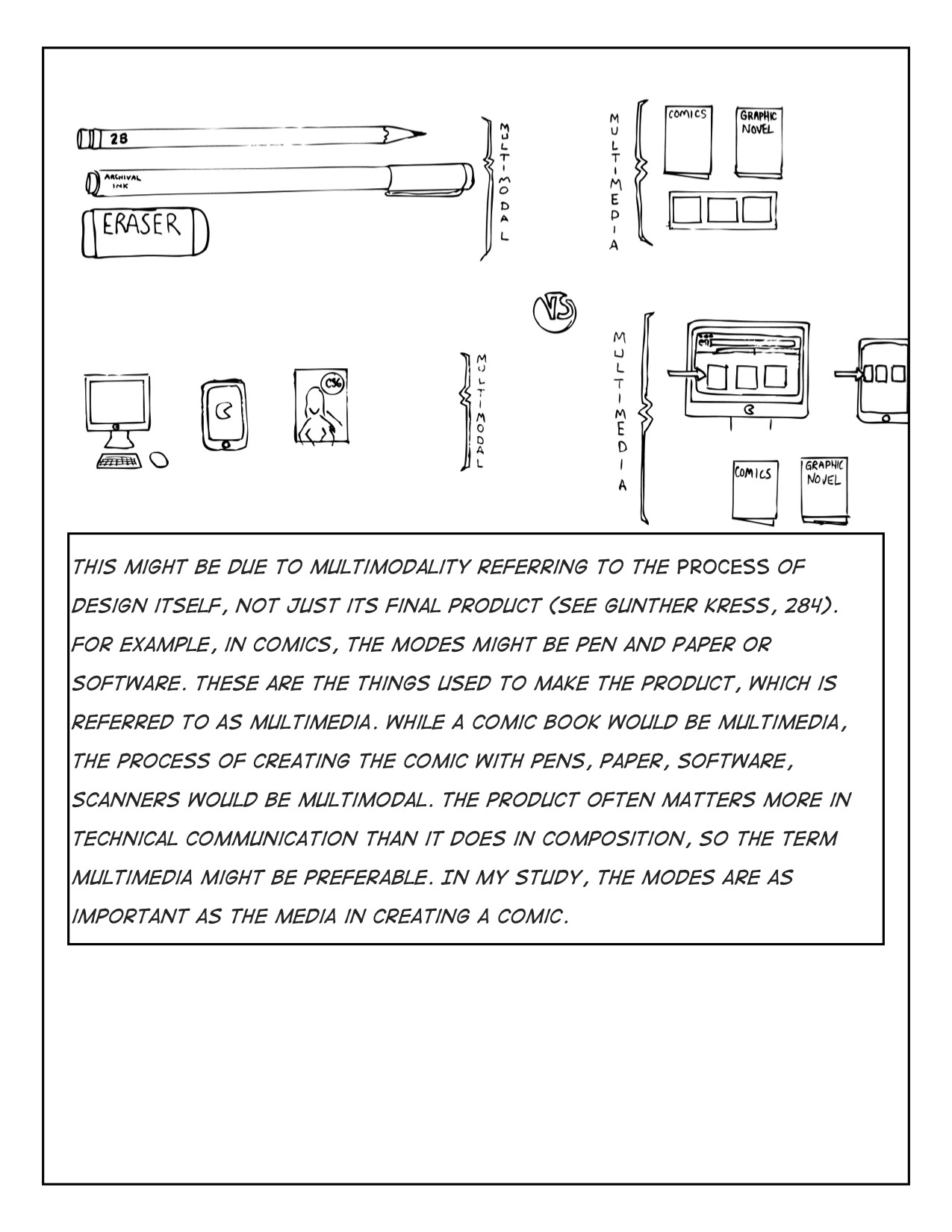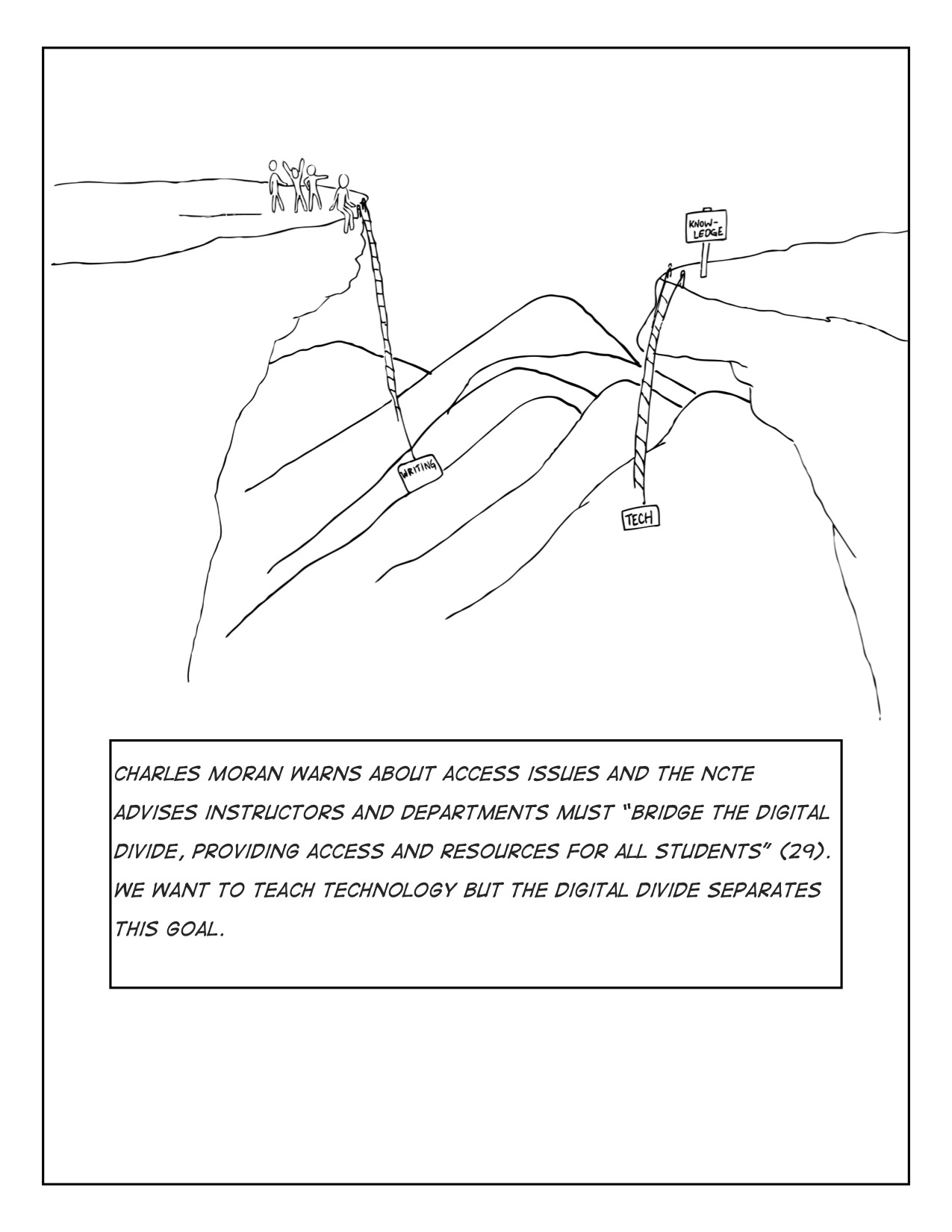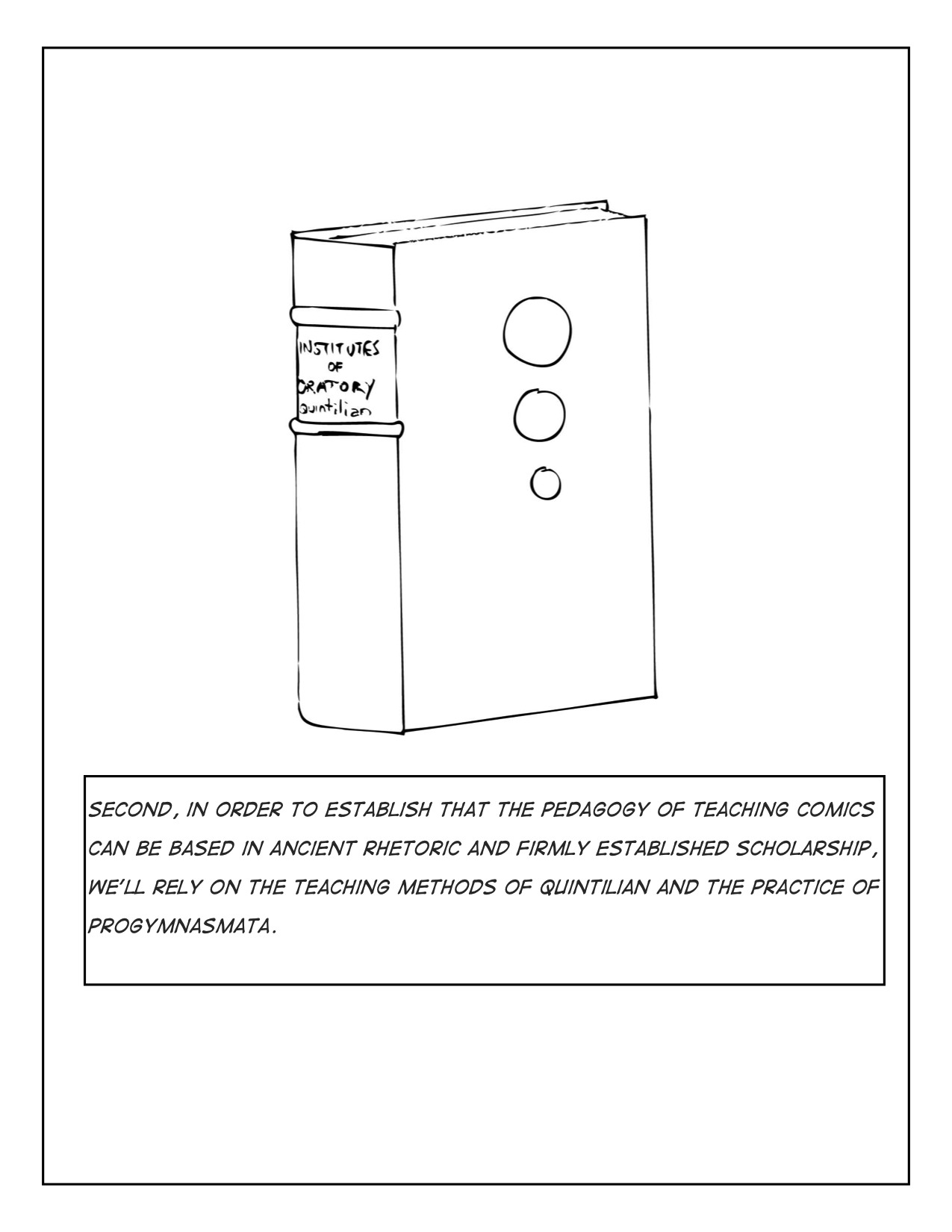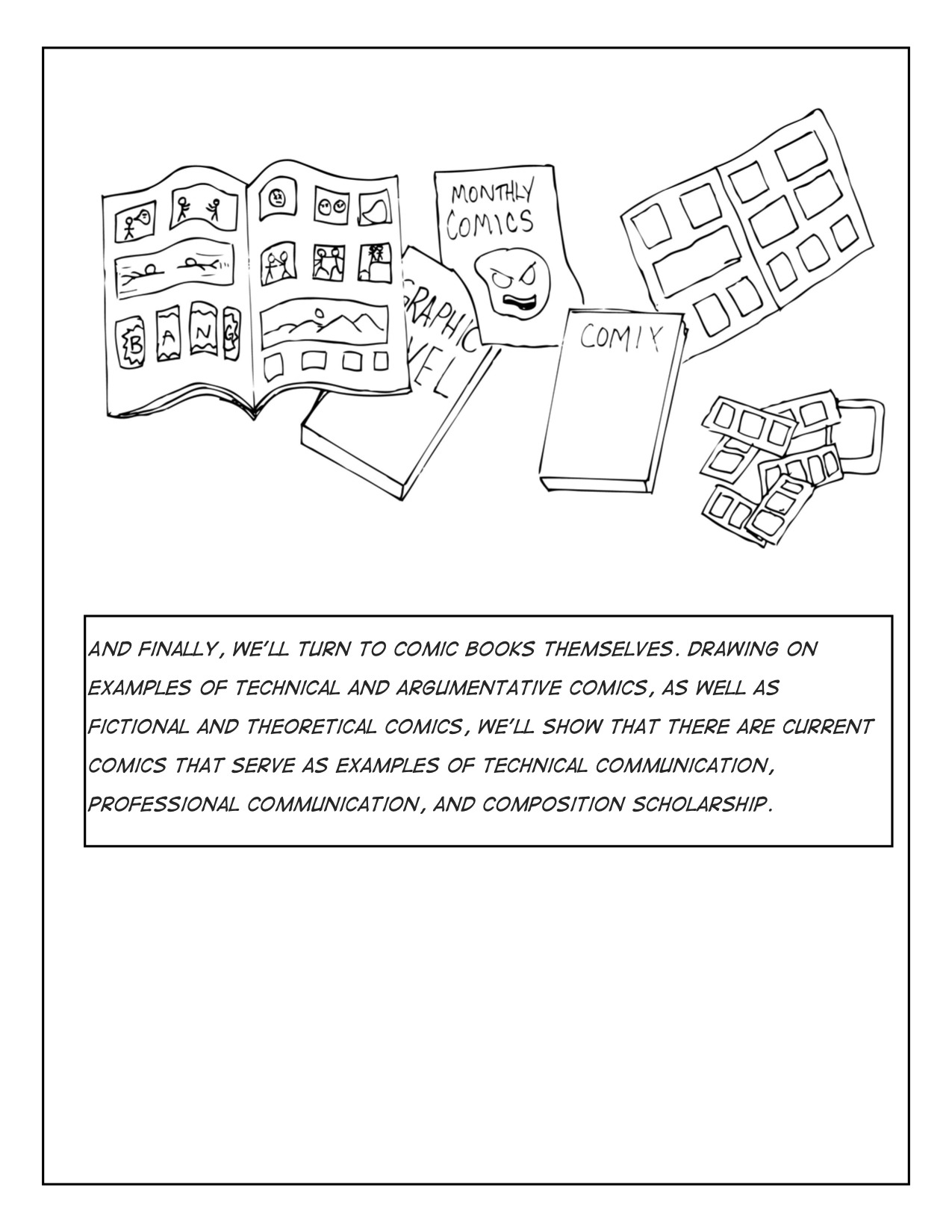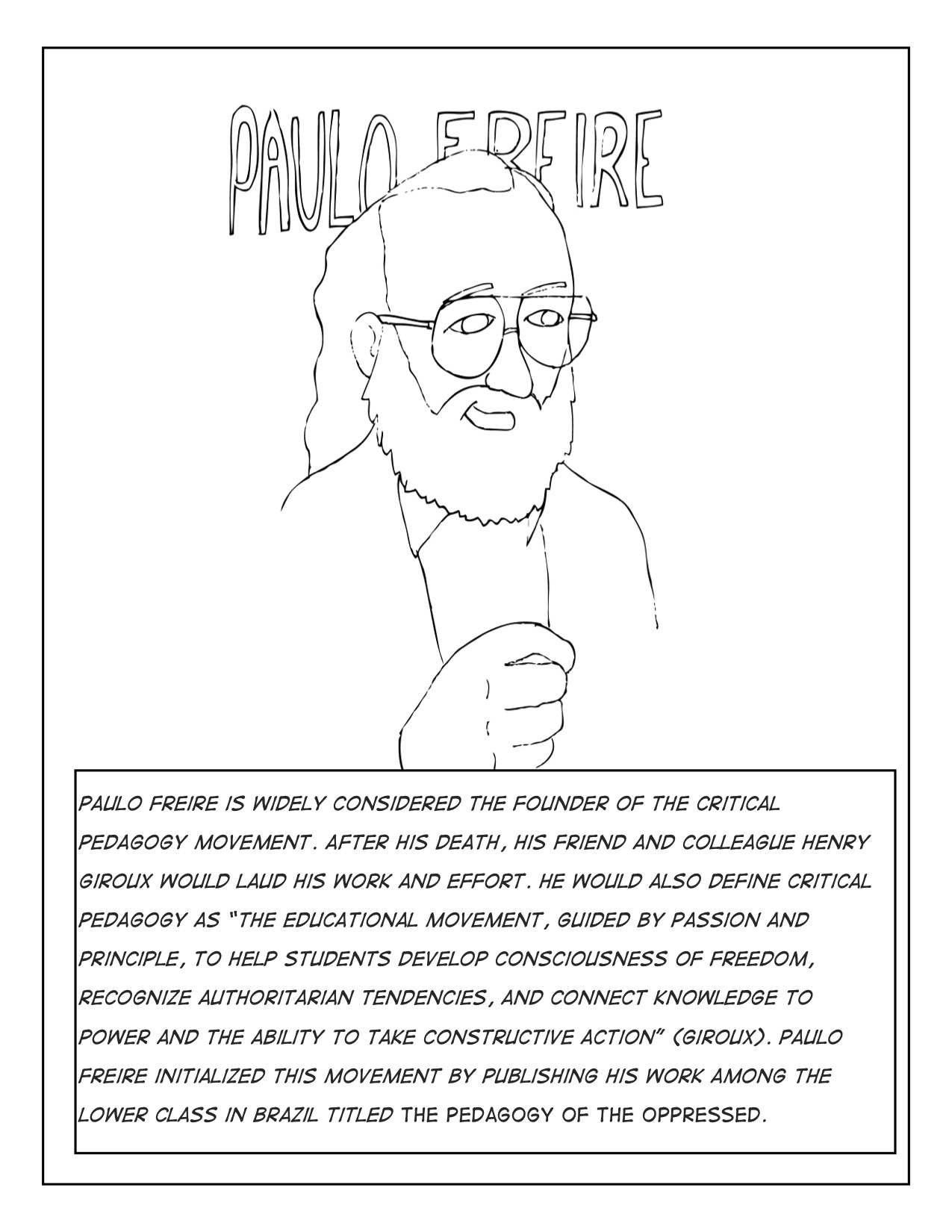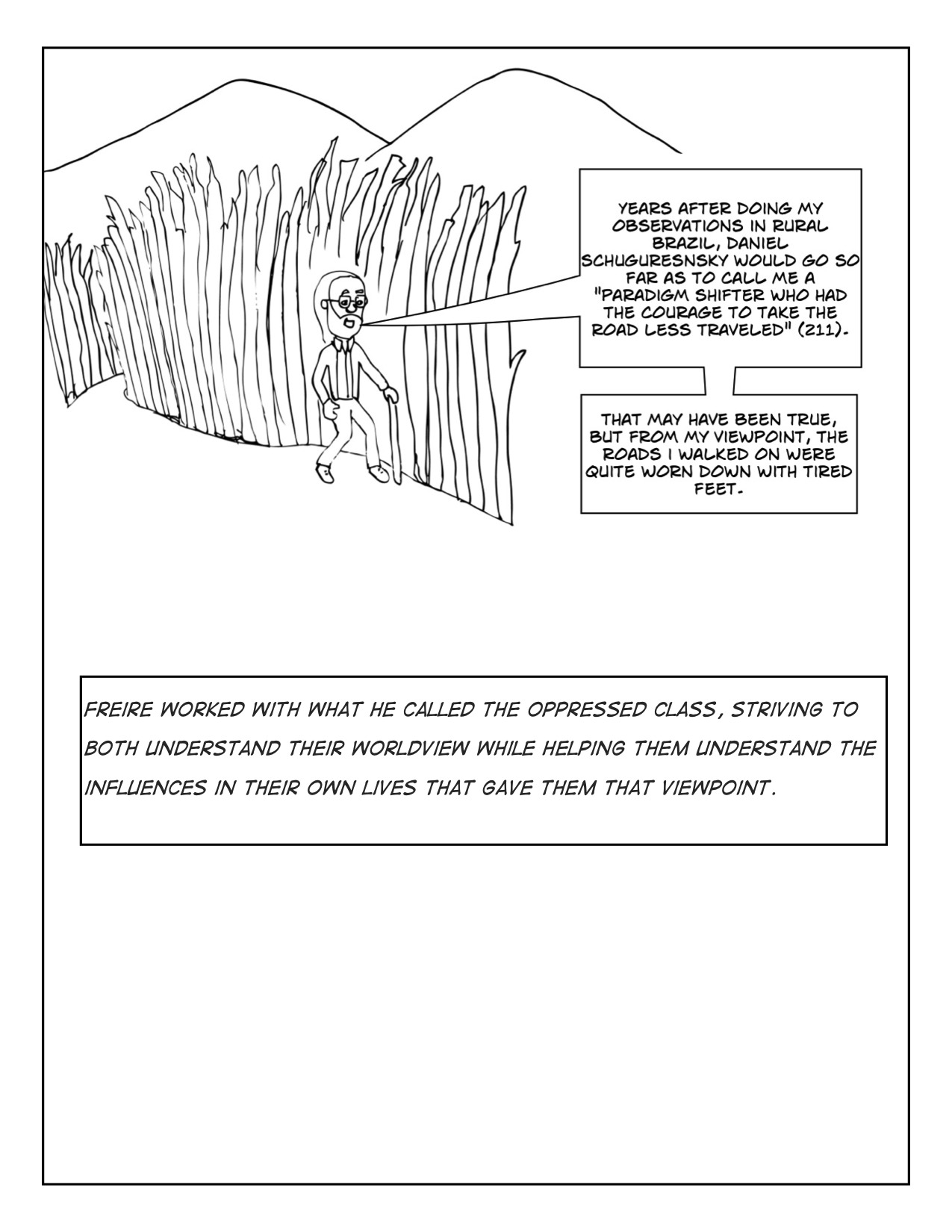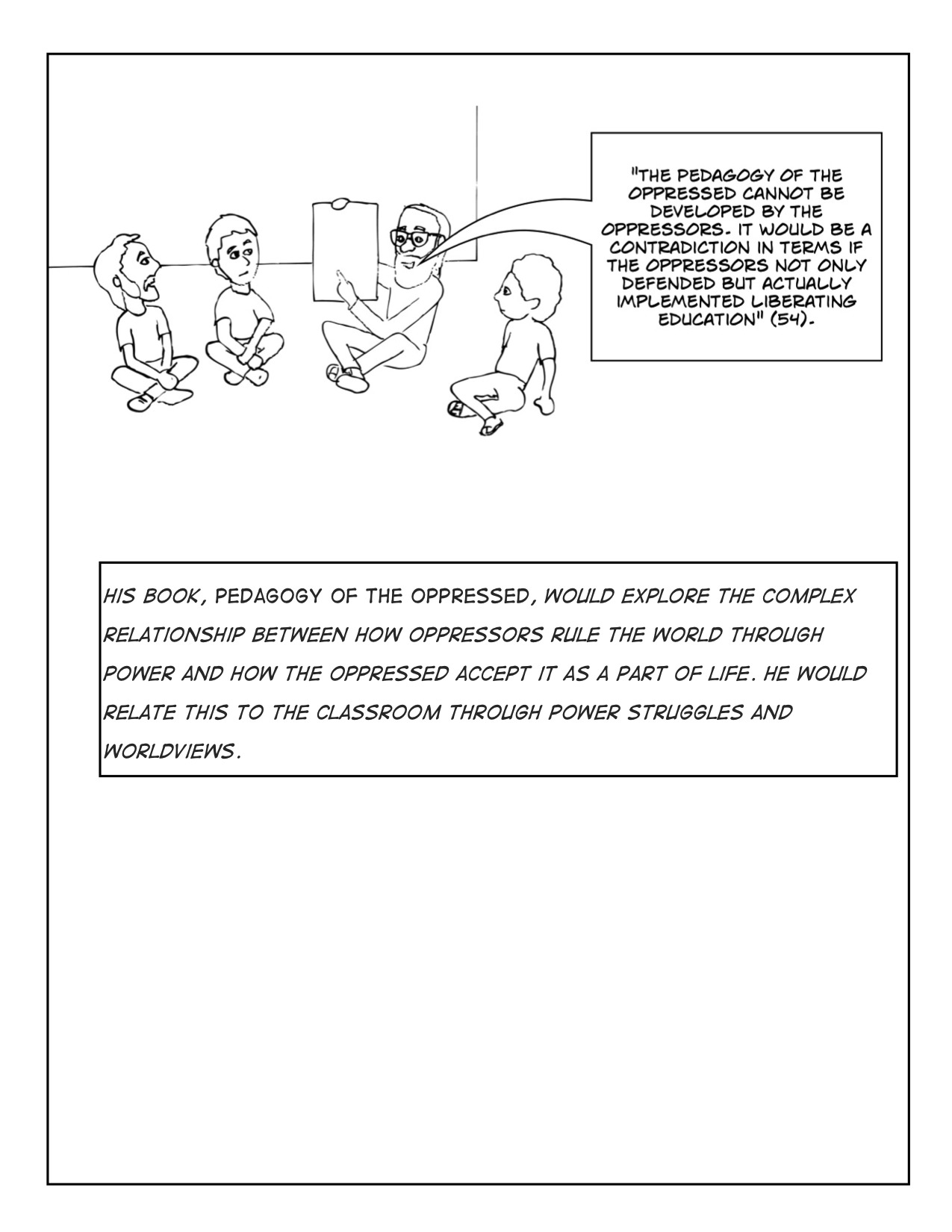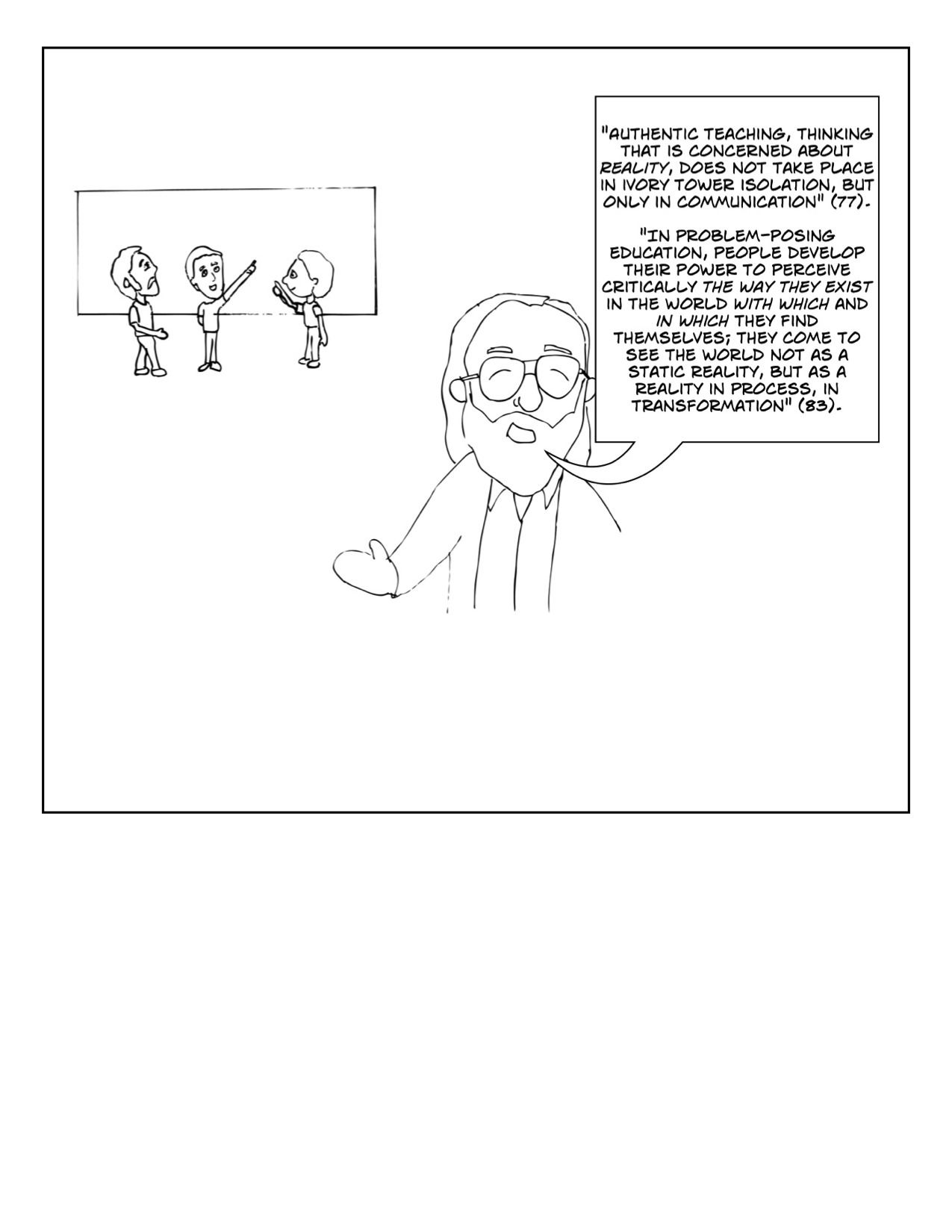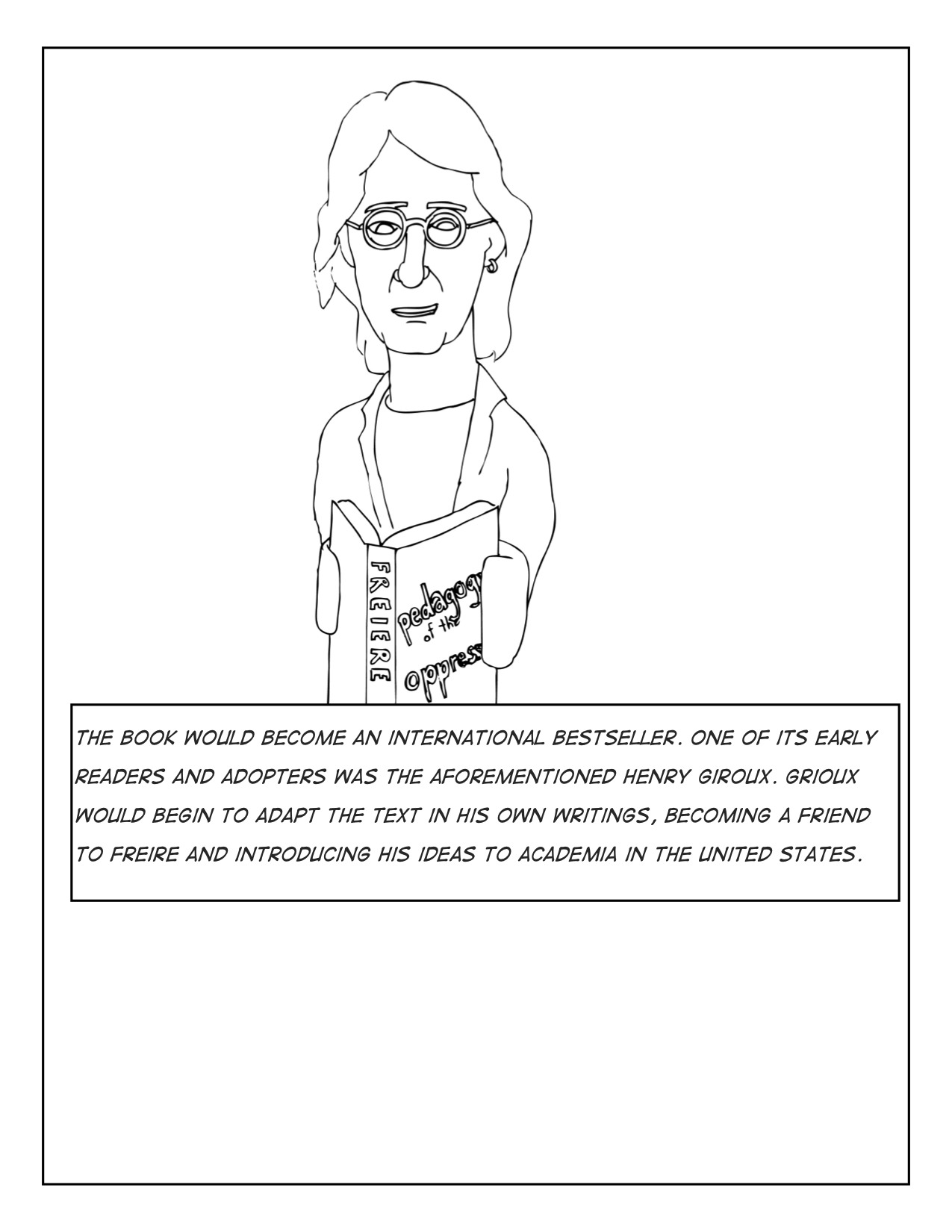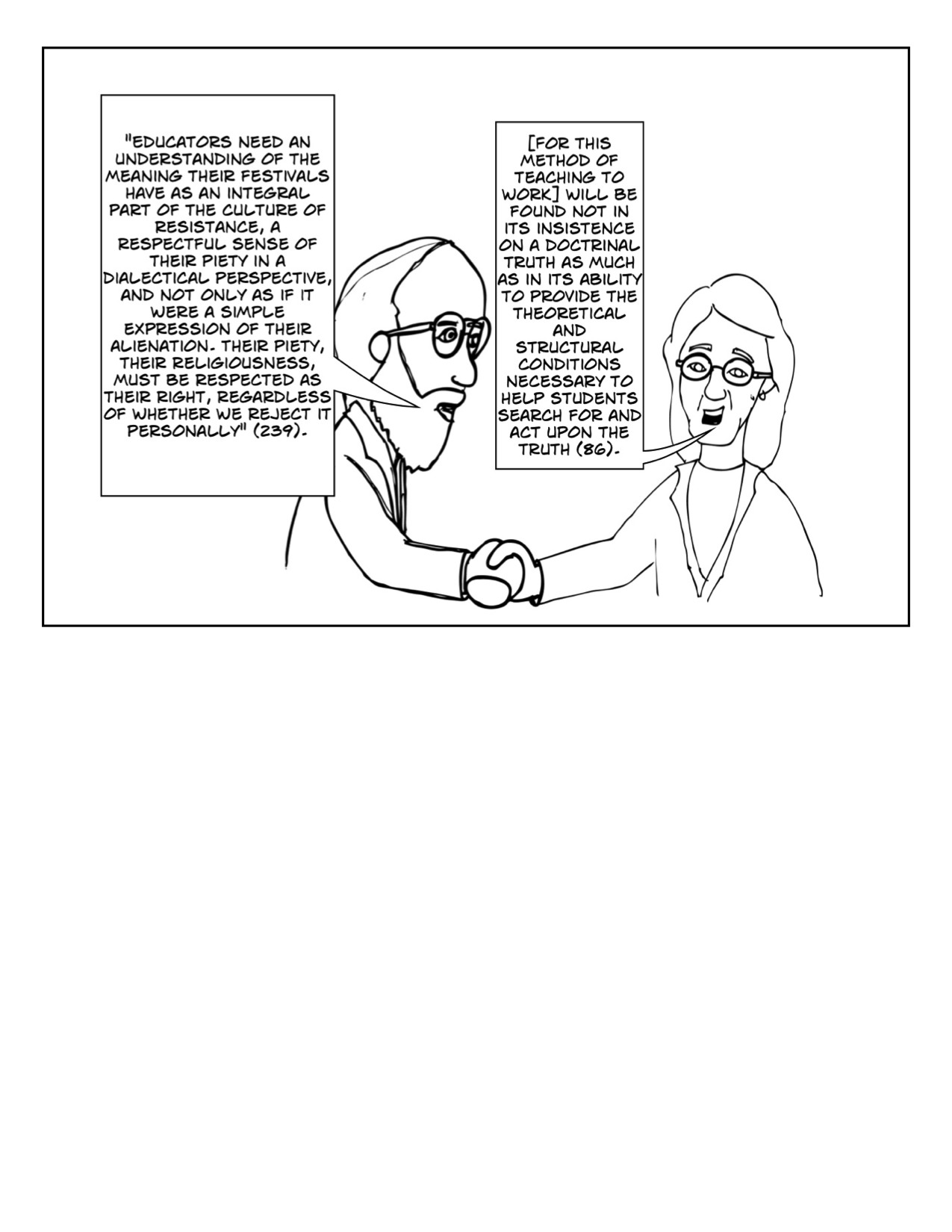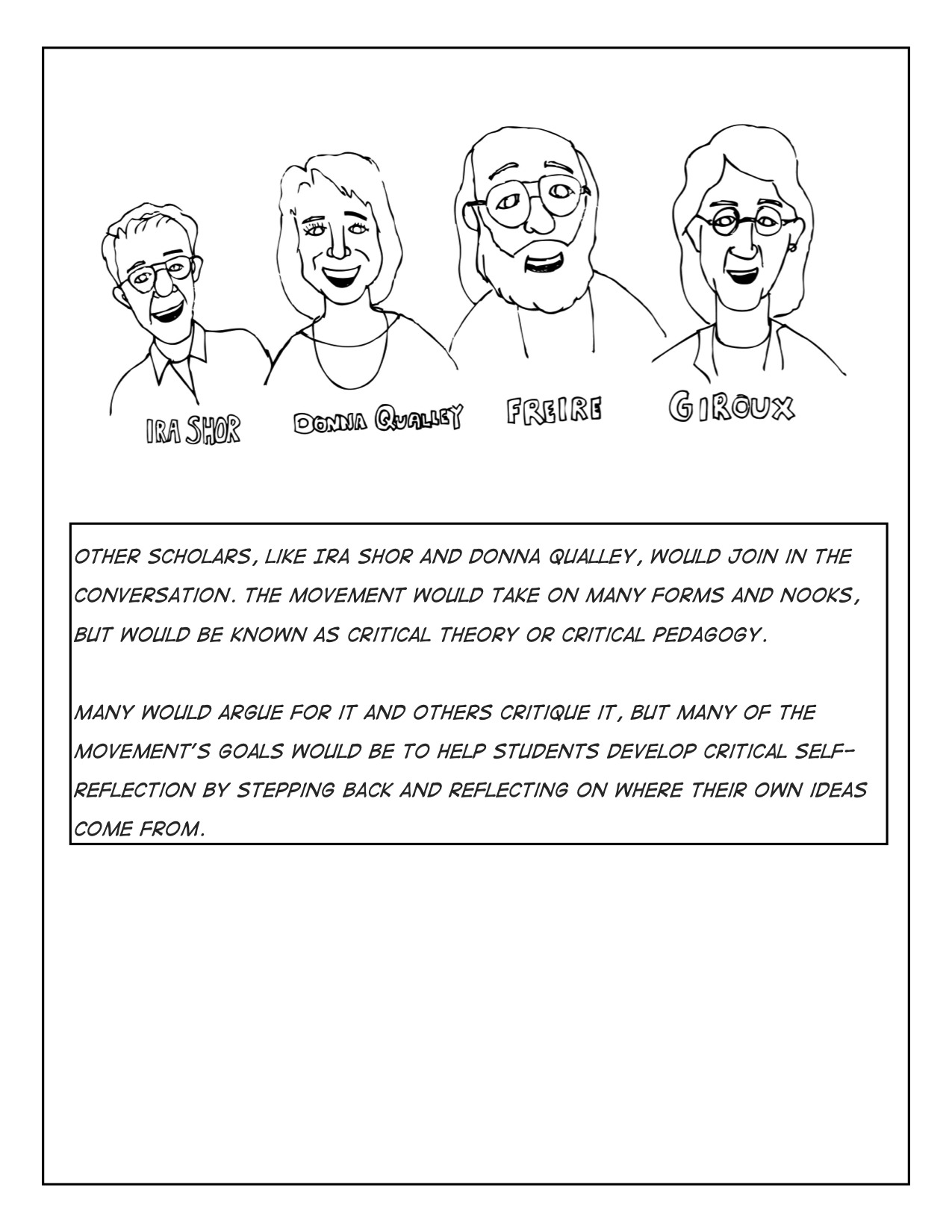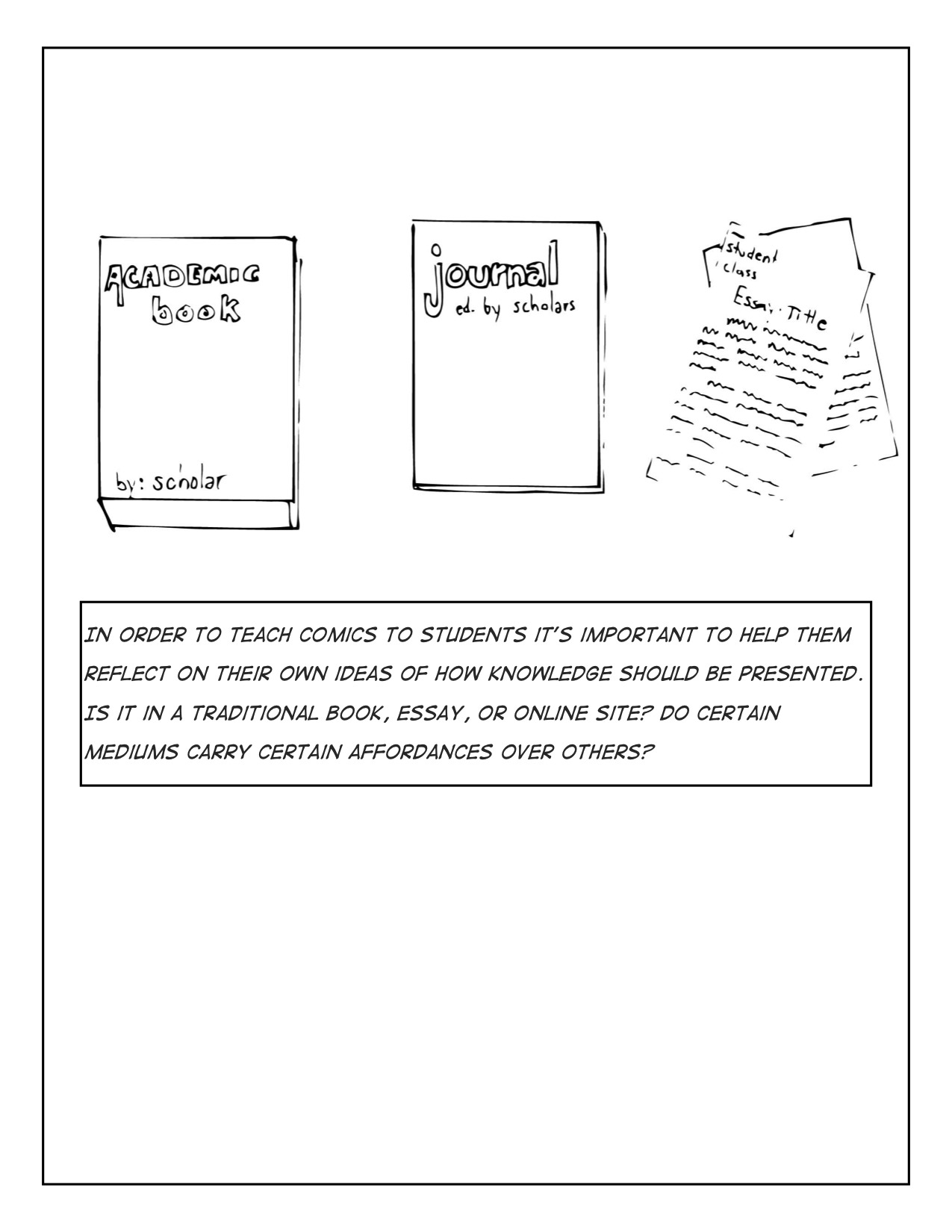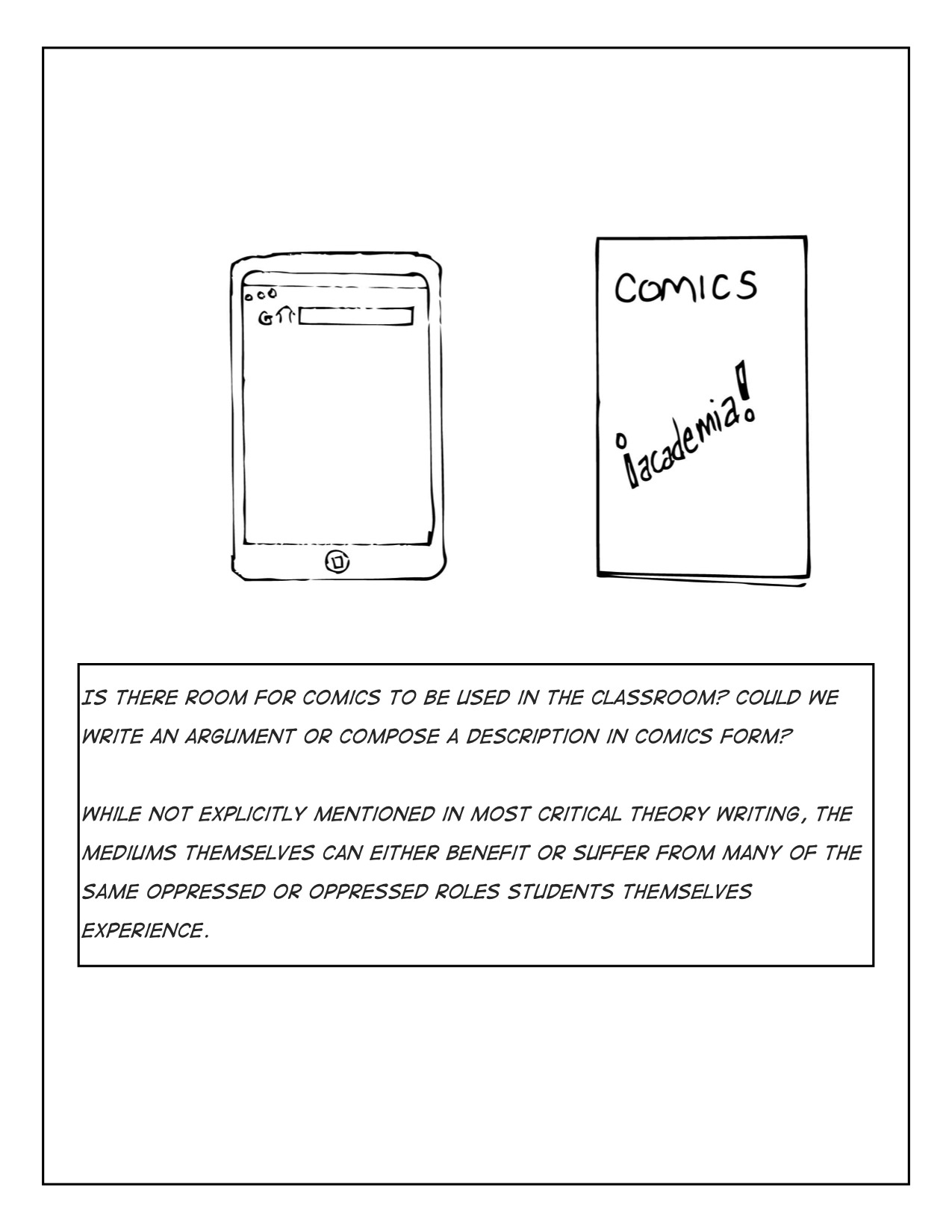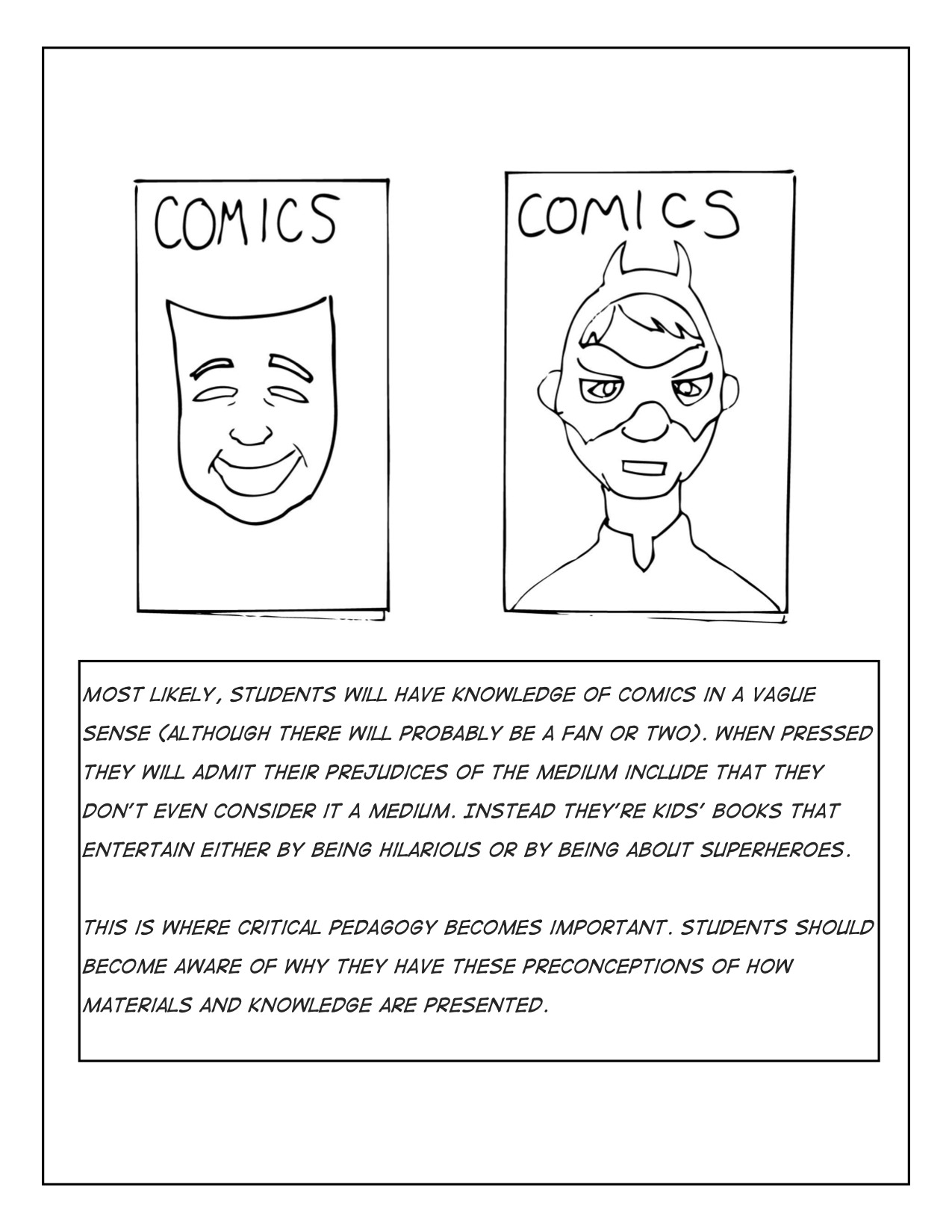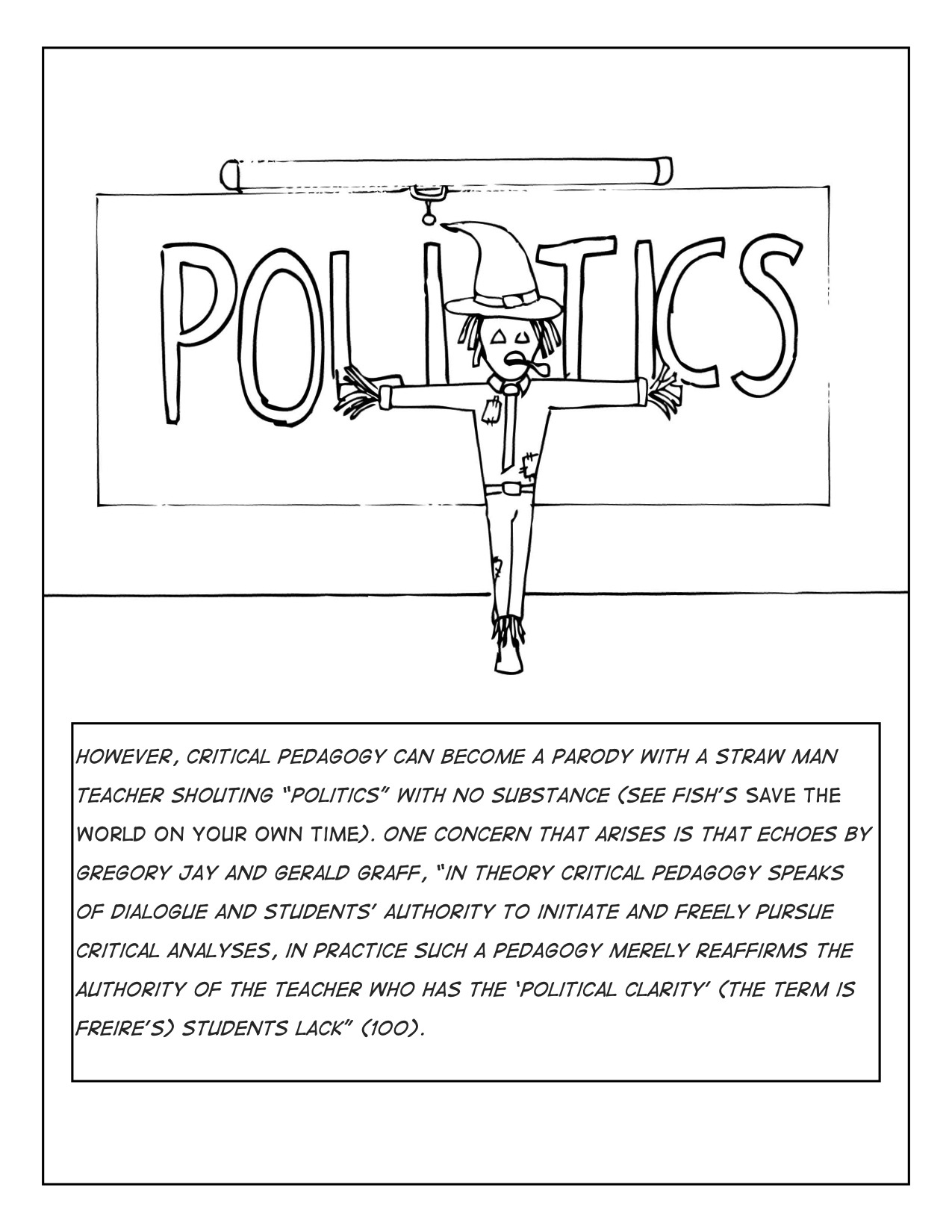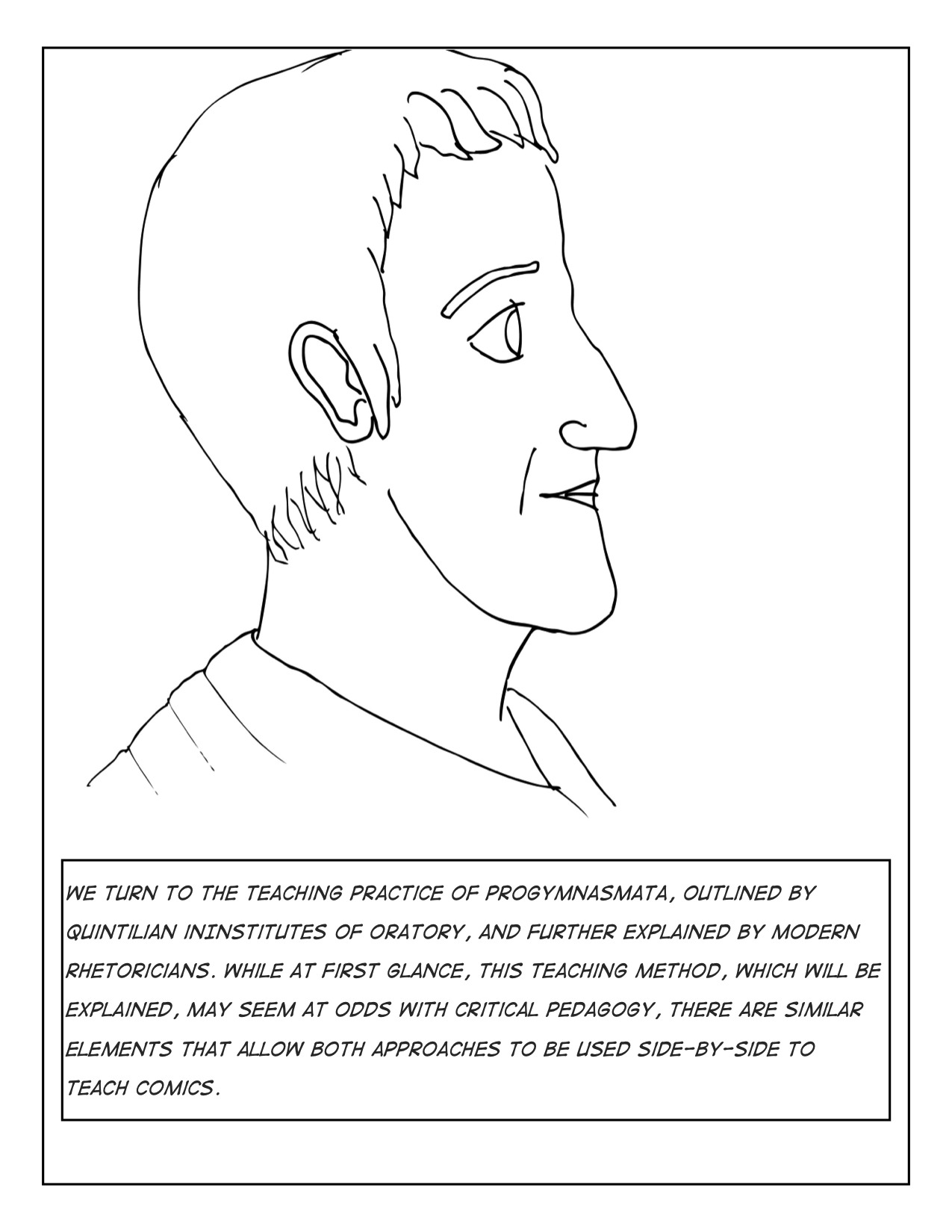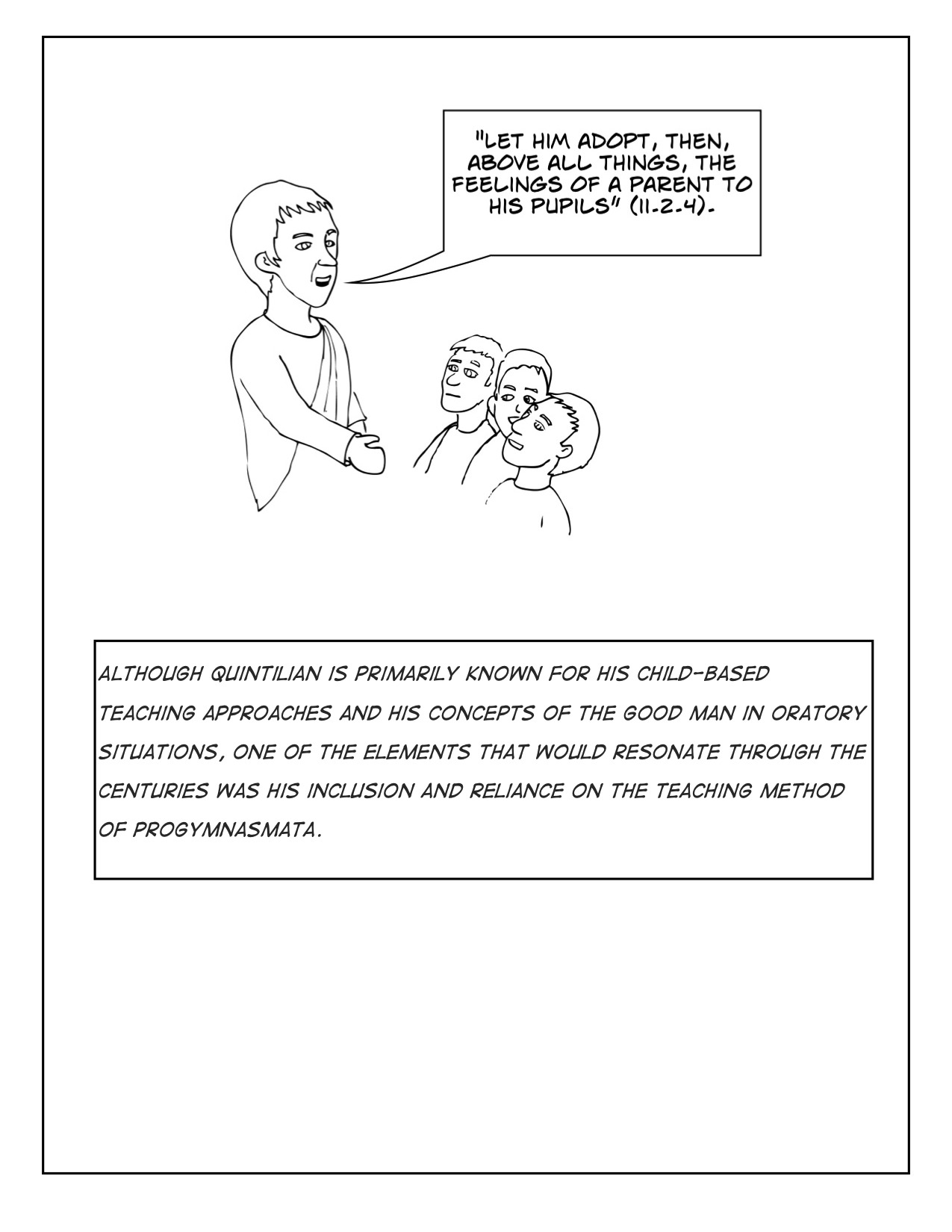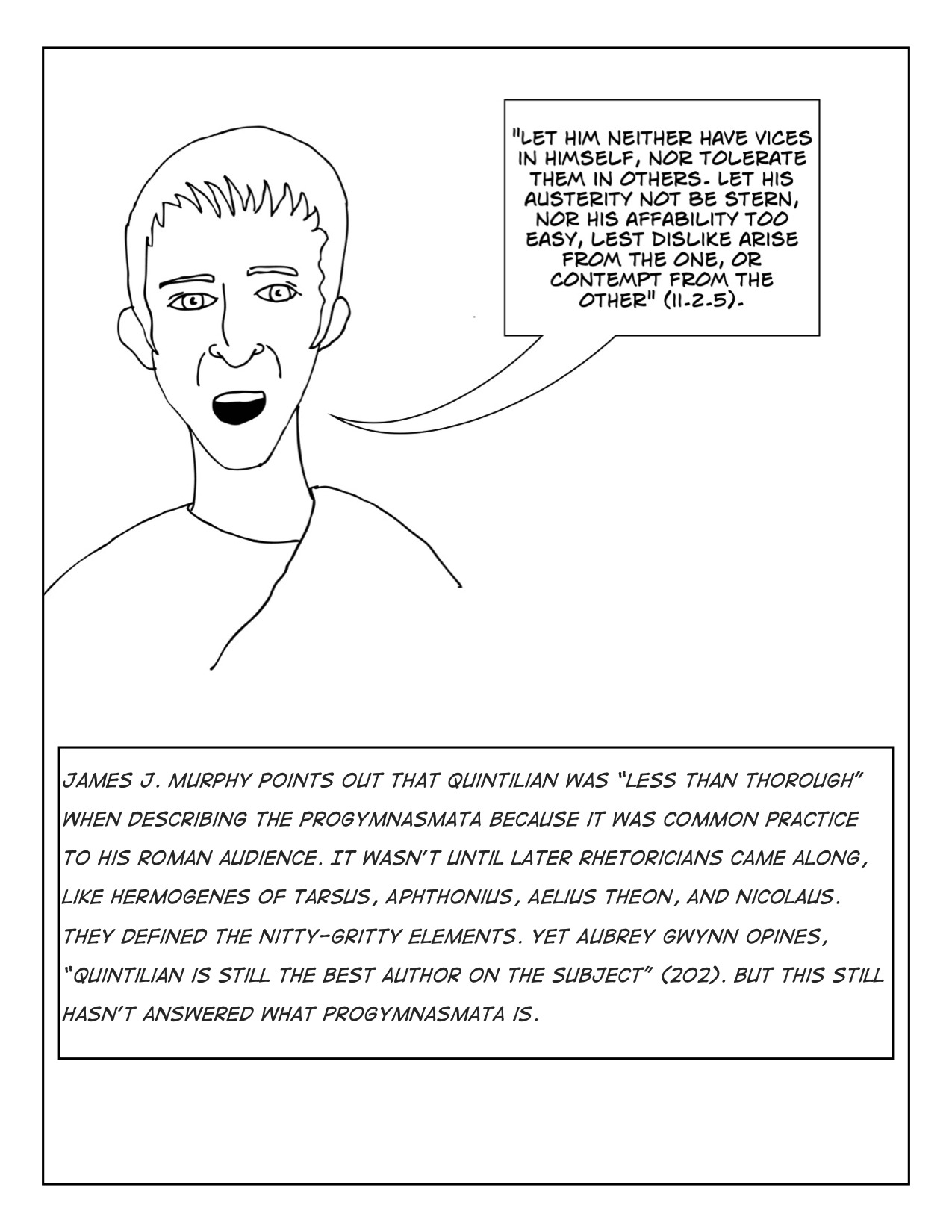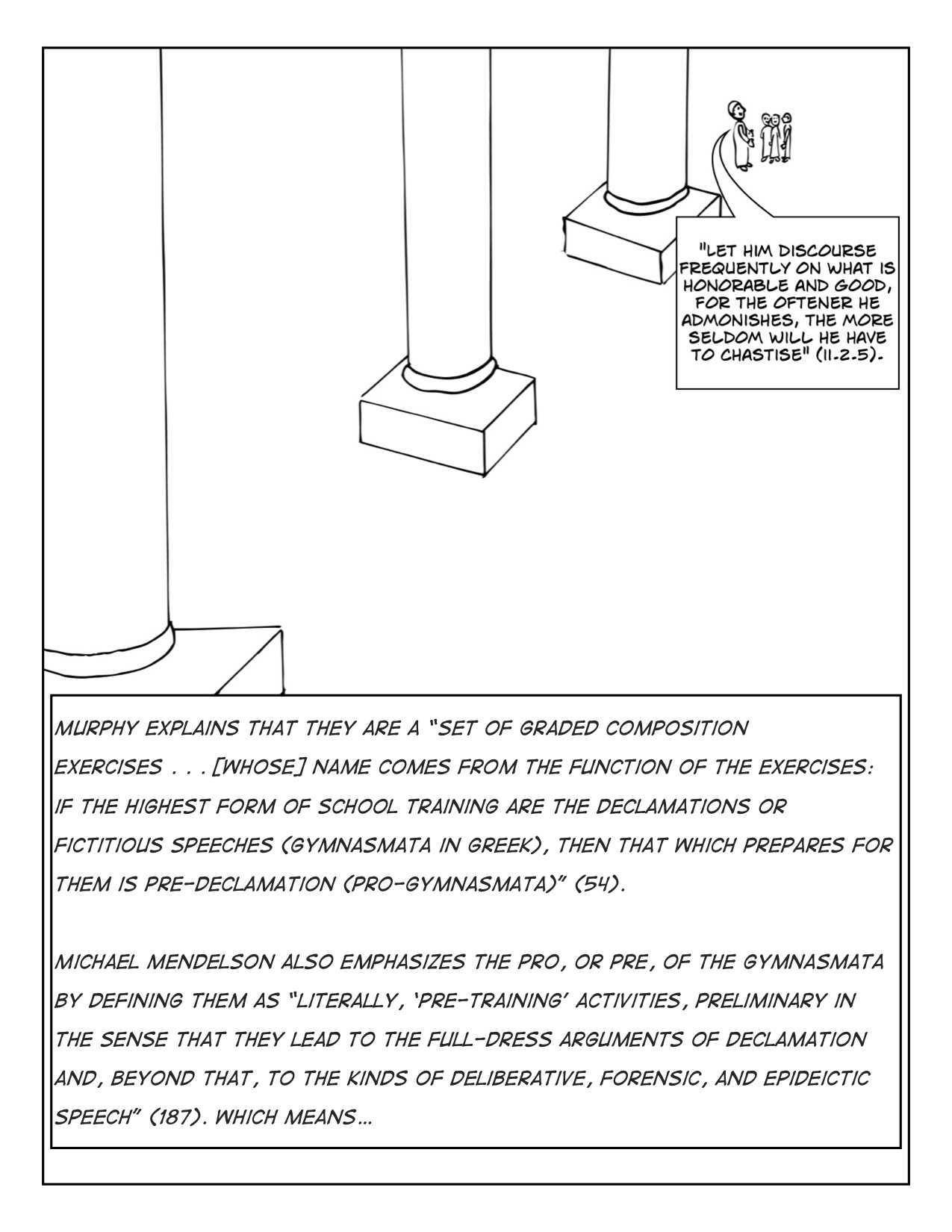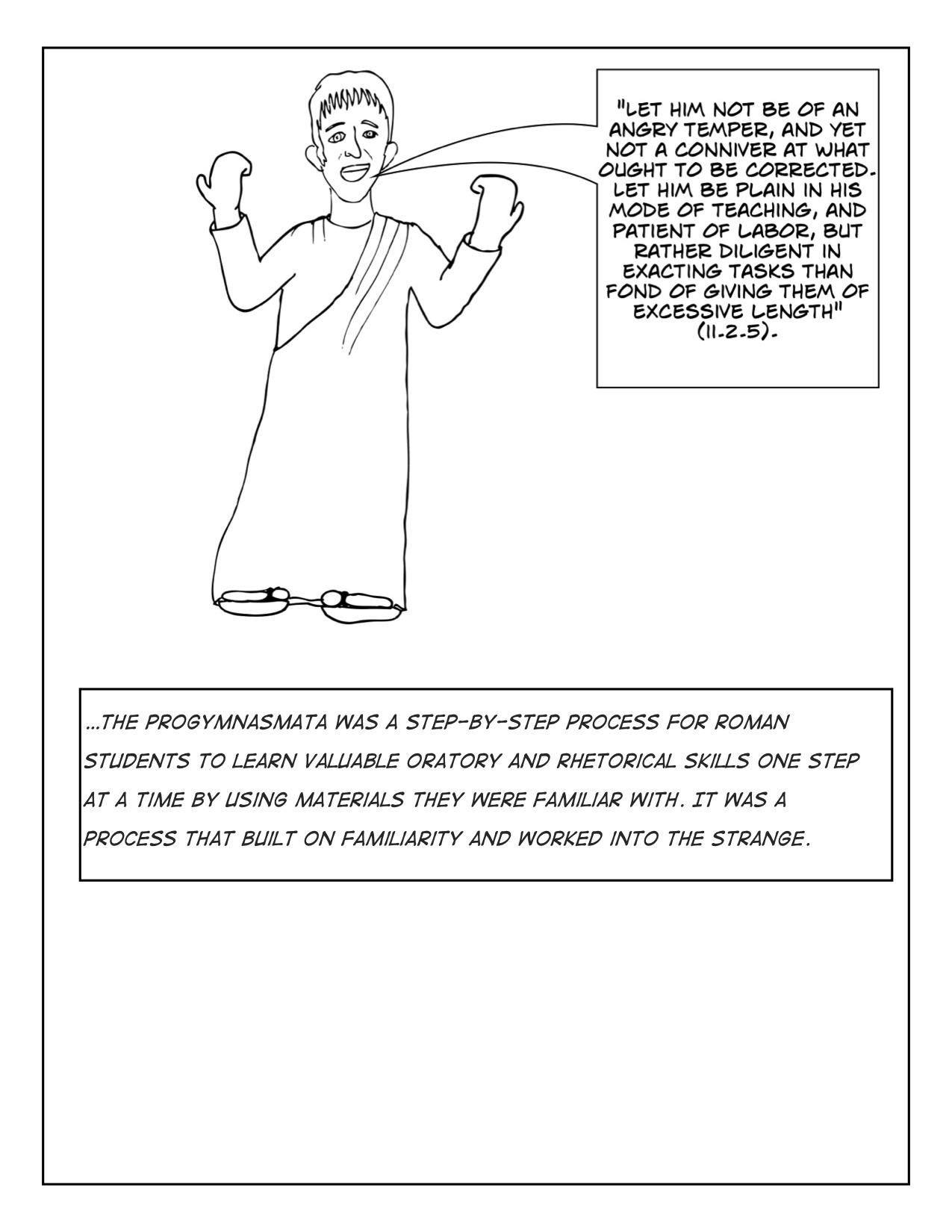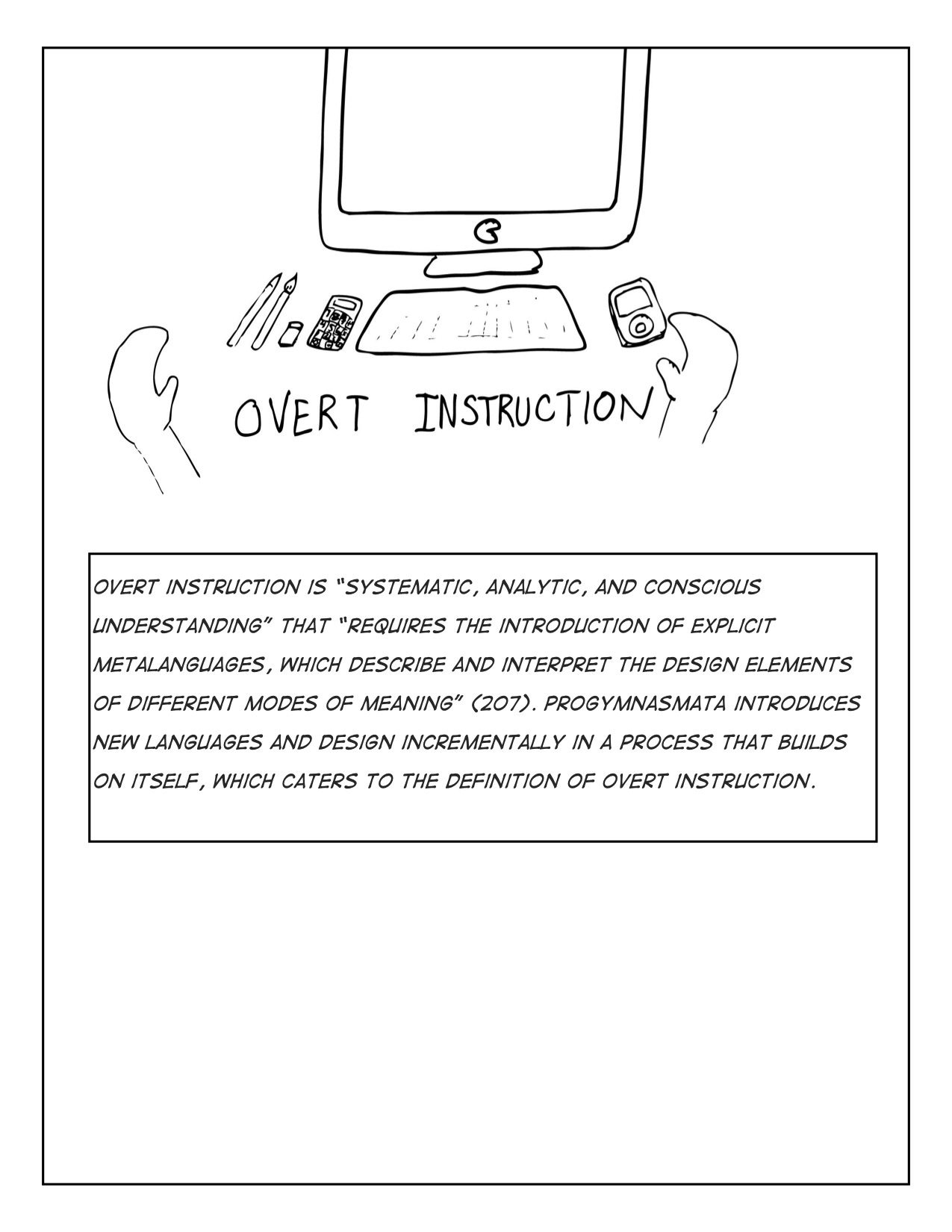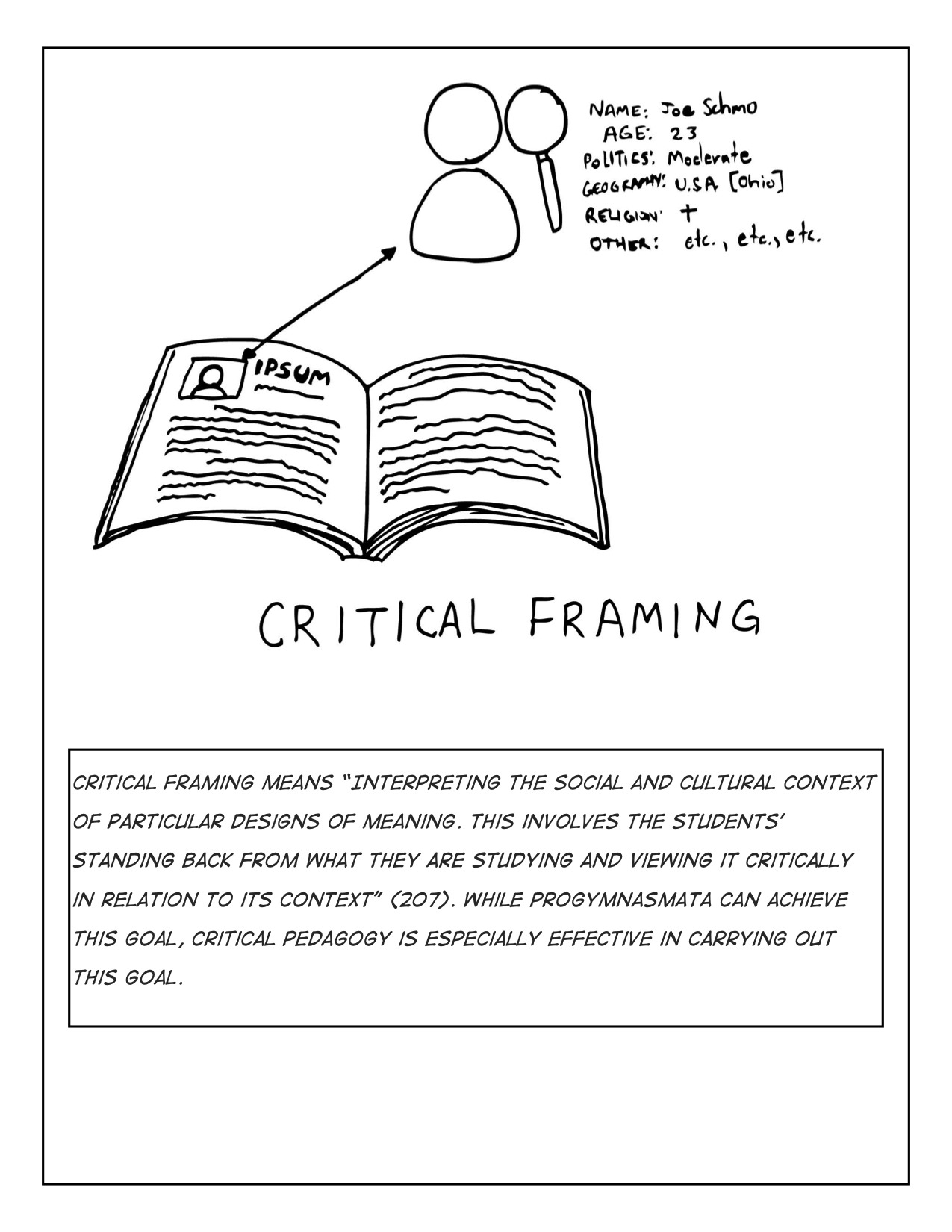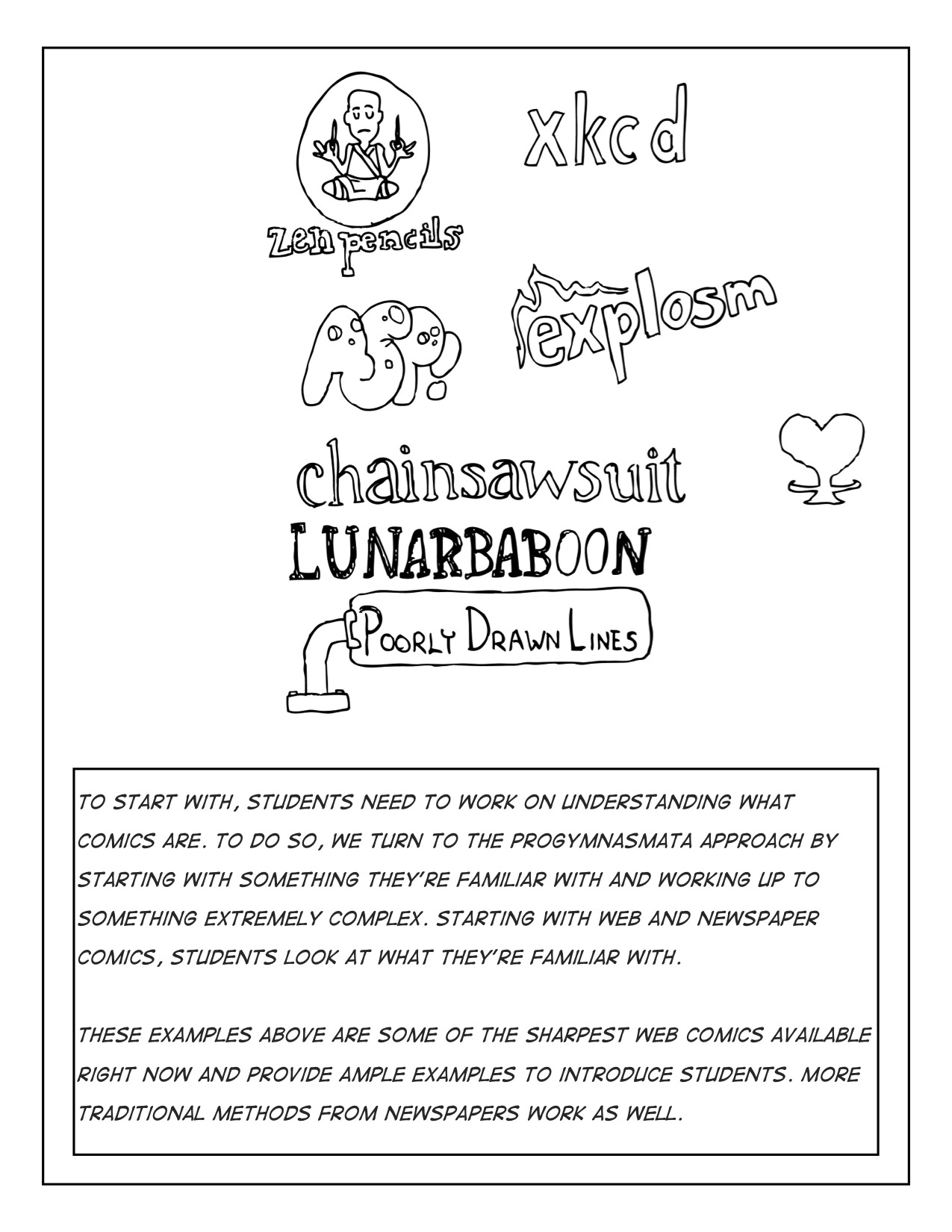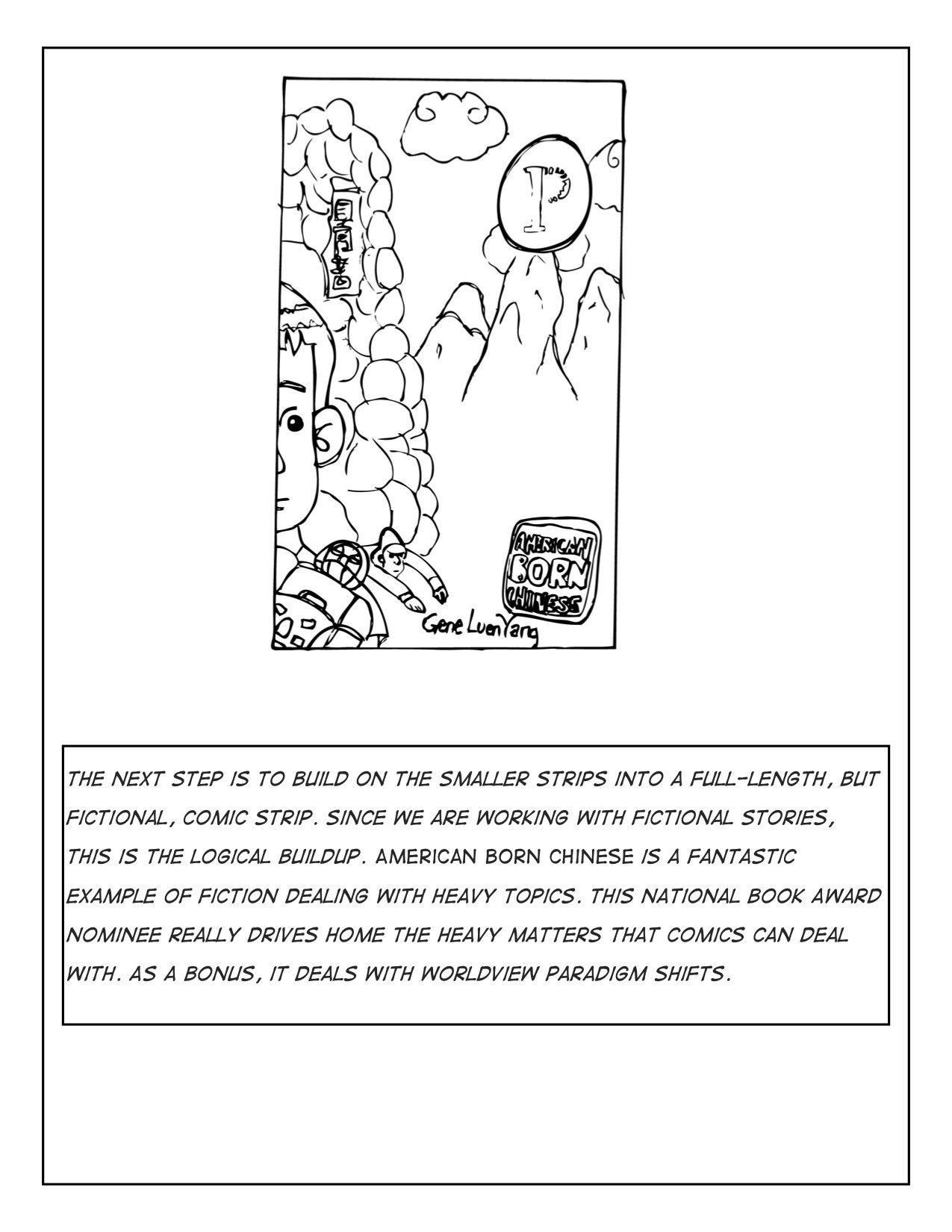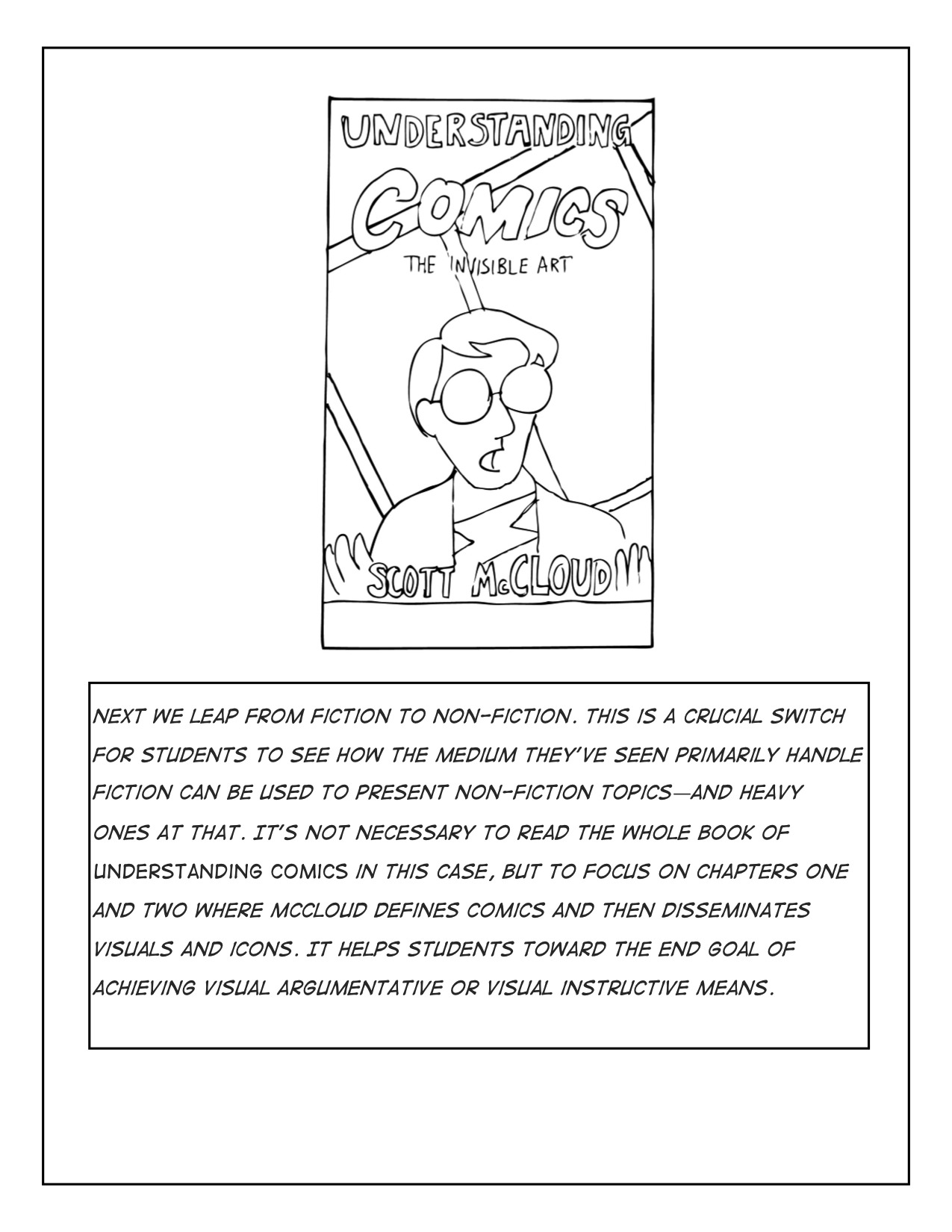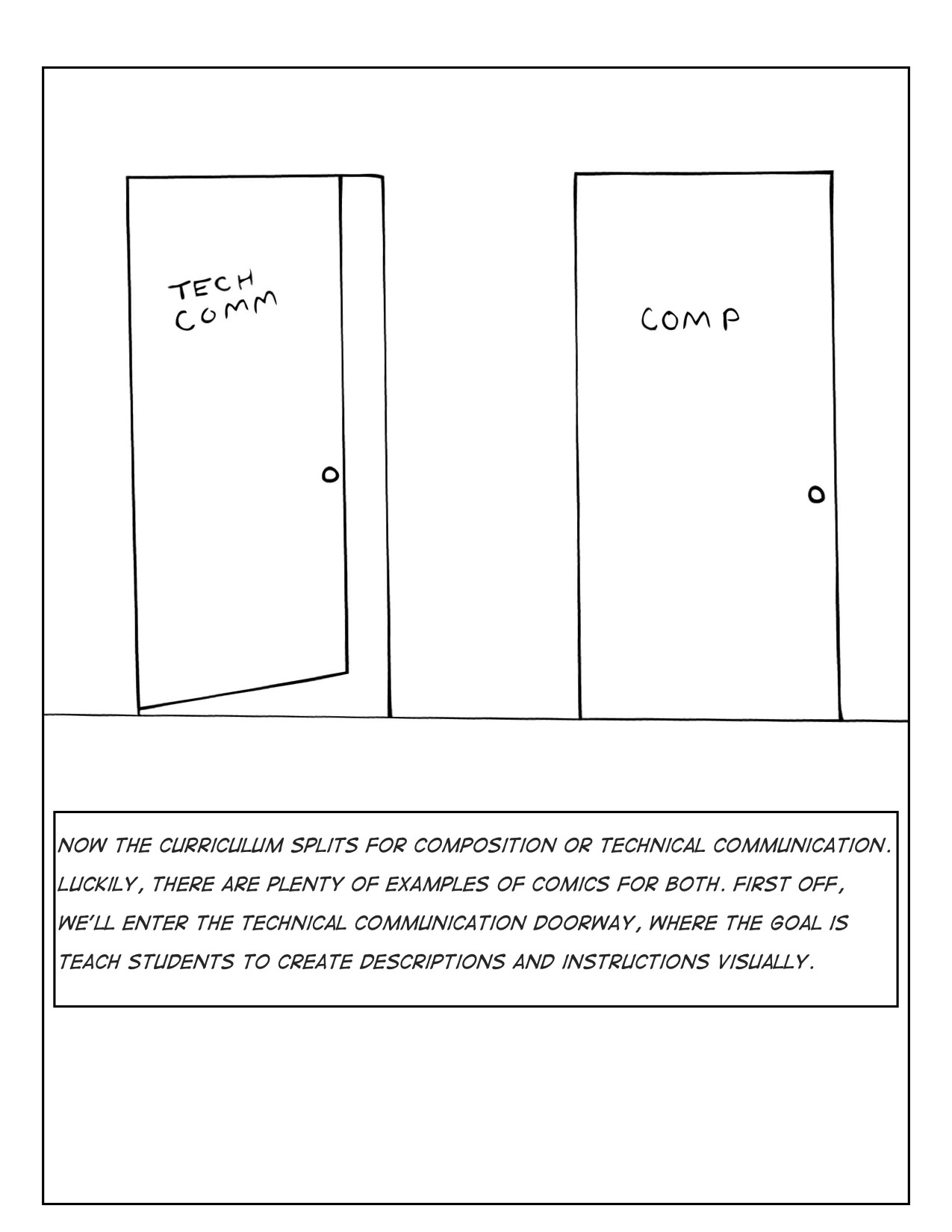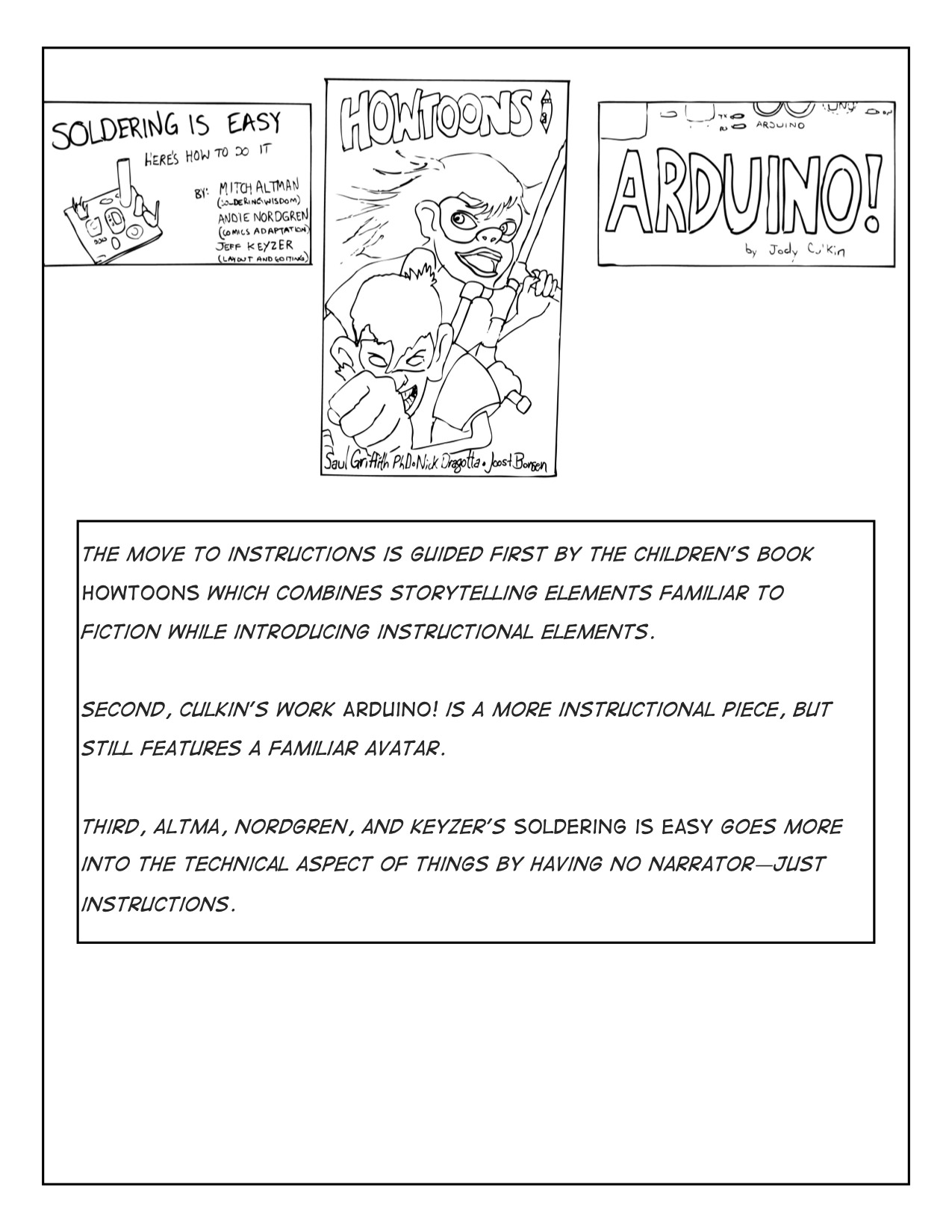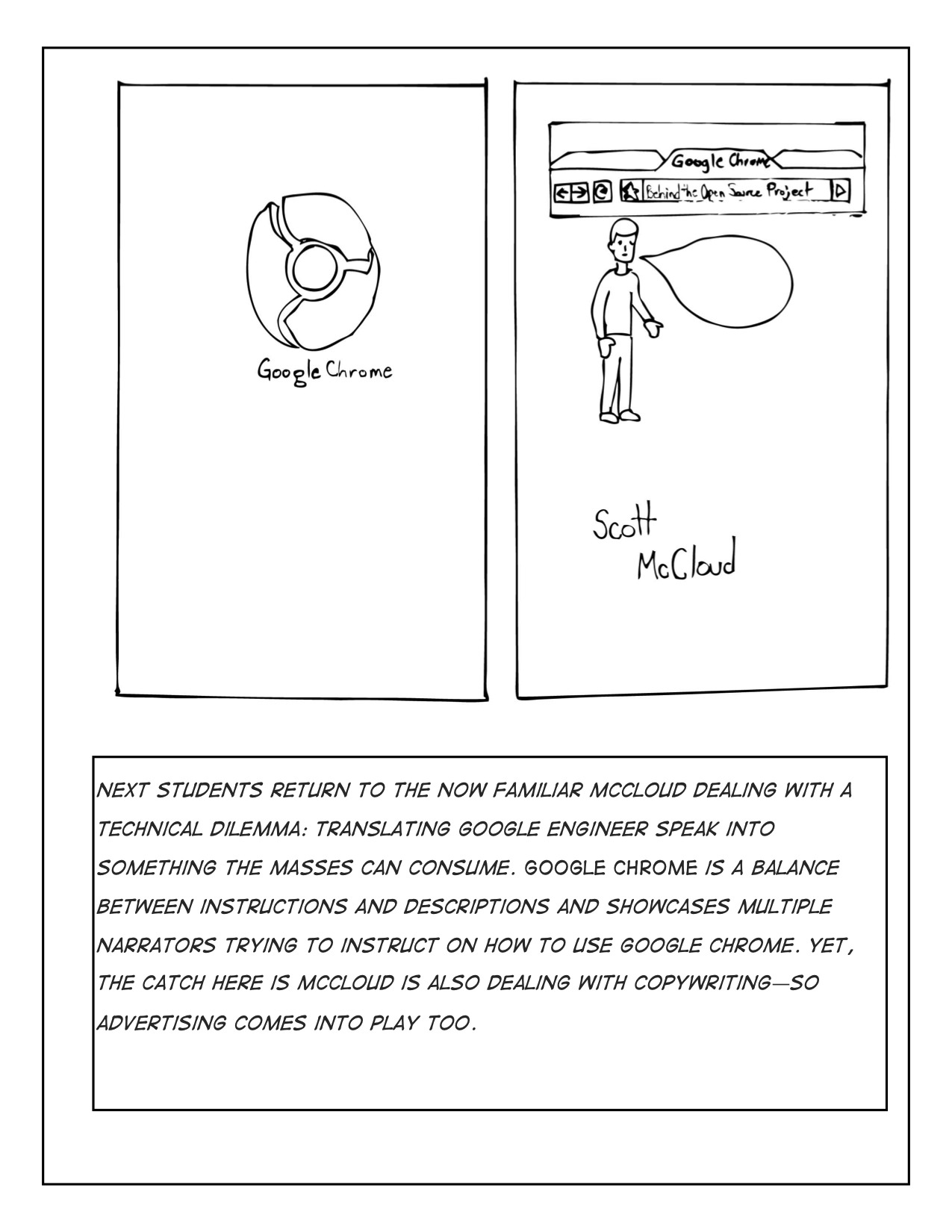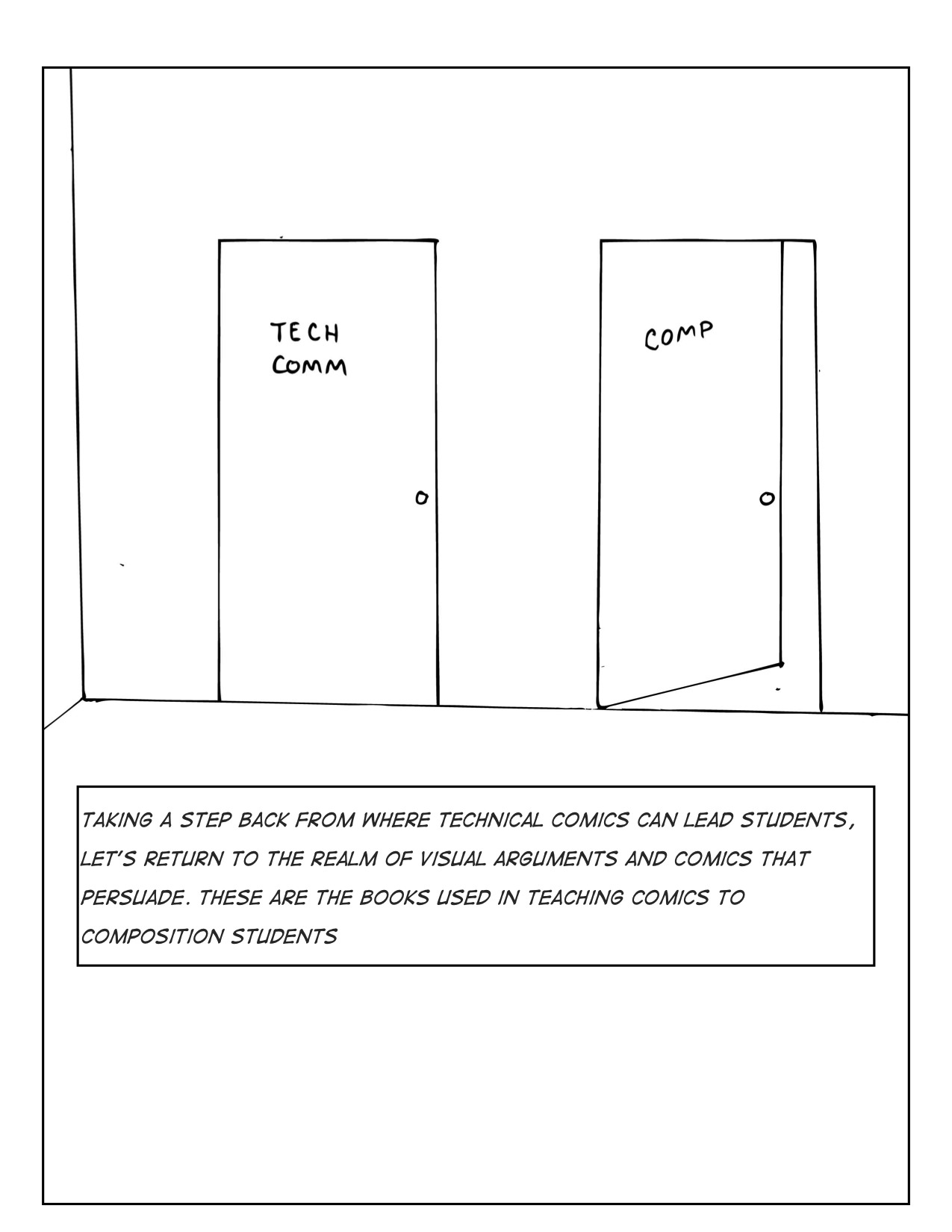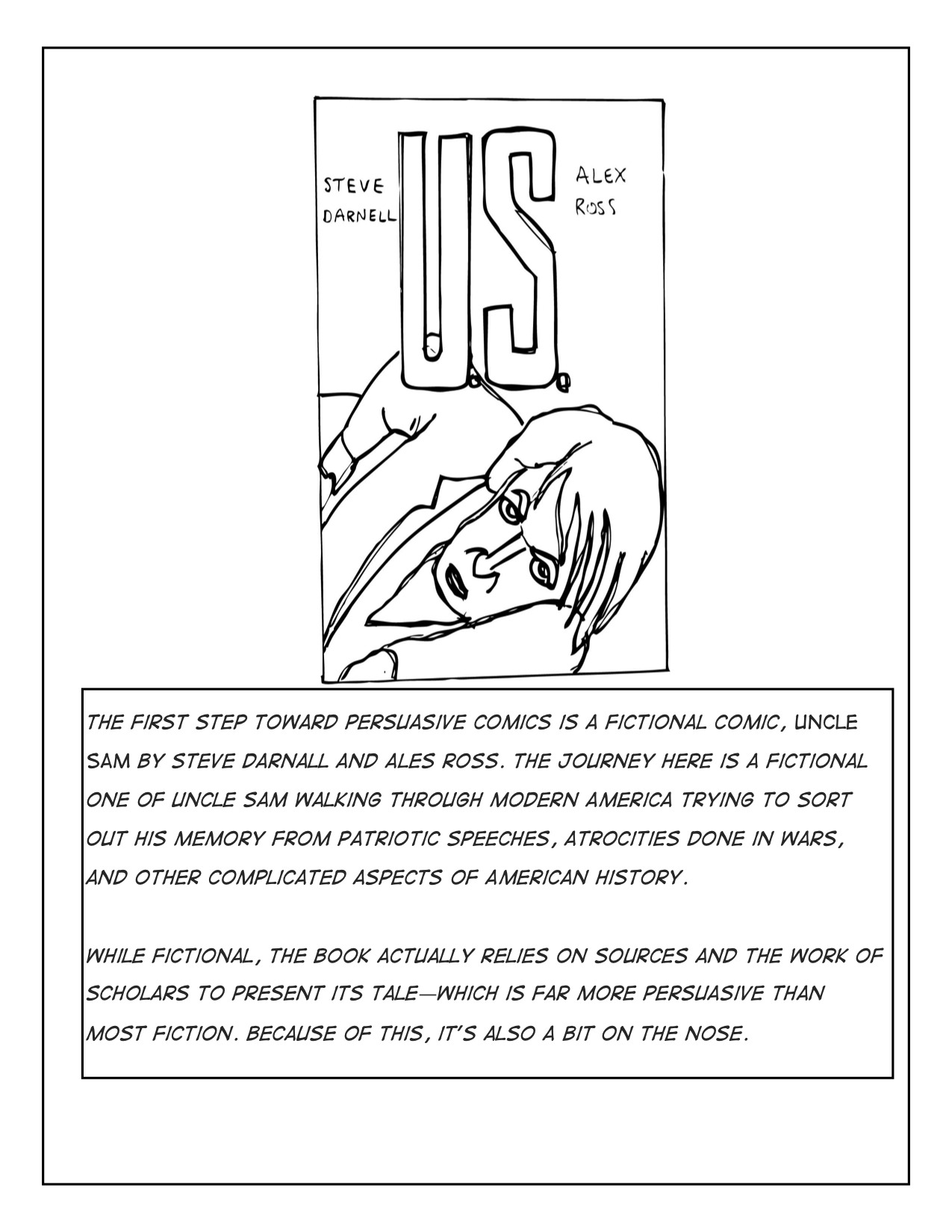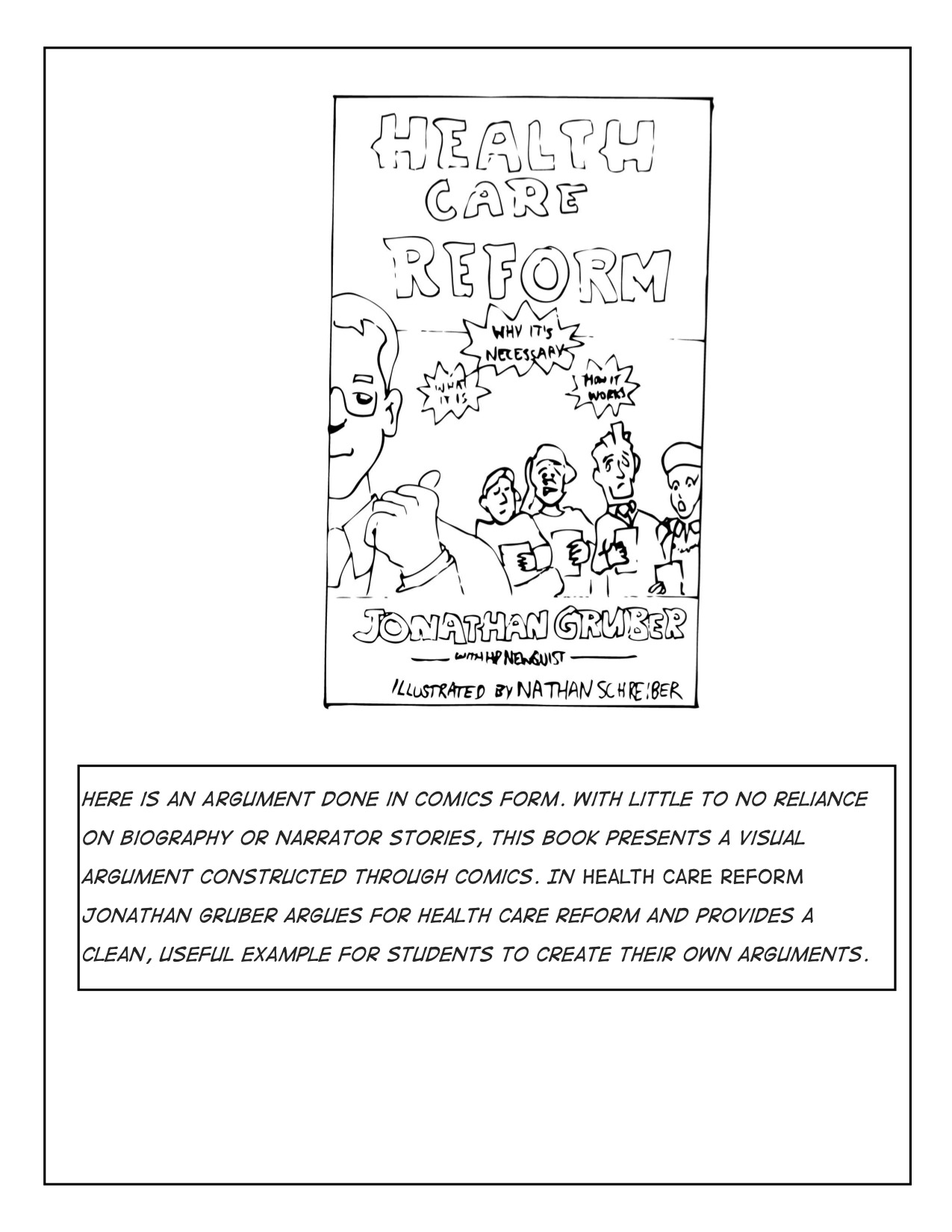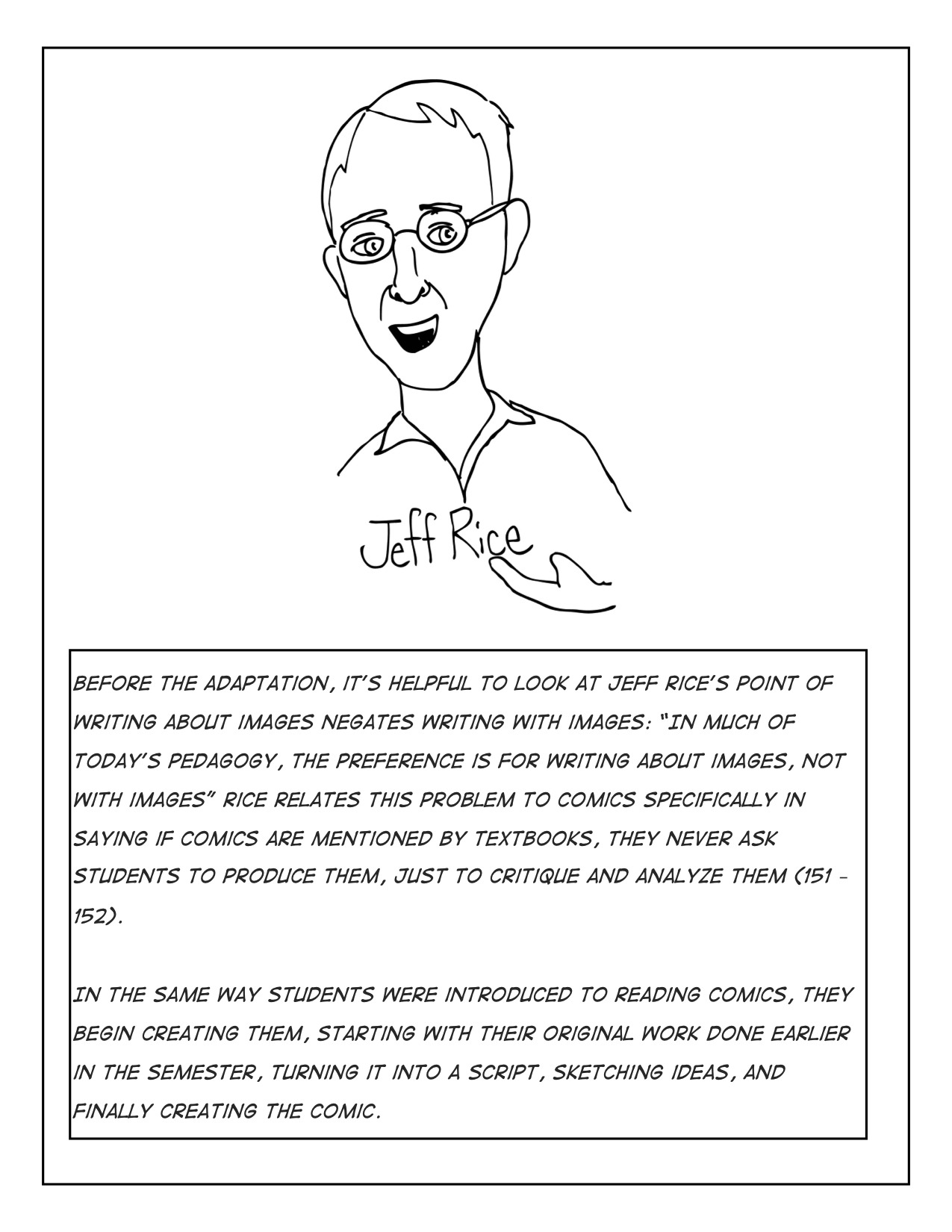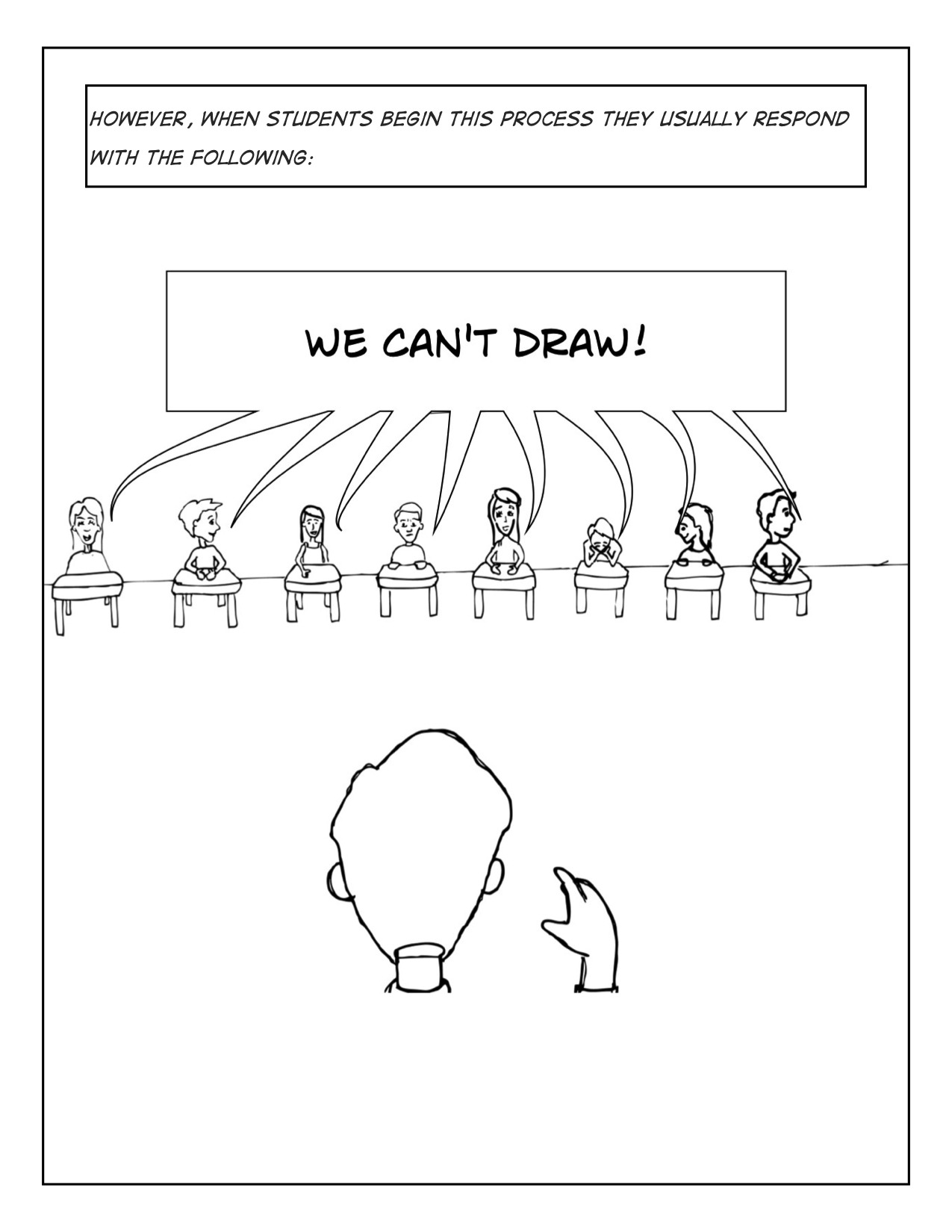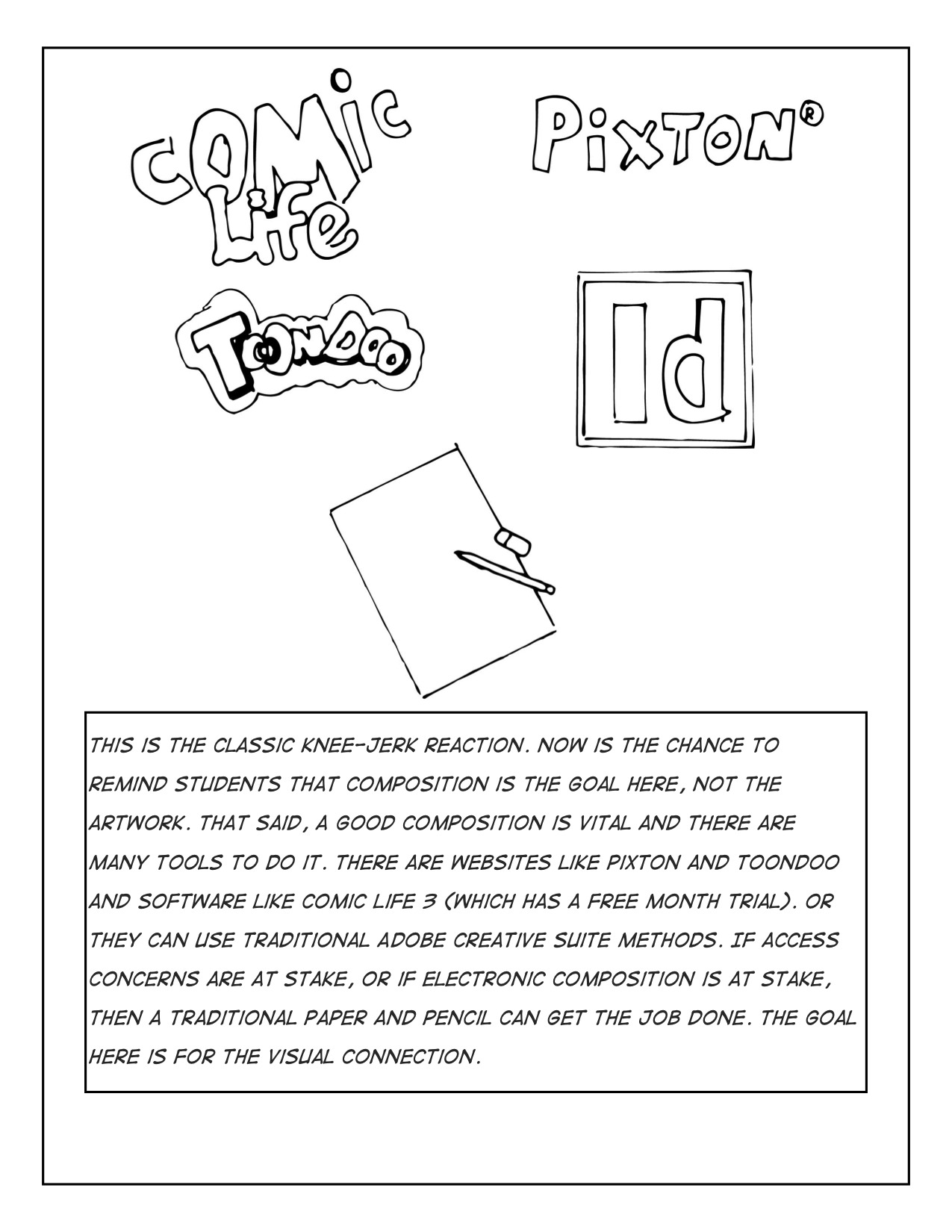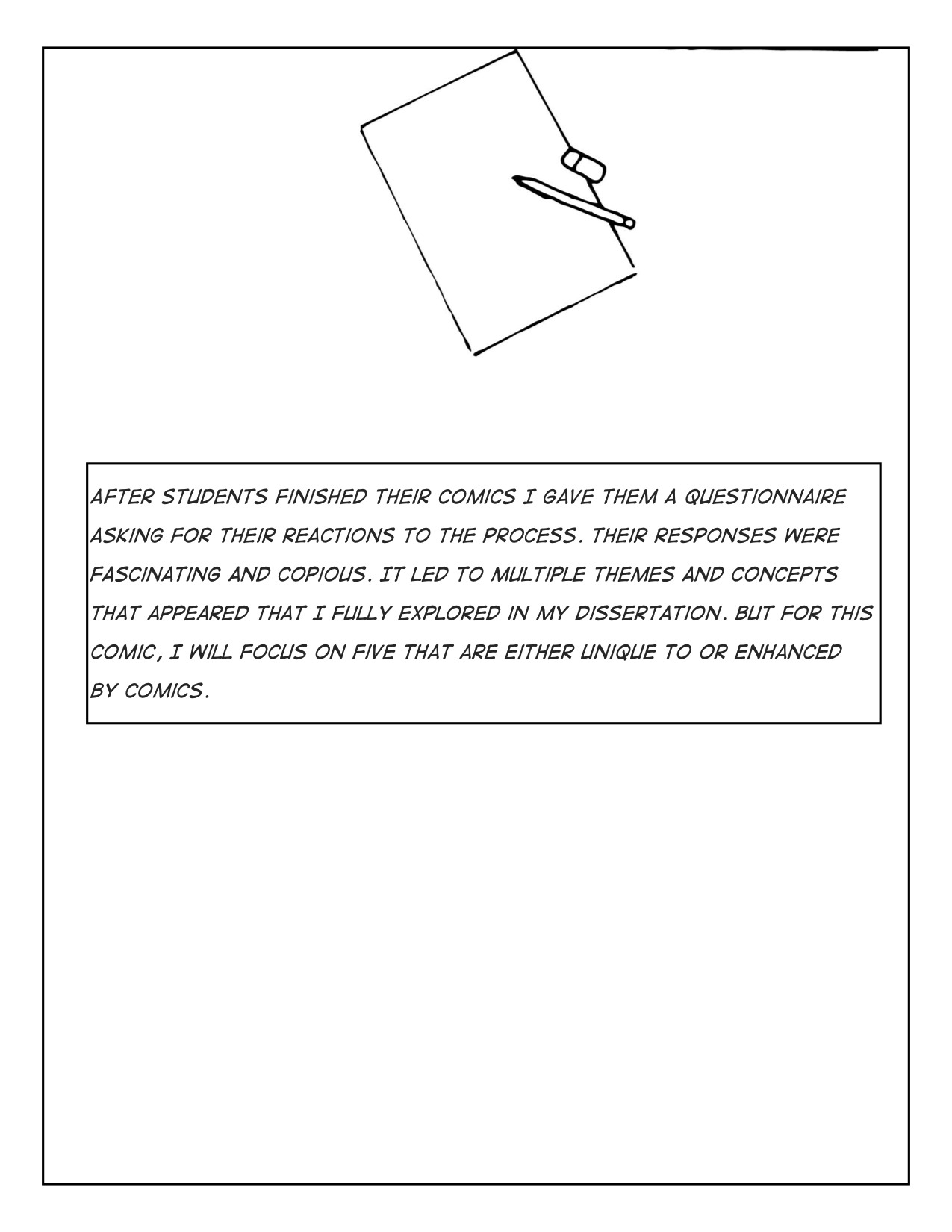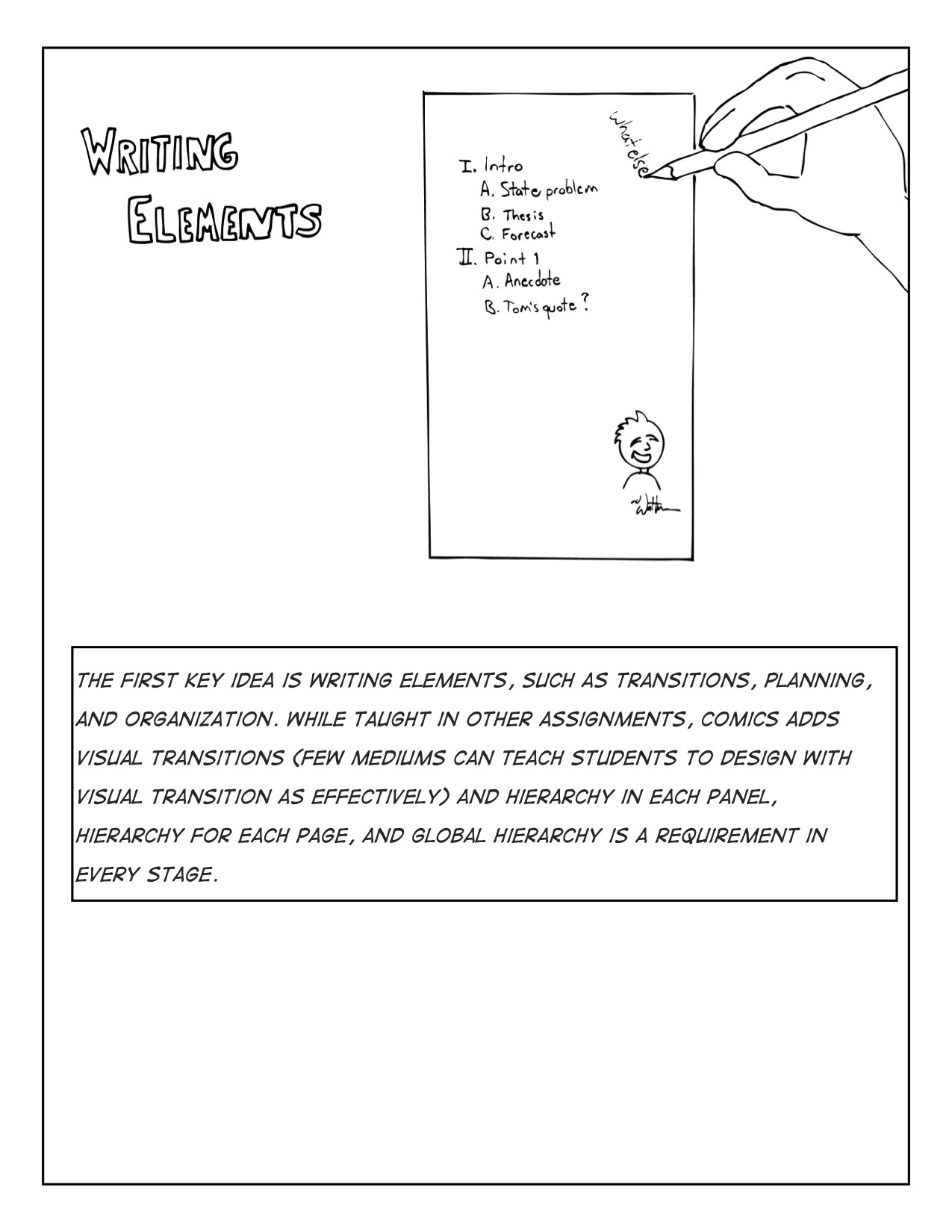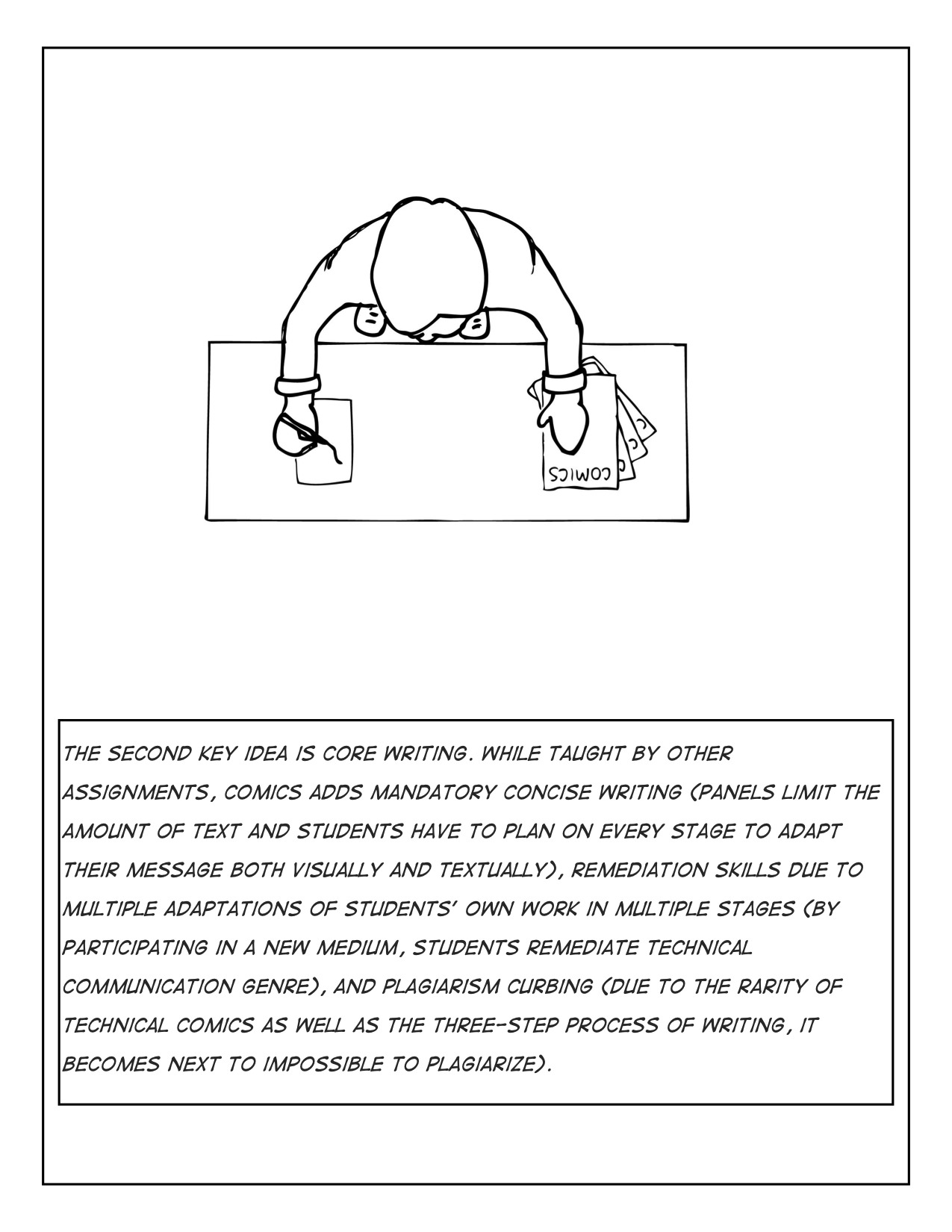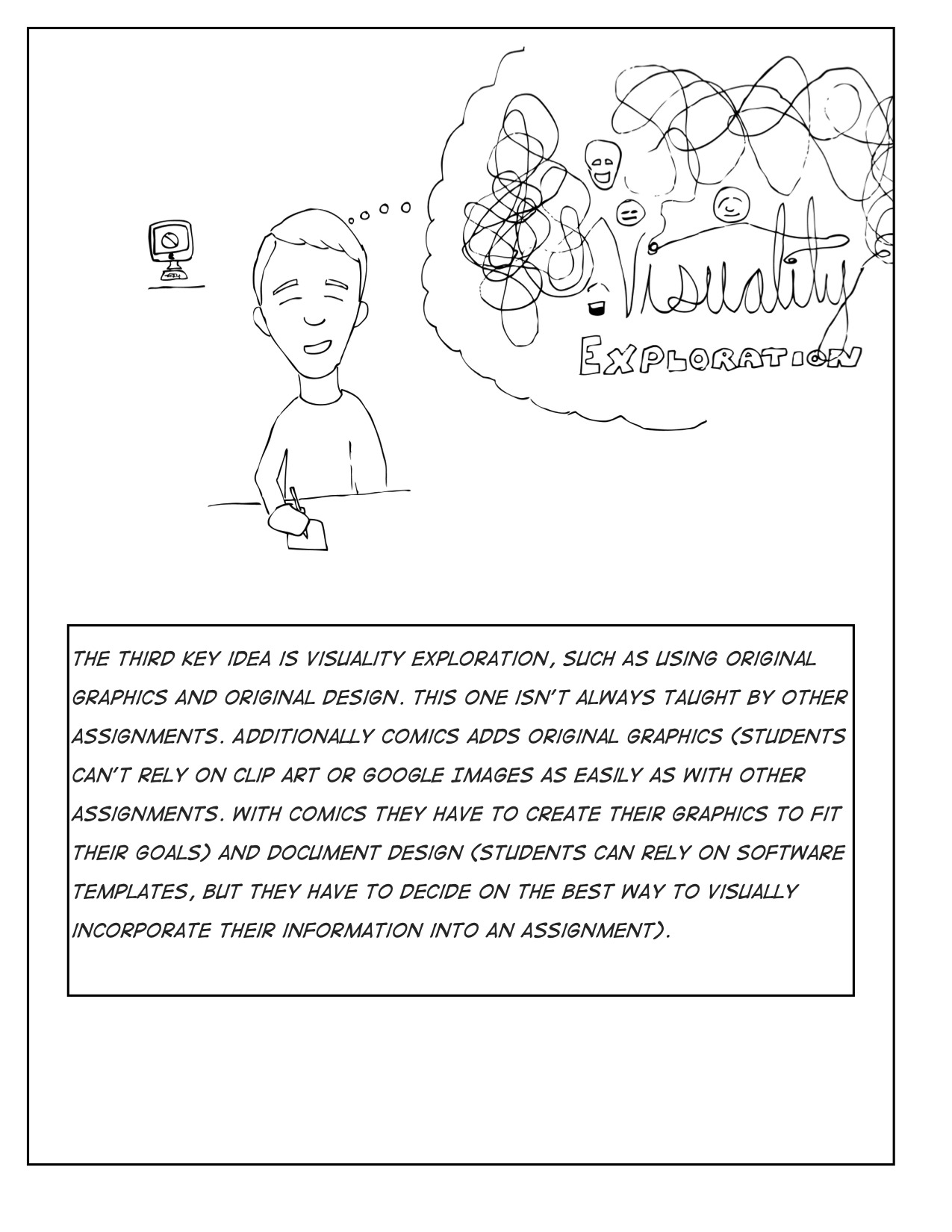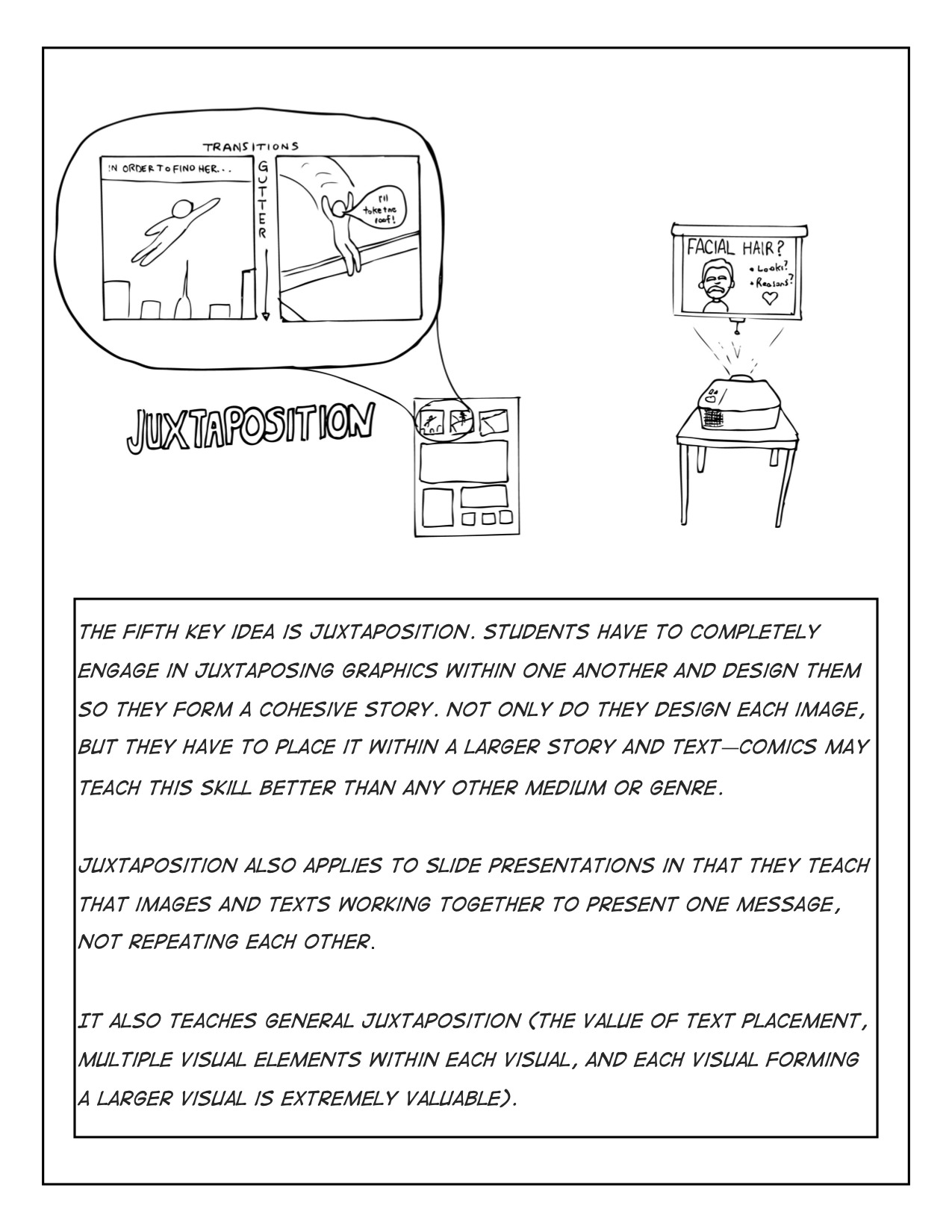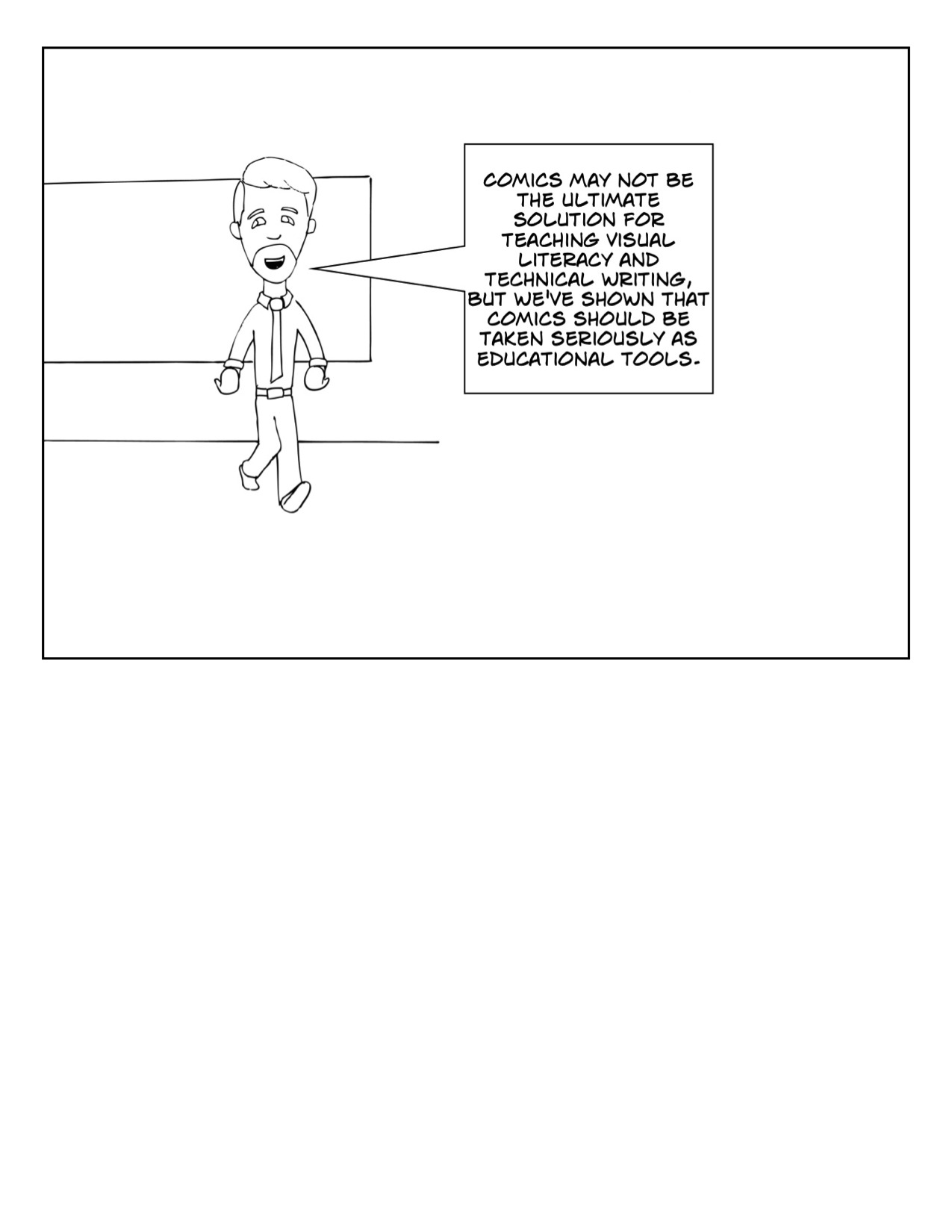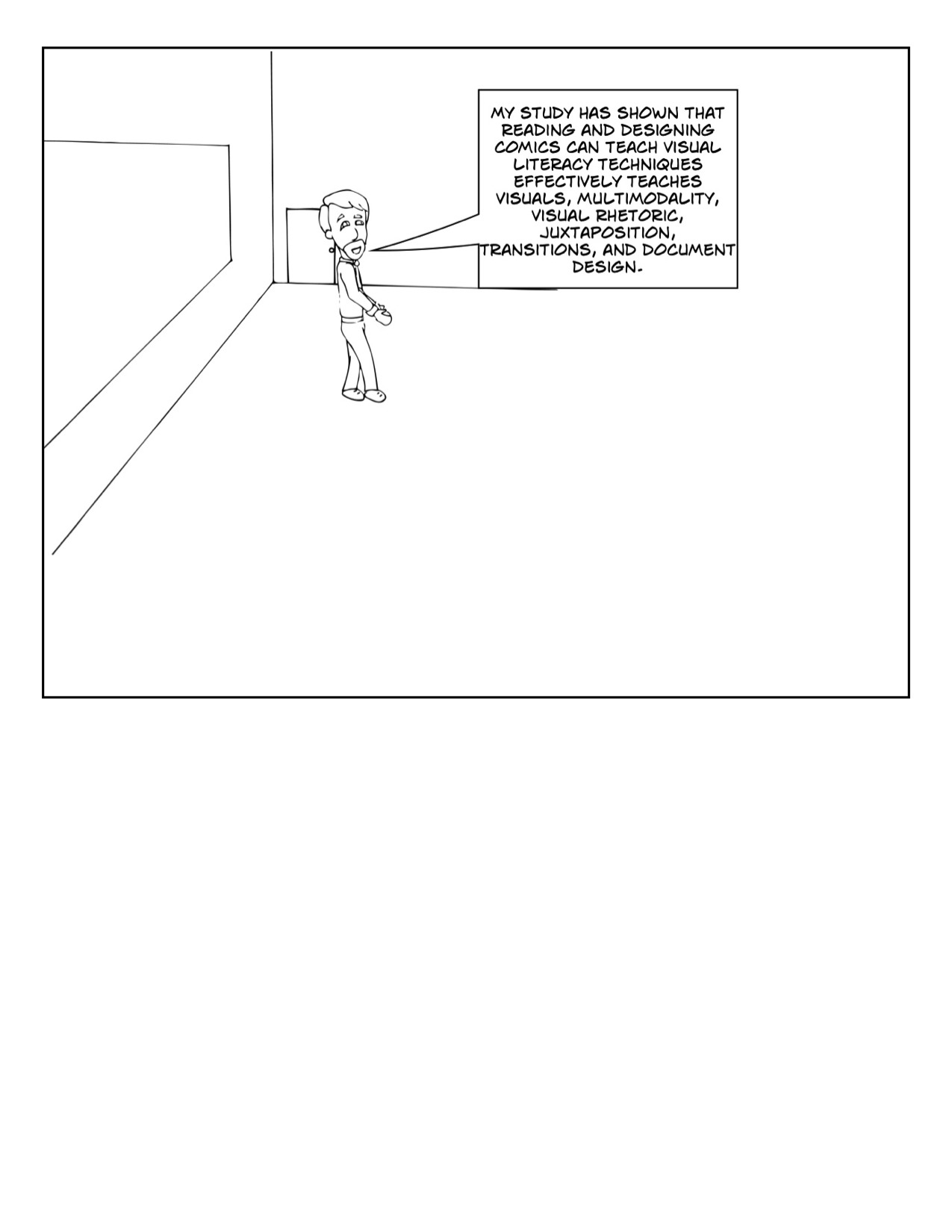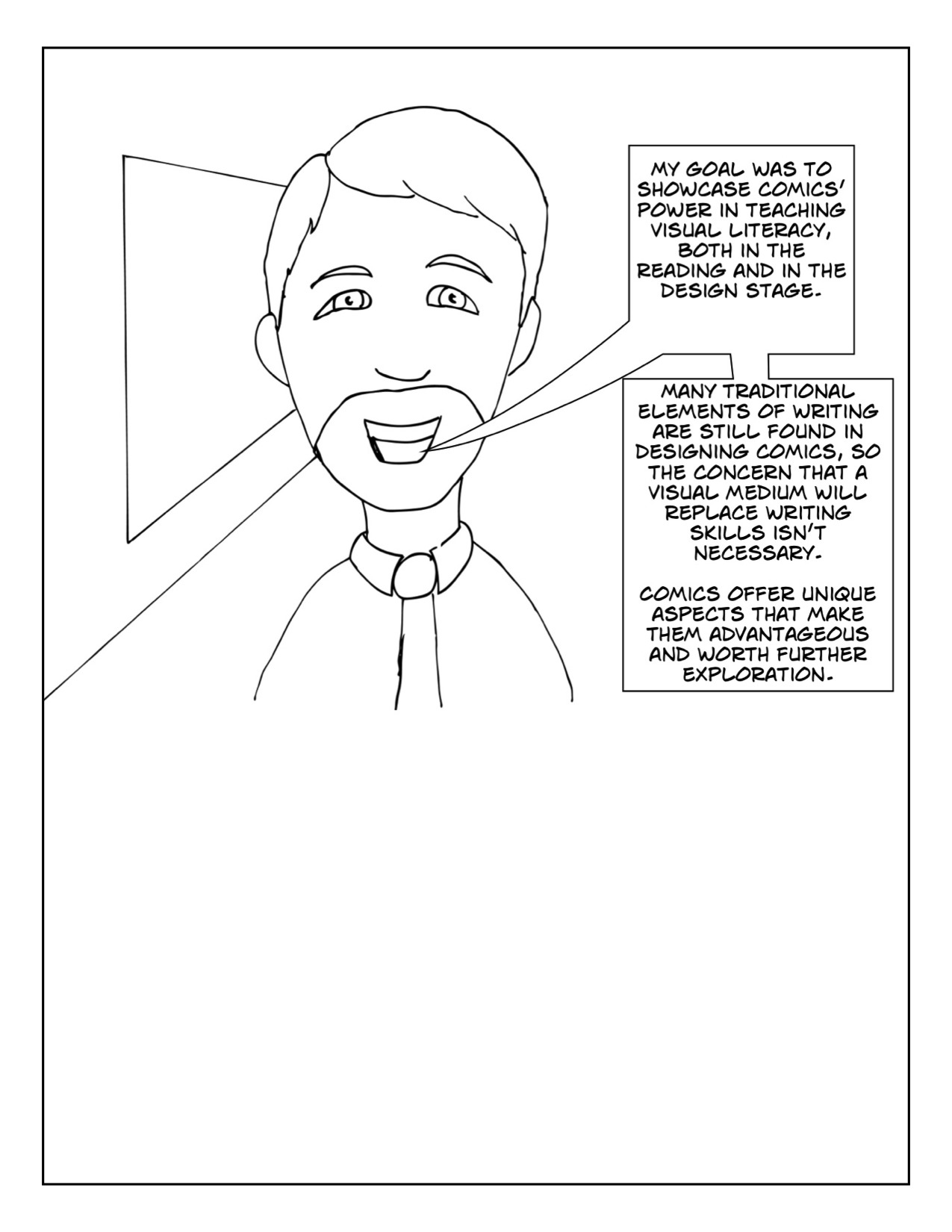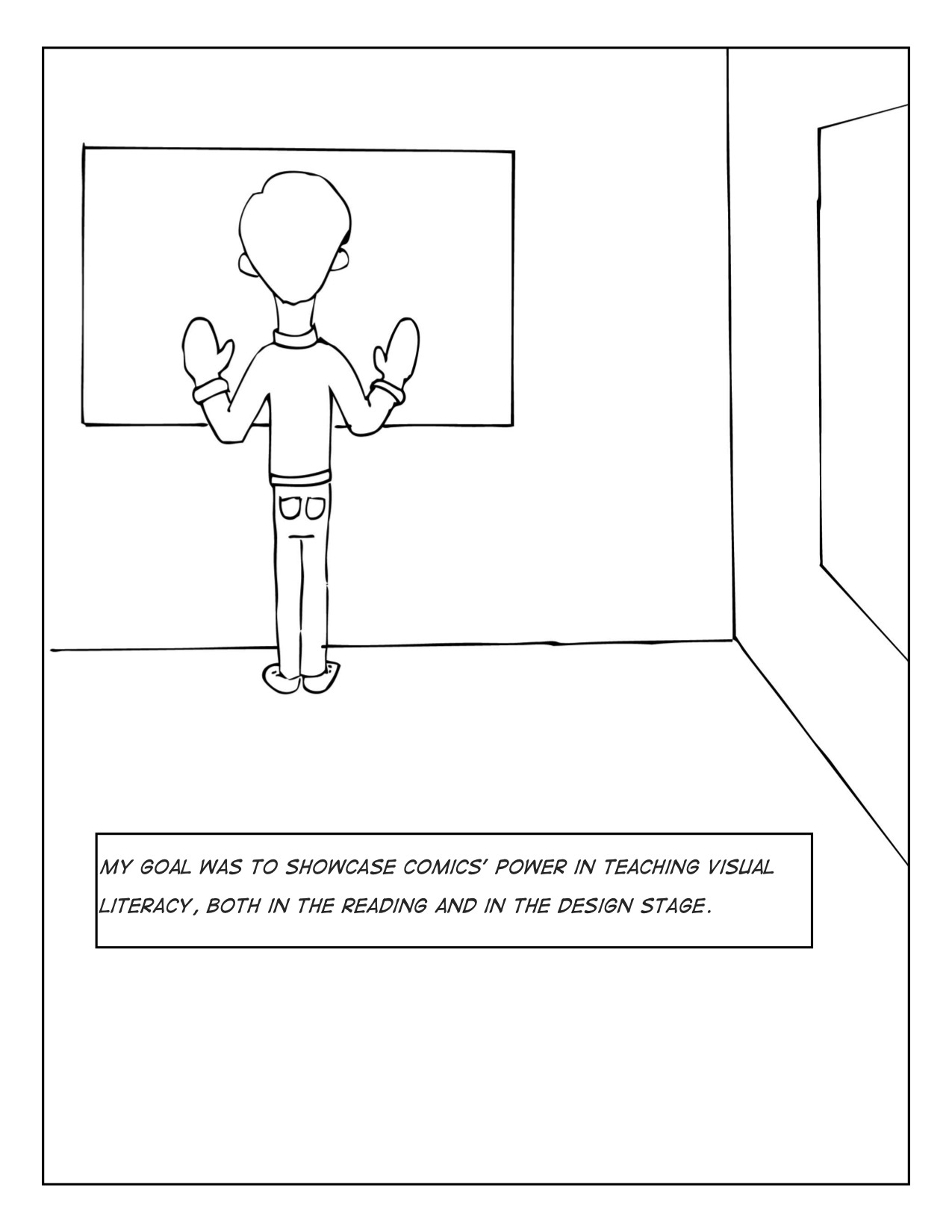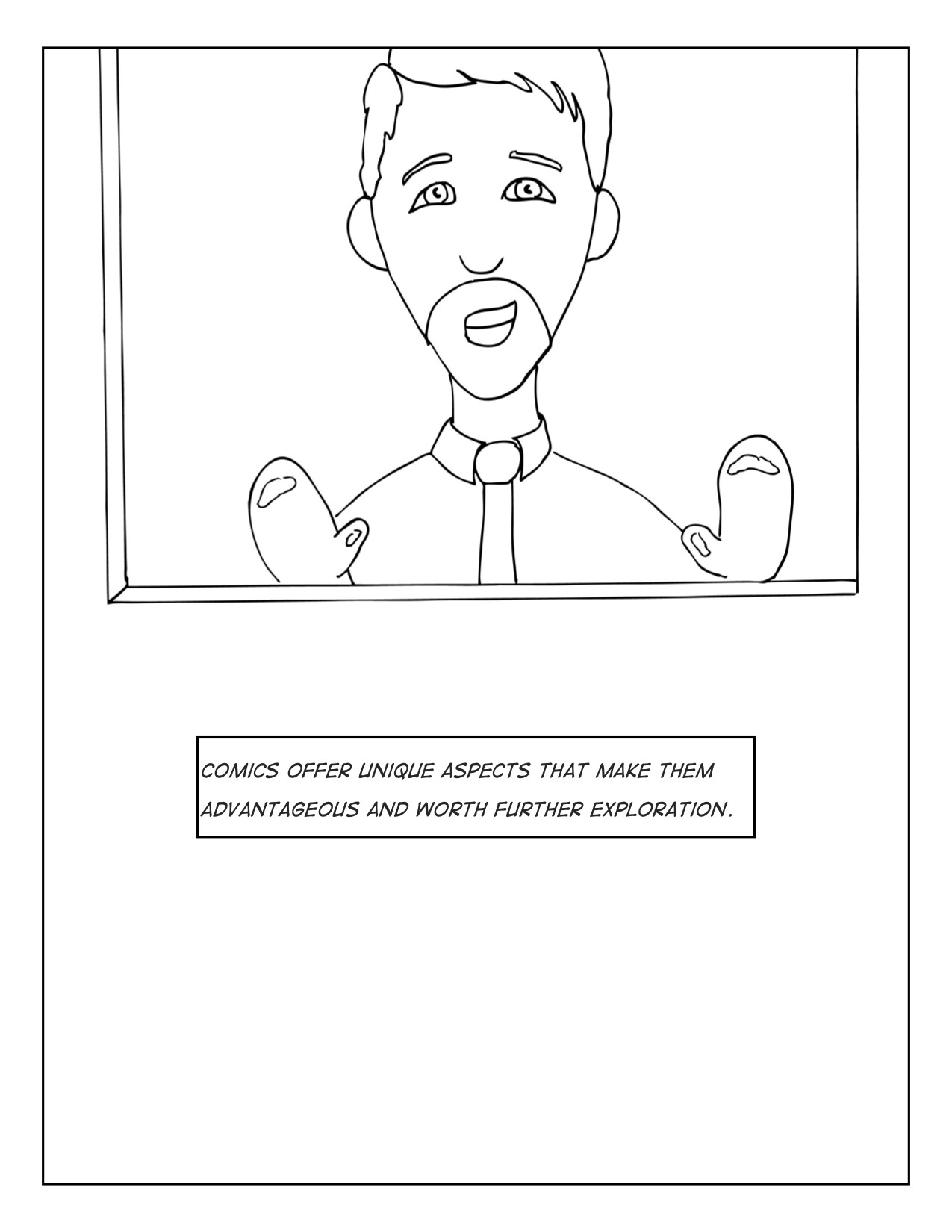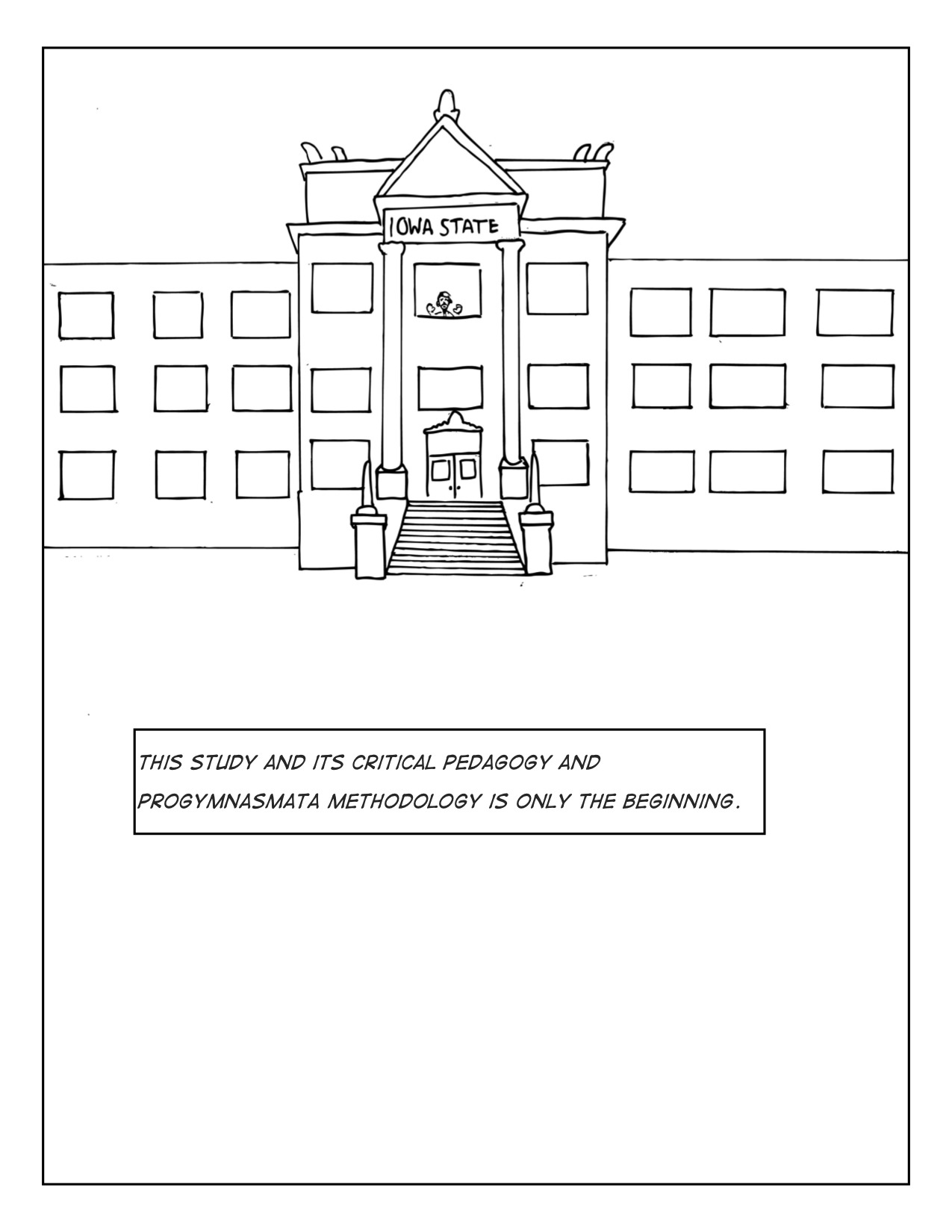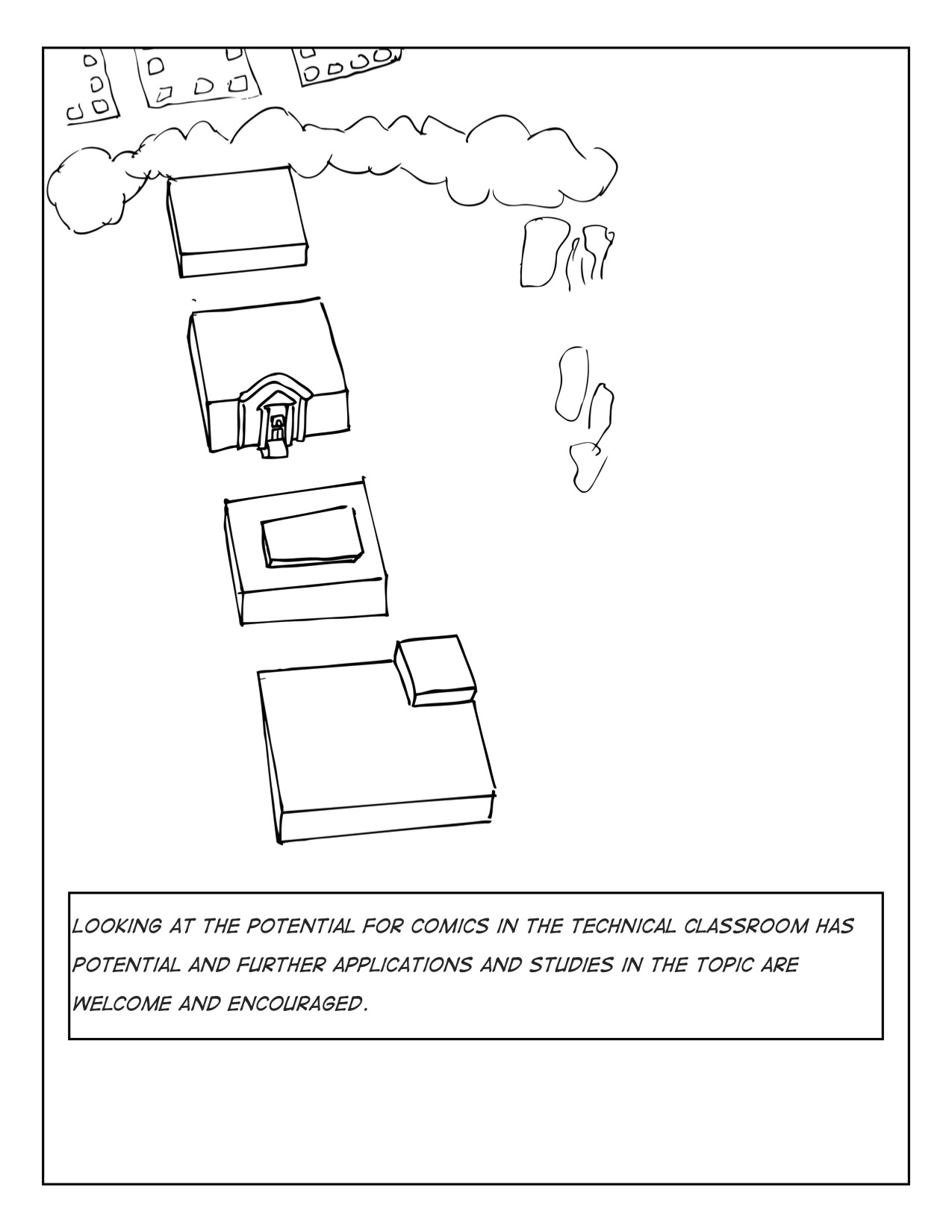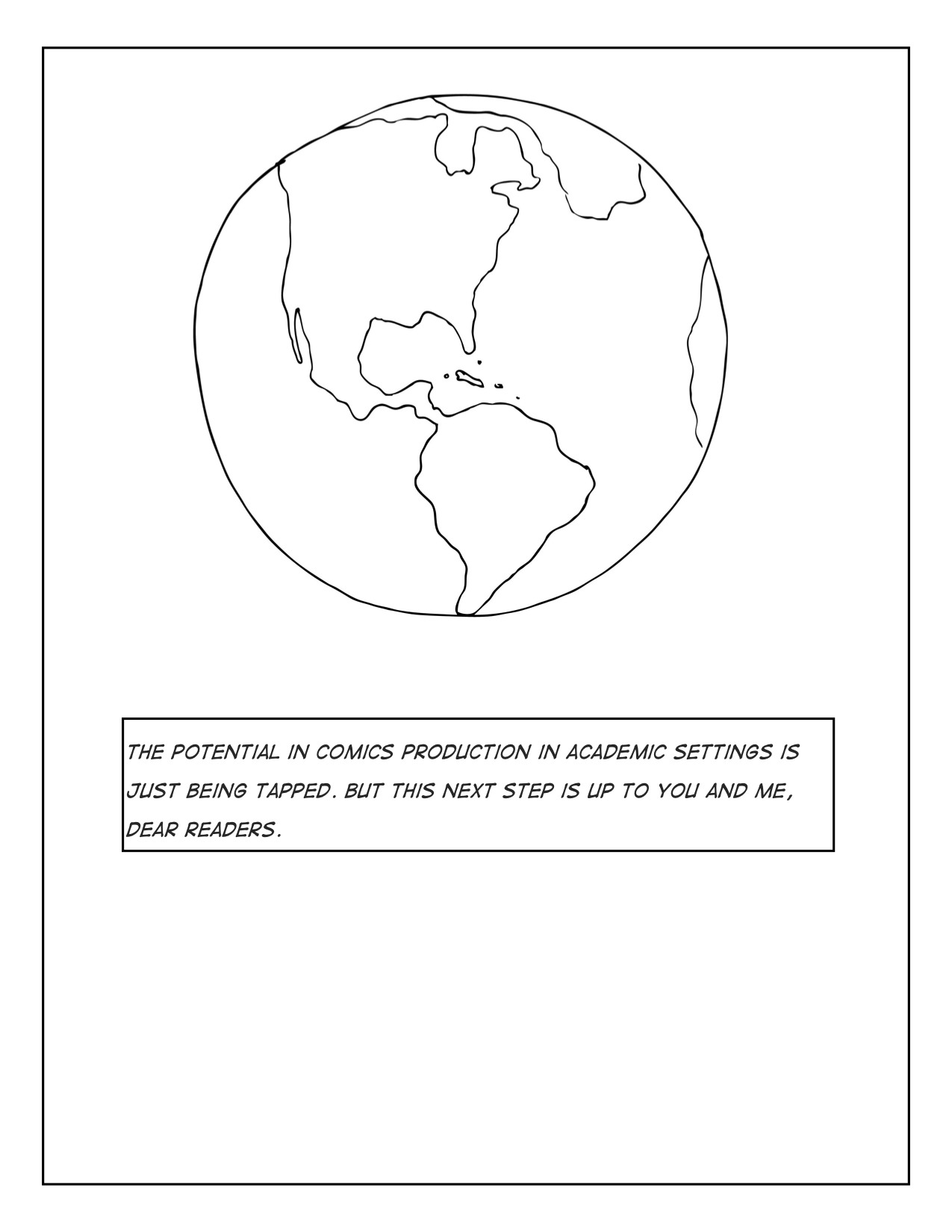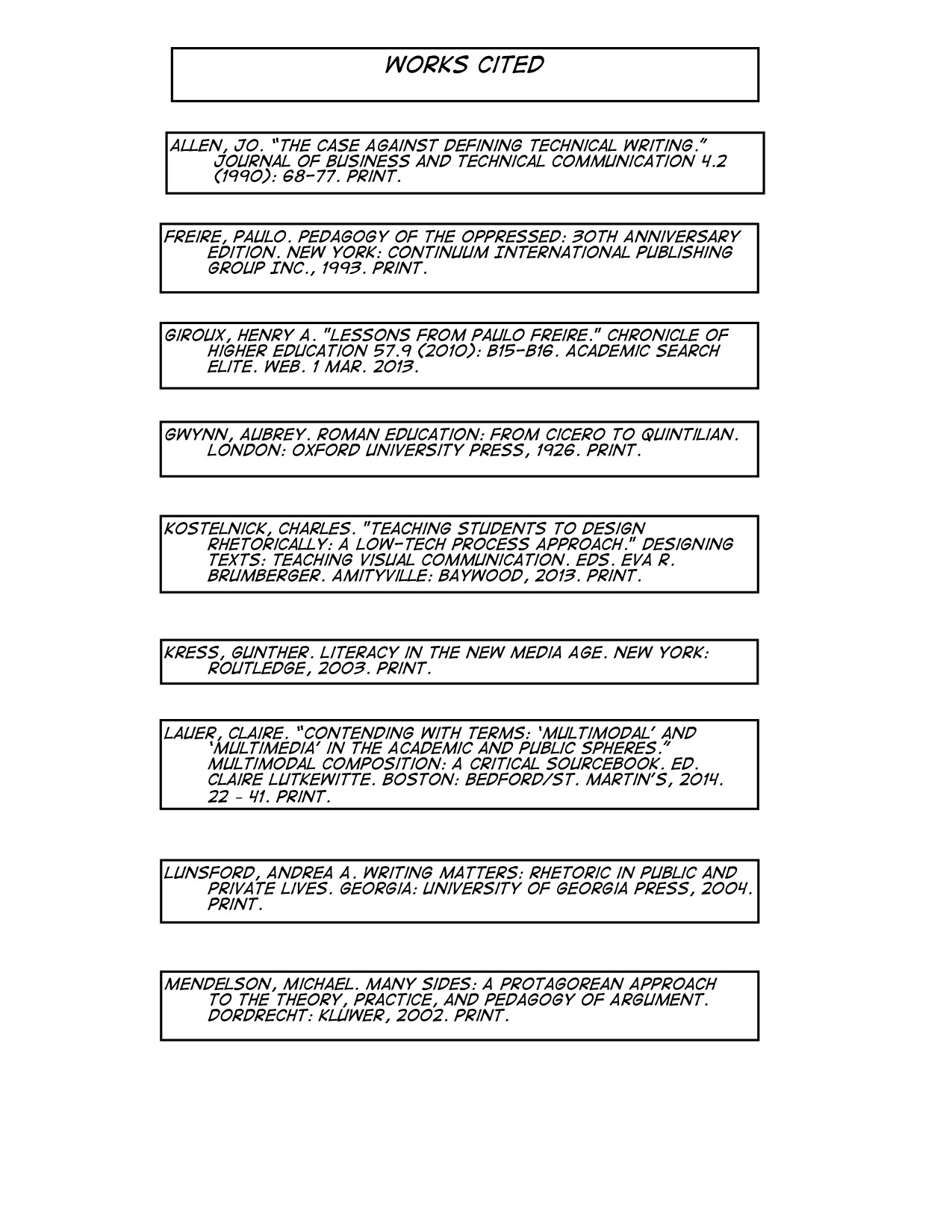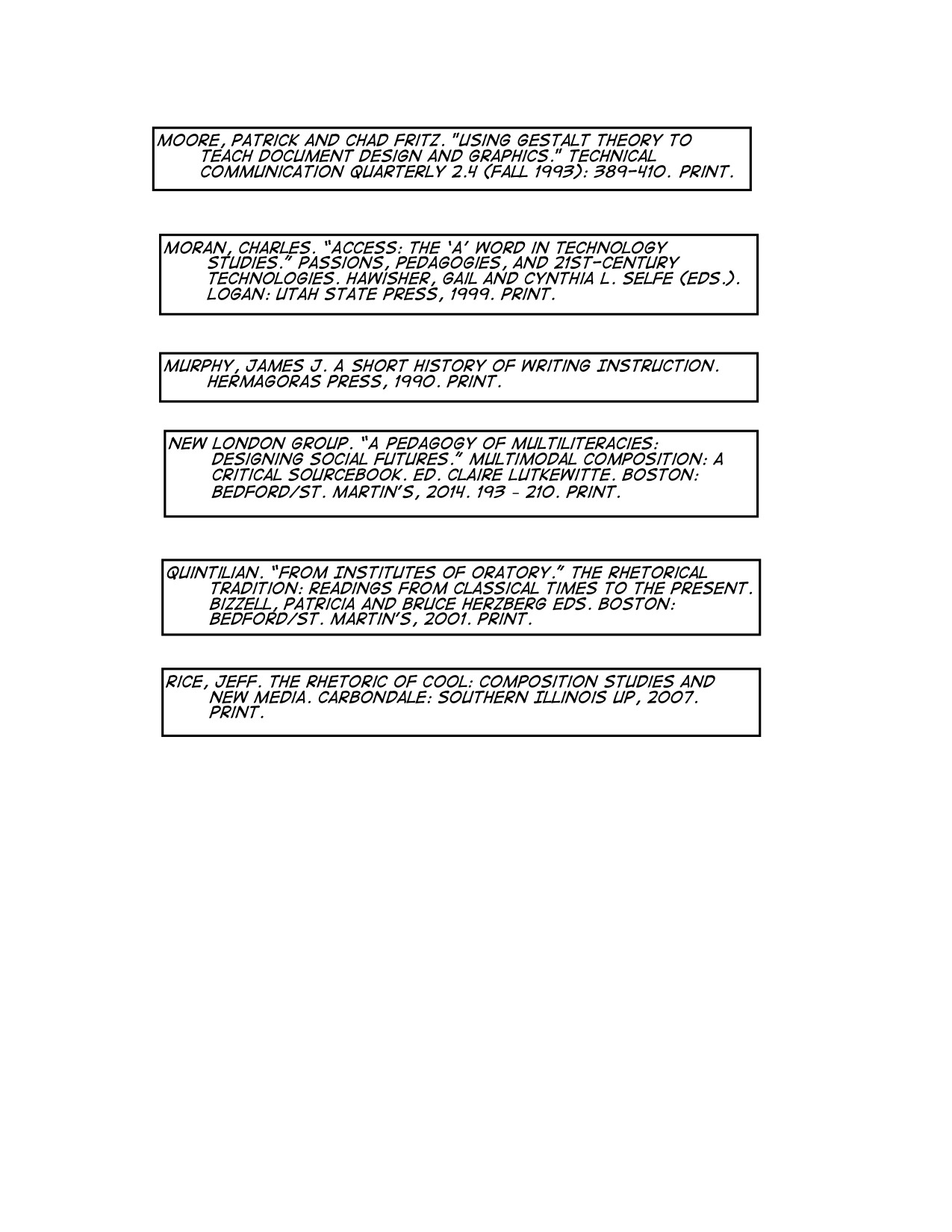Abstract
Our comic combines visual literacy, progymnasmata, and critical pedagogy to
showcase a classroom study that used comics production to teach visual literacy.
The comic first looks at comics criticism, visual rhetoric, and comics
scholarship to set a base to build a methodology build in critical pedagogy and
ancient rhetoric. Critical pedagogy’s tradition of inviting students to find
meaning in the origin of ideas fits in with having students design and study a
medium that’s often overlooked during their college experience. Such an approach
echoes Freire’s ideas of using critical strategies as an effective model for
change. Progymnasmata, and Quintilian’s work in general, allows students to
approach the new medium of comics through reading and production through an
ancient rhetorical practice that relies on a step-by-step process. Looking at
Quintilian's pedagogy, we demonstrate a modern classroom study that uses
progymnasmata to make the strange familiar while introducing visuality. The
actual study is briefly discussed as well. This amalgamation of ancient
rhetoric, comics studies, and critical pedagogy is the basis of the research
behind this pieces’ goal of exploring comics as a multimodal means of
composition.
Creator's Statements
We decided to present our argument through an omniscient narrator that mimics the
tone and moves of the academic genre’s tones and invisible (and partially
objective) narrator. This means that instead of relying on a traditional avatar
like most comics do, it relies on academic writing and technical instruction
techniques (like Jody Culkin, Mitch Altman, Andie Nordgren, and Jeff Keyzer have
done), where the narrator occasionally shows up, but primarily lets the findings
and arguments do the work. That said, the teacher that bookends the story serves
in many ways as the narrator as do some of the characters.
Ideally, our comic would have been done by an artist, someone like Jeff Lemire,
Emily Carroll, Alex Ross, Scott McCloud, Richard McGuire, Seth, Kate Beaton,
Vitaly S. Alexius, Hope Larson, Gabriel Rodriguez, or any other talented artist.
However that defeats the purpose of our argument: that students and instructors
can engage in the comics medium and gain from its affordances. This is why the
art relies on a simple style based in examples of the medium, but done with
inadequate art training. However, this isn’t a weakness; instead it embodies the
call of the paper to get students and scholars to write visually no matter the
skill level involved.
Original Contribution of Work
The goal of many contemporary compositionists, rhetoricians, and
professional/technical communication scholars is to incorporate multimodal
elements and visual rhetoric into the classroom. Research in this area, as
well as the desire to use multimodal texts, is nothing new or unique, but
the practice itself has been adopted slowly. Many reasons for this exist:
courses are already brimming over with content, competing mediums don’t
carry sufficient academic weight, and accessibility concerns abound. These
are legitimate critiques; multimodality is complex and taxes an already
crowded composition and technical communication field. Yet, a simple form of
multimodality already exists and has legitimate research to support it —
comics. Comics is a medium capable of handling many genres and incorporating
comics as a form of multimodality in research, composition, rhetoric, and
professional communication is a practice that is simple. Since publishing in
comics is usually not at option, in order to justify the analysis and
creation of comics in the classroom — and in turn, academia — one can turn
to established practices, in particular, critical pedagogy and the ancient
rhetoric practice of progymnasmata.
Comic Studies
Comics in academia isn’t a new idea either, though it’s usually limited to
being the subject of rhetorical analysis in published articles or as a
catalyst for analysis in the classroom. If it’s used as a means for
composing or creation, it’s primarily for reflective and autobiographical
writing. These approaches are helpful and important, but comics can be used
in other academic formats, including peer-reviewed research. Comics use
rhetorical skills to teach important lessons and students can compose with
comics to create arguments and instructional texts. In the process of
composing with comics, students learn visual rhetoric and effectively
realize multimodal writing. This isn’t the end though. Teaching students to
compose with comics is the first step toward arguing that comics can be a
means of publishing research in addition to the traditional essay.
Comics studies is a steadily growing trend in academia across multiple
disciplines. The medium was once considered merely pulp-art or a children’s
genre (and in some audiences still is), but many scholars (both in popular
culture and in academia) have worked for years to show its potential and
depth. Research has already been done proving comics’ usefulness in the
classroom (from elementary to higher education) as a medium to teach from
and to analyze. Although many have argued for comics’ positive influence,
and there are comics that have been accepted as textbooks and readers (see
McCloud; Losh, Alexander, Cannon; Gonick; etc.), the majority of instructors
and scholars are either unaware such a movement exists, indifferent to the
movement, or unconvinced it’s legitimate.
Important and Academic-esque Comics
Usually titles like Maus, Persepolis, or any of McCloud’s non-fiction work come to mind
when serious comics are mentioned. These are a great start, but they are
only the surface of many more works that deserve further exploration. The
non-fiction genres that stray from memoir and lie on the margins of academic
scholarship are a great place to start. These pieces include Colon and
Jacobson’s 9/11 pieces (the first a graphic adaptation of the 9/11
commission report and the second a history of the wars that followed), the
journalism cartoon movement (including Sacco’s books), McCloud’s Chrome
instructions (and earlier work), Paul Buhle’s editorial work on multiple
academic-themed comics — including historical texts like Zinn’s adapted
People’s History — biographies, history
tomes, technical communication done in comics format (like Eisner’s work and
other instructional comics), post-modern philosophical debates like in
Logicomix, and the textbook Understanding Comics done in comics form (see
Losh, Alexander, Cannon). This is the line where entertainment and
scholarship blur, which are explored in the justification in our piece.
Comics, Progymnasmata, and Multimodality
Although the overall goal is to see the acceptance of comics as a means to
publish research findings (not to replace the essay format, but to be a
companion when appropriate), this piece focuses on the initial steps —
teaching the idea to students as a goal to teach visual rhetoric and
multimodality. This piece looks at a method of teaching that draws on
critical pedagogy, analyzes comics that read like scholarship, and has
students compose in that format. Critical pedagogy’s tradition of inviting
students to challenge the authority and looking below the surface level to
see where meaning lies fits in with the idea of having students compose in
and study a medium that’s often overlooked during their college experience.
Such an approach echoes Freire’s ideas of using critical strategies as an
effective model for change. He writes, “the teacher presents the material to the students
for their consideration, an re-considers her earlier considerations as
the students express their own”
[
Freire 1993, 81]). In order for an acceptance of new
media and mediums to occur, it’s often necessary to engage students in the
process of discovering. Empirical evidence based on students’ experiences
can provide valuable evidence to support the bigger goal of having the
larger academic community accept such a medium as a way to compose
arguments.
Progymnasmata, and Quintilian’s work in general, make up another significant
section of our piece. Combining ancient rhetorical pedagogical practices
with comics studies hasn’t been explored. In addition, this piece draws on
critical pedagogy concepts of otherness and oppression, in this case making
a literal observation of the inherently “other” medium of comics
compared to the safer essay and textual pieces. This amalgamation of ancient
rhetoric, comics studies, and critical pedagogy is the basis of the research
behind this pieces’ goal of exploring comics as a multimodal means of
composition.
Works Cited
Moran, Charles. “Access: The ‘A’ Word in Technology
Studies.”
Passions, Pedagogies, and 21st-Century
Technologies. Hawisher, Gail and Cynthia L. Selfe (Eds.). Logan:
Utah State Press, 1999. Print.
Allen 1990 Allen, Jo. “The Case
Against Defining Technical Writing.”
Journal Of Business and Technical Communication 4.2
(1990): 68-77. Print.
Freire 1993 Freire, Paulo. Pedagogy of the Oppressed: 30th Anniversary Edition. New York:
Continuum International Publishing Group Inc., 1993. Print.
Giroux2010 Giroux, Henry A. “Lessons From Paulo Freire.”
Chronicle Of Higher Education 57.9 (2010): B15-B16.
Academic Search Elite. Web. 1 Mar. 2013.
Gwynn1926 Gwynn, Aubrey. Roman
Education: From Cicero to Quintilian. London: Oxford University
Press, 1926. Print.
Kostelnick2013 Kostelnick, Charles. “Teaching Students to Design Rhetorically: A Low-tech Process
Approach.”
Designing Texts: Teaching Visual Communication.
Eds. Eva R. Brumberger. Amityville: Baywood, 2013. Print.
Kress 2003 Kress, Gunther. Literacy in the New Media Age. New York: Routledge, 2003.
Print.
Lauer 2014 Lauer, Claire. “Contending with Terms: ‘Multimodal’ and ‘Multimedia’ in the
Academic and Public Spheres.”
Multimodal Composition: A Critical Sourcebook. Ed.
Claire Lutkewitte. Boston: Bedford/St. Martin’s, 2014. 22–41. Print.
Lunsford 2004 Lunsford, Andrea A. Writing Matters: Rhetoric in Public and Private Lives.
Georgia: University of Georgia Press, 2004. Print.
Mendelson 2002 Mendelson, Michael. Many Sides: A Protagorean Approach to the Theory, Practice,
and Pedagogy of Argument. Dordrecht: Kluwer, 2002. Print.
Moore 1993 Moore, Patrick and Chad Fritz. “Using Gestalt Theory to Teach Document Design and
Graphics.”
Technical Communication Quarterly 2.4 (Fall 1993):
389-410. Print.
Murphy 1990 Murphy, James J. A Short History of Writing Instruction. Hermagoras Press, 1990.
Print.
New London Group 2013 New London Group.
“A Pedagogy of Multiliteracies: Designing Social
Futures.”
Multimodal Composition: A Critical Sourcebook. Ed.
Claire Lutkewitte. Boston: Bedford/St. Martin’s, 2014. 193 – 210. Print.
Quintilian2001 Quintilian. “from Institutes of Oratory.”
The Rhetorical Tradition: Readings from Classical Times to
the Present. Bizzell, Patricia and Bruce Herzberg eds. Boston:
Bedford/St. Martin’s, 2001. Print.
Rice 2007 Rice, Jeff. The
Rhetoric of Cool: Composition Studies and New Media. Carbondale:
Southern Illinois UP, 2007. Print.




